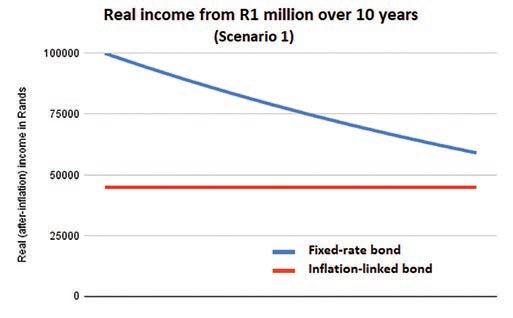

INTELLIGENT IMPACT THAT MATTERS







Who
planning professionals increasingly acknowledge that herein lies the future of personal advice. 8
36 When trusts go wrong
Experts relate case studies of how not to run a trust
39 Invest (and live) in Zanzibar Africa’s “Spice Islands” now open to investment
44 A tax guide for working across international borders
When you and your employer are in different countries
46 Starting a business Tips on business structure, tax, and succession planning
2 Upfront It’s personal
4 Book review
Books on financial topics
5 Your letters
Readers’ queries answered by experts
48 Millennial view
Four lessons in personal finance
50 Ombud case file
Insurance, advice and retirement fund disputes
52 Fund focus
MiPlan IP Global Macro Fund
54 On the contrary
Before you sell, have you considered your manager’s investment philosophy?

55 A list of the adjudicators and the ombuds who can assist you with your complaints, followed by the unit trust quarterly results, tax rates and annuity rates
The sponsored article by private wealth manager Melville Douglas on pages 34 and 35 ends with the words “it’s personal”, referring to the quality of client service on which the company prides itself. But without detracting from what Melville Douglas has to offer, I believe “it’s personal” has become the bar above which financial services companies will need to operate in the future to succeed.
The relationship between the industry and the consumer has been a rocky one. For decades, products and services were weighted in favour of the industry: the predominant business model, where you were persuaded to buy inappropriate products on the “advice” of commission-driven salespeople, put company profits before your interests.
There is still much room for improvement, but the “democratisation” of financial services – first through the proliferation of unit trust funds and more recently the rise of digital disruptors offering, among other things, quick-and-easy insurance and access to the stock market – forced the large incumbents and their adviser networks to bring you, the client, into the centre of their business model.
It goes further. Professional financial advisers and planners worth their salt are finding that “it’s personal” goes beyond putting you into appropriate products. There’s a psychological element to managing money and optimising your chances of building wealth. The adviser needs to act as a coach or mentor: holding your hand, educating you in the ways of investing and managing money, guiding you through difficult periods to prevent a knee-jerk response undoing years of good work.
Read Anna Rich’s well-researched article on page 8 to find out more about this new breed of advisers.
As always, the magazine contains articles on a diverse array of financially related topics for your information and edification.
Enjoy the read.
AnIndependentMedia (Pty)Ltdpublication
Editor
ANA Publishing CEO
ANA Publishing CFO
Head of Production
Head of Design Designer
MartinHesse martin.hesse@inl.co.za

VasanthaAngamuthu SoorenRamdenee
MugamadJacobs
MatthewNaudé
ThabangBoshielo
ADVERTISING
TonyMalek tony.malek@anapublishing.com
SUBSCRIPTIONS subscriptions@anapublishing.com
OFFICE MANAGER
CarynWessels caryn.wessels@inl.co.za
IMAGERY Freepik.comandAP
INDEPENDENT MEDIA BOARD OF DIRECTORS Dr.MohammedIqbalSurvé,TakudzwaT.Hove, AzizaB.Amod,IsmetAmod,YuexingWang,JinghuaDong
EDITORIAL ENQUIRIES
Tel:0214884187
Physicaladdress: Fourthfloor,NewspaperHouse, 122StGeorge’sMall, CapeTown,8001

Postaladdress: POBox56,CapeTown,8000
Personal Finance magazine(ISSN1562-3750)is publishedbytheproprietors,IndependentMedia(Pty) Ltd,StarBuilding,47SauerStreet,Johannesburg,2001
All products appearing in PersonalFinance are available and all prices are correct at time of print, subject to change.



Author: Arnold Singh
Publisher: Beyond the Vale Publishing
Order the book from asinghfp@gmail.com (R200 + R100 postage)
Arnold Singh has an Advanced Post-graduate Diploma in Financial Planning from Free State University and a Masters degree in taxation from North West University. He was a financial planner for 17 years and lectured in wealth management to post-graduate students at the University of KwaZuluNatal. He has distilled his vast knowledge and experience of personal finance into this comprehensive book, which covers all aspects of daily money management and wealth creation.
Levels of financial literacy in South Africa are unacceptably low. This state of affairs has led to high levels of indebtedness among consumers and low saving rates, with the consequence that only a small minority of South Africans (the figure most quoted is 6%) are able to retire comfortably on reaching retirement age.
Singh writes in the opening pages: "Since schools, colleges and universities do not teach personal finance as a subject, investors are not equipped with the necessary
knowledge and skills to manage their finances wisely when they commence work and hence end up in debt, do not save and invest enough, and end up poor in retirement. This book is intended to fill this gap in their knowledge so that they become empowered to handle their finances in an informed and effective manner and so enjoy financial freedom..."
In an easy-to-read, accessible presentation, Singh covers financial planning, debt management, insurance, banking, investing for the long term, tax, medical cover, and estate planning, among other topics. I can think of few books on the market which give such a solid and practical grounding for money management in the home.
My one niggle, as an editor with some experience in page design, concerns the layout of many of the tables in the book, which, to my mind, need improvement regarding clarity and readability.
That said, the book makes an important contribution to addressing South Africa's financial literacy crisis and deserves to be widely read. – Martin Hesse

Author: Tania Weich
Publisher: Zebra Press
Retail price: R150
While a minority of financial planners suggest it’s better to rent a property and rather build wealth in the stock market, it’s generally acknowledged that owning a property provides a solid foundation on which you can build wealth. However, the property market is becoming more and more out of reach for first-time buyers – and this applies to countries such as the United States as much as it does to South Africa.
Tania Weich is emphatic: owning a home is not for the select few – as a young person at the start of your career, you can realise your dream of having a property
you can call your own.
Weich is a property finance specialist, having been in the property business since the age of 22, when she became an estate agent and bought her first home.
Having run her own real estate company for more than 10 years, she assists buyers from all over the world to buy property in South Africa.
Her book breaks down the seemingly complex process of buying a property into simple, logical steps that are easy to follow. It also highlights pitfalls to which novice buyers are prone. Forewarned is forearmed: Weich’s guide is a must-read for anyone entering the property market. – Martin Hesse
I’ve just started a company together with three other shareholders and we are currently mapping out the employee benefits. Has Covid-19 changed anything fundamental in this space? Given the current troubled health landscape of Covid-19, increasing mental illness rates and mounting financial pressure on staff, what are the key benefits that we should be focusing on to ensure a healthy, safe and productive environment?
Name withheld
John Cranke, PSG Wealth, Midlands, replies: Apart from the inclusion of vaccination, testing for and treatment of Covid-19 into the Prescribed Minimum Benefits for medical schemes, not much has changed from a legislative perspective for businesses wanting to extend employee benefits packages to their employees for the first time. However, the pandemic has definitely reinforced the importance of employee benefits, including the mental wellbeing and financial assistance/ coaching aspects you mention.
In order to craft a relevant employee benefits package for your company, we would need information relating to the type of business you are in, the number of employees and their occupations/incomes / demographics (gender/ age) and geographical spread.
We would generally recommend including the following benefits:
• Health insurance (primary healthcare)
• Medical scheme cover
• Gap cover
• Employee assistance programme (EAP)
• Group risk cover (death, disability and funeral benefits)
• Retirement funding
The fact that medical schemes are obliged to cover the Prescribed Minimum Benefits as set out in the Medical Schemes Act makes them unaffordable to many employees, and we therefore include health insurance cover to provide cover for primary healthcare (in a private setting) for those employees. The EAP offers cover to all employees for, among other benefits, the psychosocial wellness aspects that have become elevated during the pandemic. Depending on the size of the group, we would be able to negotiate favourable underwriting on your behalf with providers.
For the retirement fund and group risk benefits we usually propose a phased-in approach in order
to build both of these up to pre-determined (often negotiated) levels, to ensure appropriate, meaningful funding in the event of retirement, death or disability.
There are also several other considerations for you as an employer, including but not limited to:
• Who qualifies for what benefit/s? (including dependants)
• Will cover be voluntary or compulsory?
• Will the company subsidise and by how much?
Everything of the best in your new venture!
I’d like to invest money offshore. However, in this volatile market, it seems like too big a risk. What is the best route to take to ensure a safe return on investment? Name withheld
Pierre Puren, PSG Wealth, Jeffrey’s Bay, replies:
I’d suggest you start with the end in sight. Focus on your specific goal and add to that another factor you do have control over, time. By focusing on the uncontrollable factors (such as future growth, interest rates and politics), you’ll lose focus and run the risk of falling victim to short term “noise” and making emotionally driven decisions. It is well documented that certain asset classes outperform others, if one takes time into account. If your specific goal has a short term focus (less than two years), it’s best to consider investment into an asset class that will provide certainty, such as a money market fund. This means that when the time comes to withdraw your capital to address your need, you won’t be susceptible to market fluctuations.
Conversely, if your goal is to save for the long term (more than seven years), you could consider an investment into equities because your money should have time to overcome any short term volatility. Much research exists that proves equities provide inflation-beating returns over longer term periods.
Once you have identified these factors, the decision whether to invest now or wait (in a volatile market) becomes more or less irrelevant as your investment returns will be relatively certain given your needs and time horizon.
Note: These letters are selected from “Your Questions Answered”, a monthly feature in Personal Finance in the Saturday newspapers, sponsored by PSG Wealth.
Most of us are greedy, dreaming of an unrealistically high return on our hard-earned money.
To earn higher returns we must take on extra risk, but higher risk does not always result in higher returns. Just ask those who invested in African Bank to get a slightly higher interest rate or investors in Steinhoff who ended up with losses. On the other hand, to leave our money in cash at current interest rates means that we may think that we are earning a good return, but our money is losing value in buying power.
One of the saddest stories I recall is that of a relative who worked hard for many years and then retired, to live on the income from her investments. She was cautious and invested all her money in a savings account at a large and reputable bank, very prudently, or so she believed. She enjoyed good health and
lived in a lovely flat at the coast, living off the interest from her investments. All well until some 20 years later when the cheque for her flat levy bounced, and she was forced to sell her flat. She had been living off her interest, not realizing that inflation was destroying the value of her savings and after 20 years the capital had been depleted. Nobody wants to grow old, but even worse to be old and poor.
What is so important for the long term is to ensure that you are earning enough to stay ahead of inflation. My first car cost R2 000, new; today that car would be R150 000, a 75 fold increase. We have enjoyed a decade of moderate inflation in South Africa, but it does appear that our inflation rate may be spiking up, driven by the soaring oil and food prices, administered prices such as electricity and water, as well as the effects of supply chain disruptions. The USA has seen consumer inflation of 8.5% and Germany 7.4%, the highest levels since the 1980’s.
Given high debt levels in much of the world, it will be difficult to prop up economies through fiscal policy, while Central Banks will have to choose between propping up economies with cheap funding and the risks of higher inflation. The risk of recession next year is high. Anyone investing for the long term should target a return at least equal to inflation. The Sasfin BCI Stable Fund targets inflation plus 4% p.a. over the medium term, while aiming to keep the risk profile of the Fund moderate. This is done by investing in a prudent mix of selected shares, to a maximum of 40%, plus inflation protected bonds and other fixed income assets to keep the risk profile reasonable while earning a “good” return. The manager of the Sasfin BCI Stable Fund has been doing this for more than 30 years, through high and low inflation periods, and hopefully will continue to protect investors through what could be a turbulent period ahead.



There’s a new kind of financial advice offering that aims to optimise our financial behaviour. How does the financial coach fit in with the existing advisory framework? And how can they help you? By Anna Rich.

taken in financial planning, management and more. He had long recognised the behavioural aspect to our personal finances, so during his last 15 years at Absa, he started to think about how he could bring coaching and financial planning together, and now provides personal financial coaching, financial coaching certification and coaching for financial planners.
Rob Macdonald of Fundhouse, providers of advisory services to financial advisers and institutions, draws parallels with our health. “We all know what to do to be healthy – exercise, don’t eat too much, don’t smoke – but we don't always implement what we know. A financial adviser can say, ‘You really must spend less money,’ but nine times out of ten, it doesn't happen. The client’s behaviour has the biggest impact on their financial outcomes, which is why coaching is important.”
“Financial planners do ‘coach’ clients to a degree,” says Jacoby. “But we are used to having a solution for the client. After all, isn’t that why they come to see us? As a result of our perception that we have the answers, the art of listening is the key challenge for advisers.”
“Not all financial planners have the ability to identify emotional barriers that keep clients in harmful financial behaviours, which is why financial plans sometimes fail,” notes Lelané Bezuidenhout, CFP, who is CEO of the Financial Planning Institute (FPI). “So financial planners must upskill themselves, and undertake ongoing training in financial psychology and behavioural finance.”
The terms coach and adviser are not interchangeable in the area of personal finance. Bezuidenhout makes these
distinctions:
• A financial adviser provides financial planning.
• A CFP (and member of the FPI) gives professional financial advice.
• A financial therapist or psychologist or counsellor offers financial therapy.
And a coach? Read on.
Bezuidenhout stresses that coaches and therapists cannot give financial advice unless they are licensed as financial advisers under the Financial Advisory and Intermediary Services Act, and cannot do financial planning unless they are a CFP. “Can one person be a therapist, coach and financial planner? Yes – as long as they meet all the competency requirements and understand that there is a difference between coaching, counselling and pure financial planning.”
As Crafford sees it, a big difference between financial coaching and financial planning is that a client comes to see a financial planner for his or her expertise whereas the financial coach sees the client as the expert of their life. “As coaches, we’re there to guide you to your own definition of prosperity.”
Your history shapes your financial behaviour. “The starting point of coaching is ‘What is the money story we tell ourselves?’” says Crafford. “Our upbringing, culture, and personality all influence how we engage with money.”
Jacoby stresses that the client’s money story is the most important part of their financial journey. “I cannot discuss numbers or planning with a client until this narrative is understood.”
To elicit the client’s money story, she explains that the coach needs to ask the right questions, and to explore the client’s beliefs about money. “A money belief is usually unconscious, yet it drives financial
behaviour. And although such beliefs can be destructive, people are often resistant to change.”
Consider this scenario: a young woman goes to a financial adviser for a second opinion on where to invest her hardearned savings. She has been holding down several jobs while studying. What does the adviser do? Offer further quotes? For Jacoby, the fact that the student is working multiple jobs and already has a quote from another financial adviser offers key insights into her money story. Her approach would be to use an assessment tool to confirm this, and then to take the young woman through a coaching process – if she is open to that – to help her to understand the reasons for her anxiety, lack of trust, and indecisiveness related to her finances, and to find a solution. “We would only reassess the investment decision after this process.”
Jacoby lists some of the behaviours that can arise from a disordered relationship with money: attachment to money, workaholism, hoarding, financial denial, gambling, enabling adult children, impulsive or compulsive buying, and financial infidelity. She comments that the last of these is highly prevalent: money is often at the root of conflict in marriages. However, she also points out that not all these issues are within the scope of a financial coach; for example, gambling is an addiction that needs to be treated by a qualified therapist.
“Once you understand your values, planning is no longer just a numbers exercise, and it becomes easier to set up a strategy,” says Crafford. “Often, we don’t need money to satisfy the things that are really important to us. We have been forced to be consumers, rather than citizens, but we get more joy by giving and sharing, than spending,” he adds. The coach can help you to align your financial goals with what you value.
Setting goals is not as simple as it may seem. People don’t really know what goals they want to save for, says Crafford, citing Mining for Goals: How Nudges Can Help Investors Discover More Meaningful Goals, a summary of research by US financial services company Morningstar. Their results suggest that “there’s indeed a gap between the goals investors initially think they want and the goals that are truly relevant and important to them”.
This report advocates guidance in setting goals because without it, “individuals often fail to identify as many as half of the goals that they later recognise to be central to their plans”. When the Morningstar master list of financial goals was used, people prioritised goals that were “more personalised, detailed, and emotionally grounded”.
In ordinary practice, says Crafford, financial planning does not usually go beyond death, disability, trauma, the children’s education, and retirement. “What about the other dreams you have?”
For Crafford, “the planner has the ability to see what the numbers say, but if they have developed coaching skills, they are able to stand back and listen to what the client is sharing. The client might not be able to articulate their story, or might not even be aware of it.”
He recounts an interview he heard, which illustrates his point. “A planner told the story of a client who wanted to buy an expensive yacht. Yes, he could afford it, but it would require a fair bit of sacrifice. His client mentioned that the most wonderful thing about being on a yacht was taking a sip of his whisky out on the deck as the sun went down. ‘But that’s a damn expensive whisky,’ the adviser said. This sparked a realisation for the client: ‘It's not really about the yacht; it's about sitting peacefully with my wife, watching the sun set over the sea and sipping the whisky. I could just rent a yacht to get that feeling!’”
There are other scenarios we need to plan for. “What happens if your child
finishes university and doesn't find a job? What about your mom who needs to go to the sick bay in the old age home but doesn't have the means to pay?” asks Crafford. “These kinds of scenarios will impact the best dreams you've got.”

There are certain competencies you need in order to manage your finances and a coach is the right person to help you learn these, says Crafford. For example, if you’re in debt, you might approach a financial adviser for help. However, he says the adviser might not be willing to assist if their remuneration is based on selling products. Another port of call might be a debt counsellor. Crafford does not see this as the best solution either. “If you go to a debt counsellor, you don’t take ownership of your debt. Instead, the coach can guide you through the process of getting out of debt: approaching creditors and renegotiating the terms. If you go through that process and engage with your money in a new way, you’ll achieve a sense of pride,” he says. “Before swiping your credit card in future, you’ll remember the painful process and think twice.”
One of the key competencies is budgeting. “Most people avoid budgeting like the plague,” says Jacoby. “So I don’t use the word ‘budget’ in my coaching, as the word itself brings about negative connotations. I reframe it more positively.”
Crafford offers some examples of how we might choose naming conventions that are in keeping with our values. He suggests that for people who love to save, a “prosperity plan” is a great substitute for the term “budget”, because you’re creating wealth for yourself. Big spenders might prefer the term “spending plan” even though it’s about putting guard rails around their spending. Crafford feels that the term “emergency fund” sounds as if we’re building up for something bad. He prefers the way behavioural economist
Dr Sarah Newcomb frames it in her book, Loaded: Money, Psychology, and How to Get Ahead without Leaving Your Values Behind, as a “freedom plan”. “Your freedom plan means that no matter what happens, you have the money to provide for it.”
“Conversations about money are emotional and difficult,” Jacoby says. “It is the one aspect of life that no one wants to talk about. But we need to get talking if we want a society that makes good financial decisions.”
Crafford gives some examples of awkward conversations that a financial coach could facilitate. Perhaps you need to have a discussion with your daughter
occurs. “Some clients know what they want, and don’t want the coaching element,” says Jacoby. And some clients just aren’t ready for coaching.
One of Jacoby’s prospective clients was a woman in her late fifties who lost her job because her company closed as a result of the pandemic. She did have a
‘unemployed’.” Jacoby realised that she wasn’t in a fit state of mind to deal with investing her money. “I had to understand her fears and insecurities and allow her the space to deal with this. When the time is ready, she will deal with her pension fund. Whether or not I will be the right fit for her as an adviser is her choice.”
my instinct is to rather ask, ‘Who’s a good financial adviser who works in this way?’ He advocates looking for financial advisers with the CFP designation, but with coaching skills over and above their technical financial skills.
As mentioned, certain issues – such as addictive behaviours – are outside

the ambit of the adviser and the coach. Crafford says a coach will understand when the client’s needs are beyond their scope, and is ethically obliged to refer them to a therapist.
In this market, South Africa is still very young in terms of financial coaching, although there are a few providers who do financial coach training for financial planners, Crafford says.
He mentions the four principal providers of coaching training: Rob Macdonald; Sharon Moller, at Old Mutual Wealth, who trains their financial planners in “integrated wealth planning”, which helps planners to have a coaching conversation; Mary J Fourie, founder of My Journey 2 Freedom, who trains financial professionals to be professional financial coaches; and himself.
Crafford’s coaching course – a 12-week standalone SAQA accredited NQF6 course – forms part of the UFS School for Financial Planning Law’s short-learning programme.
Crafford is also working on an 11-month course that he hopes will be rolled out later this year.
“Those who complete the course as well as 150 coaching hours will be able to become credentialled members of the Coaching and Mentoring Association of South Africa (Comensa).”
“Mary J, Sharon and I have started collaborating with Comensa,” says Crafford. “We run a special interest group for financial coaches, to set a common standard for financial coaching, and to share best practices.
About 45 financial planners are registered for our monthly conversation.”
Crafford says that at present, coaching is not governed by legislation, so you risk seeing someone who is not appropriately qualified.
Coaching will come to the fore Technology is disrupting the financial planning industry, and one facet of this is robo-advice, says Macdonald. “There’s going to come a point when clients bypass product salespeople. You’re going to say, ‘Hang on, I don’t need the broker or adviser. I can get this product directly, at a tenth of what I’m paying a broker.’” And it goes beyond disintermediation: the internet offers you the tools to do your own calculations, he says. “So now you don’t
need a financial planner to tell you how much you need to save for retirement.”
This begs the question of the future role of the financial adviser. “It becomes about what to do with the information. You need the adviser to help you make decisions about your life and your money.”
However, he notes that the bulk of the industry is still sales oriented. Again, Macdonald uses a medical analogy. “If a pharmaceutical company says, ‘We've got this great new antibiotic’ and you go to your doctor and say, ‘I want that antibiotic,’ your doctor won’t give it to you until he or she has checked whether you actually need it. The financial services industry needs to recognise that financial products are a means to an end, and you need to know what the end is before you decide which product is appropriate.”
He continues the analogy to make the point that the remuneration model for advisers should not be founded on commission from product sales. “It’s like saying I’m only going to pay my doctor if he prescribes medicine.” The remuneration system is critically important, says Macdonald.
• Mel Jacoby: For details about her course, “Your relationship and behaviour with money”, see https://hello.profileme.app/ meljacoby, and click on the “Our services” tab.
• Hendrik Crafford: https:// craffiescoaching.co.za
• Mary J Fourie, My Journey 2 Freedom: https://myjourney2freedom.com
Whether it’s an hourly fee or a retainer, it has to be separated from the product. If I'm not benefiting from product sales, then I will engage with you in the way that's best for you. We need a model where I act in your best interests rather than mine.
The government’s savings bonds for consumers offer an alternative to commercial products. Martin Hesse explores using them to provide an income in retirement.
RSA Retail Savings Bonds are attractive to people wanting to save, but they’re also an attractive proposition for retirees requiring a risk-free, steady retirement income from discretionary savings.

These bonds, issued by National Treasury and available to South Africa consumers, traditionally came in two types: those that have a fixed interest rate for the term of the bond, and inflation-linked bonds, which have a lower rate but in which the capital is adjusted by the inflation rate. (A third type, the top-up bond, has recently been added. See page 15.)
While the fixed-rate bonds can be used for saving or for income, as interest compounds over the term if reinvested, the inflation-linked bonds can only practically be used for income, because interest is paid out and therefore does not accumulate and compound.
The rates are competitive against comparable bank or money-market investments. Working on the February Consumer Price Index inflation (CPI) rate of 5.7% and on the bond rates as at April 2022:
• On a fixed-rate bond over five years (the maximum term), you get an annual return
of 10%, which is 4.3% above February CPI.
• On an inflation-linked bond over 10 years (the maximum term), you get an annual return of 4.5% in addition to your capital (and hence income) being adjusted twice a year for inflation.
On top of the attractive rates, there are zero fees. As on any investment, you pay income tax on interest, subject to exemptions and deductions applicable to you. We’ll return later to the tax aspects of using these bonds for income.
If you are investing a lump-sum for an
income, you need to weigh up which – the fixed-rate or the inflation-linked bond –will serve you better, and this will depend on several factors:
• For how long you intend to remain invested;
• Whether you want to preserve the real (after-inflation) value of your capital – so that it has the same buying power at the end of the term as when you invested it –or are willing to let your capital depreciate by inflation over the term in exchange for receiving a higher income initially; and
• Your view of inflation: do you expect it to remain contained within the government's 3-6% range, or to increase beyond 6%?
I compared a R1 million investment in the two products over 10 years under two inflation scenarios. To simplify the comparison I kept the rate for the fixedrate bond constant for the 10-year period, although you would need to re-invest after five years at what could be a different rate. My reasoning was that if inflation was the same after five years, the rate would probably remain the same, and if inflation was higher after five years, the rate would be higher, which would benefit you even more than I have calculated. Also, I adjusted capital for inflation only once a year, at the end of each year.

In this scenario inflation remains a constant 5.7% over the 10 years. (If fluctuations were minor, both up and down, then you could work on 5.7% being an average.)
a) Inflation-linked bond: At an interest rate of 4.5%, you would receive an income of R45 000 in the first year. This would
increase by the inflation rate each year, as would your capital, so that in year 10 you would receive R74 112 and your capital at the end of the year would be R1 740 804.
b) Fixed-interest bond: At an interest rate of 10% you would receive an income of R100 000 each year for 10 years. With inflation reducing the buying power of that amount, in the 10th year, your income would be worth R58 966 at today's rand value. However, the R100 000 you receive would still be higher than the R74 112 (R45 000 at today's rand value) you would receive in year 10 of the inflation-linked bond (see graph). But your capital would have depreciated by about 44% to R556 054 at today's rand value.
In this scenario, inflation rises by 0.5% a year so that in the 10th year it is 10%.
a) Inflation-linked bond: Again, you start with an income of R45 000 in the first year, rising by inflation so that you would receive R86 220 in the 10th year. Your capital would have increased to R2 107 594 by the end of the 10th year.
b) Fixed-interest bond: The R100 000 you receive each year would be ravaged by inflation, but in year 10 it will still be more than the R87 674 you receive from an inflation-linked bond (see graph). However, your capital would be severely depleted, having lost over 56% of its value – it would be worth R436 224 at today's rand value. In both inflation scenarios, over 10 years, your real (after-inflation) income from a fixed-rate bond at 10% will be higher than that from an inflation-linked bond at 4.5%. The cost will be the depleted value of your

capital. Over longer periods, however, the inflation-linked bond slowly gains the upper hand, while your capital retains its original buying power.
A feature of the fixed-rate bond is that, if interest rates rise, you have the option to “restart” your bond after a year at the new, higher rate. This can be highly advantageous in a rising-interest-rate environment, such as we’re looking at for the next few years. If, for example, you take out a five-year bond, currently offering 10%, and after a year, with rising inflation and correlated rising interest rates, the bond rate rises to 10.5%. You can restart your bond for a fresh five-year term at the 10.5% rate.
After doing the calculations, a tax-related question presented itself. Would there be capital gains tax (CGT) to pay on the capital gain (of R740 804 over 10 years in scenario 1 above) in the inflation-linked bond? Interest-bearing investments do not attract CGT, but you do pay income tax on interest earned. But what happens in this case, where you have a product on which you receive interest, and in addition your capital increases by the inflation rate? Do you pay CGT on the inflation-based gain? Or does SARS treat it as part of your interest earned?
Dale Cridlan, director at Norton Rose Fulbright Tax services, was very helpful in providing answers to these questions. The answer to the first one was an unequivocal “no”. You do not pay CGT on a
The answer to the second was “yes”: the gain is taxed as interest. Cridlan explains further: “An Inflation Linked RSA Retail Savings Bond is regarded as a ‘variable rate instrument’ for purposes of section 24J of the Income Tax Act. This means that any adjustments for inflation made to such bonds will be regarded as interest rather than capital gains in the bond holder’s hands. All interest earned on RSA Retail Savings Bonds will be subject to the provisions of the Income Tax Act that apply to interest. As a general rule, bond holders treat interest received as ordinary revenue for purposes of income tax. Bond holders who are natural persons may be entitled to the tax exemption of a portion of or all of the interest. The quantum of the tax exemption available will depend on the personal circumstances and age group of the bond holder.” Let’s try another example, simplifying things slightly by assuming capital is adjusted for inflation once a year instead of twice, according to the terms of the bonds. Also, I distinguish between “living income”, which is the income in rands you receive from the bond on which to live, and “interest income”, which refers to all your interest including the inflationrelated gain on your capital.
Say you are 65 years of age and put R5 million in the 10-year inflation-linked bond, offering 4.5%. In the first year you earn interest of 4.5% and your capital increases by inflation, at a rate of 5.7%. Your annual living income will be R225 000 and your capital will have increased by R285 000, totalling R510 000 in interest income. At age 65, you have an exemption of R34 500 (for under-65s the exemption is R23 800). So your taxable income before deductions, assuming no other sources of income, would be R475 500.
Compare this with the fixed-rate bond, which is offering 10% on the five-year product. Your interest in the first year (and
each subsequent year) would be R500 000. With the exemption of R34 500, this would bring your annual taxable income, before deductions, to R465 500. However, because your living income is more than double what you’d receive on an inflation-linked bond, the proportion of it going to SARS would be a lot lower.
Assuming no deductions (which is somewhat unrealistic, considering there are generous tax credits for pensioners on medical expenses), according to the 2022/23 income tax table, on an inflationlinked bond you would pay tax of R86 245, taking into account the primary and secondary rebates totalling R25 425. This would reduce your living income by
38%, from R225 000 to R138 755.
The fixed-rate bondholder would pay tax of R83 145 (after exemption and rebates) on his or her living income of R500 000, reducing it by 17%. But the buying power of the R5 million capital would decrease by 5.7%, or R285 000.
While the bonds, both fixed-rate and inflation-linked, offer attractive rates, tax on interest, which may be substantial, must be taken into account. It is therefore advisable to consider a wider array of income products with the help of an independent professional adviser/planner before making a decision.
National Treasury has added a third product to its RSA Retail Savings Bonds, the Top Up Bond. Unlike its existing Fixed Rate and Inflation Linked Bonds, which require a lump-sum deposit, the Top Up Bond allows investors to make deposits into the bond at any time during the term of the bond, which is three years.
The product, which was launched in April, is targeted at investors who want to save small amounts regularly, say once a month. The initial minimum deposit is R500 and subsequent deposits must be at least R100. The current interest rate on the threeyear bond is 8.75% a year, compounded.
Anyone with a valid South African ID number and bank account can start investing. Informal groups, such as social clubs and stokvels, are also eligible to invest.
You can register online, on the RSA Retail Savings Bond website. You will need to complete the registration form and provide a copy of your ID and proof of your bank account. You will be given a unique number, which you can then use via online banking or at your bank branch to deposit money into the bond.
The interest rate is fixed for the three-year term, and you are penalised if you want to access your money during the term. (You have to keep at least R500 in the bond.)
You may “roll over” your investment once the three years are up, for a further threeyear term at the new interest rate. Another feature is the Top Up Switch function, which allows you, at any time during the term of the bond, to switch a portion or the full amount in the Top Up Bond to either the Fixed or Inflation Linked RSA Retail Savings Bonds once the capital amount reaches a minimum of R1 000.
For more information regarding the RSA Retail Savings Top Up Bond or the other types of bonds, email queries@rsaretailbonds.gov.za or call the helpline on 012 315 5888.
While the government streamlines the financial-sector ombud framework, protection for consumers remains top of mind, writes Gareth Stokes.

The legislative enhancements being made to South Africa’s extensive network of financial-sector ombud schemes are largely cosmetic and should not affect the protections afforded by these bodies to consumers. Affected ombud schemes are taking a business-asusual approach to their customer-facing activities while legislative changes that alter funding mechanisms, oversight structures and reporting requirements play out in the background.
The need to tweak certain aspects of the country’s financial-sector ombud schemes environment traces back to early discussions on a suitable regulatory framework. As far back as 2014, National Treasury published a discussion document titled “Treating customers fairly in the financial sector: a draft market conduct policy framework for South Africa” in which it concluded that a strong consumer protection framework also required an effective, accessible and efficient alternative dispute resolution mechanism.
The Financial Sector Regulation (FSR) Act, which was eventually signed into law on 21 August 2017, set out the country’s transition to a twin-peaks model of financial sector regulation. For the uninformed, “twin peaks” introduced a Prudential Authority (PA) within the administration of the South African Reserve Bank to preside over banks, insurers, co-operative financial institutions, financial conglomerates and certain market infrastructures.
It also established a market conduct regulator, the Financial Sector Conduct Authority (FSCA), which replaced the Financial Services Board (FSB).
According to Treasury, the main motivation for the FSR Act was to create “a safer and fairer financial system that is able to serve all citizens”. As such, the Act entrenches treating customers fairly (TCF) principles into every aspect of the financial sector regulatory environment and introduces stronger supervision for
those bodies responsible for hearing and resolving consumer protection matters.
Chapter 14 of the Act gave effect to an Ombud Council, which was put in place from 1 November 2020 after multiple amendments to a commencement notice first published on 29 May 2020.
Some context is necessary to better understand how the FSR Act changes the country’s financial-sector ombud schemes landscape.
At the time the Act was enacted, South Africa had a mix of statutory and voluntary schemes. The FAIS Ombud and Pension Funds Adjudicator were statutory schemes brought about by their respective legislations, the Financial Advisory and Intermediary Services (FAIS) Act and Pension Funds Act respectively, whereas the Ombudsman for Banking Services, Credit Ombud, JSE Ombud and Ombudsmen for Long- and Short-term Insurance were voluntary, alternative dispute resolution mechanisms established by industry participants.
Statutory ombud schemes were governed by the Financial Services Ombud Schemes (FSOS) Act, which created an FSOS Council, while voluntary schemes were merely recognised by the FSOS Council in terms of the same Act.
According to Treasury, the low number of complaints received by both statutory and voluntary schemes relative to the number of financial transactions in their respective industries pointed to poor consumer awareness and/or poor access to the complaints resolution bodies.
There was also concern about gaps in coverage and jurisdictional inefficiencies; differences and inconsistencies in approach among the ombud schemes; disputes in the amounts that could be adjudicated on; and difficulties in measuring performance due to different governing structures and reporting periods.
In a nutshell, the FSR Act dealt with these concerns by creating consumer protection supervisory mechanisms through the establishment of the Ombud Council, and appointing a Chief Ombud to that structure. This structure, announced midway through 2021, is something the media immediately labelled a “super ombud”. In truth, the individual ombud schemes continue to exist; only their reporting structures and oversight channels change. The Ombud Council now operates as the regulator of both statutory and voluntary dispute resolution mechanisms, with authority to standardise best practices and promote and coordinate cooperation between them.
In announcing the change, Treasury said: “The objective of the Ombud Council is to assist in ensuring that financial customers have access to and are able to use affordable, effective, independent and fair alternative dispute resolution processes for complaints about financial institutions in relation to financial products, financial services and services provided by financial infrastructures”. Commenting around the same time, the FSCA noted that the Ombud Council “established a single point of entry into the ombud system, by clarifying the relationships between the ombud Council, the various ombud schemes, financial institutions and the FSCA”. In practice, consumers still approach the relevant financial sector ombud scheme for assistance.
In an article published on FAnews.co.za, 20 July 2021, this writer noted that all of the existing industry schemes would continue to be recognised while the council worked towards establishing consistent governance procedures and standards of practice. In other words, consumers should welcome the change as a sensible step towards simplifying and streamlining the submission to and resolution of complaints against financial services providers and product providers.
It was up to the then Minister of Finance, Tito Mboweni, to appoint the Ombud Council Board and Chief Ombud, which he did on 24 May 2021, announcing that Eileen Meyer would start an effective three-year term with a backdated start date of 1 November 2020.
This establishment and staffing of the Ombud Council will have little if any impact on consumers. All it means is that the various statutory and voluntary schemes are now accountable to an Ombud Council, with the chairperson of the council being the authority of final resort in all matters arising. The council is required to oversee the recognition, co-operation and promotion of public awareness of ombud schemes, as well as serving as the sole oversight authority of everything in the financial sector dispute resolution space.
One response worth noting is that the Ombudsman for Long-term and Shortterm Insurance took a proactive, costsaving decision early on in the process,

announcing a joint ombudsman to cover both industries from 1 January 2020. This, they said, was to heed Treasury’s calls for a self-rationalisation process for the country’s voluntary schemes.
“Against the backdrop of changes in the policy and insurance environment, the boards of both insurance ombudsman schemes made an in-principle decision to enter into a shared services agreement and have a single ombudsman for the adjudication of both short-term and long-term insurance complaints,” they wrote. Both offices remain in existence and continue to operate separately within their defined jurisdictions, but consumers benefit from a single port of entry for complaints.
Why
So, why operate a financial-sector ombud scheme in the first place? The primary objective remains to protect financial consumers from unfair treatment by more powerful financial services and
product providers. One can turn to the mission statements of various schemes for clarity. For example, the FAIS Ombud exists “to promote consumer protection and enhance the integrity of the financial services industry by the fair and expeditious resolution of complaints, informally and free of charge.” It considers and disposes of complaints by consumers against providers for advice-related shortcomings in terms of the FAIS Act and its accompanying rules.
The Ombudsman for Short-term Insurance, meanwhile, offers “the insuring public and the short-term industry with a free, efficient and fair dispute resolution mechanism through an alternative dispute resolution process, applying the law and principles of fairness and equity”. Consumers who run into unresolvable issues with a short-term insurer that supplied them with cover for buildings, household contents, motor, cell phone, travel or disability and credit protection insurance – as well as commercial covers
for small businesses and sole proprietors –can approach this office.
And the Ombudsman for Long-term Insurance “resolves disputes between complainants and insurers arising from long-term insurance policies”, with jurisdiction over complaints about longterm insurance products such as life insurance, funeral, long-term disability, credit life and health insurance policies.
These and other ombud schemes continue to function independently under the Ombud Council, with consumers advised to carefully consider which aspect of the financial services universe their complaint relates to before seeking redress.
South Africa’s ombud schemes also serve as a valuable feedback mechanism to assist regulators in identifying gaps in the regulatory framework or emerging risks. These gaps, according to the FSCA, become evident when reflecting on “undesirable practices or recurring poor outcomes identified directly or through external stakeholders such as ombudsman schemes or industry associations”. An example of this practice in action is that all FAIS Ombud determinations must be referred to the FSCA for further consideration, including whether any regulatory action needs to be taken.
The FSCA works closely with the various ombud schemes and holds frequent meetings with the Ombudsman for Banking Services and the Offices of the Long-term and Short-term Insurance Ombudsmen to “foster stronger relationships; create strategic alignment between the offices and to identify systemic and conduct risks”.
The shift to new regulation is not an overnight happenstance. For one thing, the Financial Services Ombud Schemes (FSOS) Act, which previously informed the approach to statutory Ombud schemes and oversaw voluntary schemes was repealed from 31 May 2021. All Ombud schemes recognised in terms of this Act were subsequently deemed recognised by the Ombud Council from that date until
November 2021, following which a renewal process had to be instituted. The council did, however, make a formal request that the FAIS Ombud continue addressing complaints as it had under the FSOS Act, prior to the Act’s repeal. Rising costs consequent to increased
enterprise in the form of a Corporation for Deposit Insurance. Questions were also raised about whether the bill conflated the issue of levies and taxation: tough issues both, best left for a separate platform.
How much will the financial services industry end up paying, and how much could consumers potentially pay for their “free” dispute resolution mechanisms in the future? According to Mark Bechard, managing editor at Moonstone, these bills will result in providers “paying significantly higher levies”. By his estimate, a soleperson financial services provider will pay 12.61% more in levies under the proposed bills, compared with the 2021 total, while a financial services company with a key individual and 10 representatives will pay about 30% more.
Bechard’s calculations support longstanding concerns that the introduction of a more formalised statutory structure for ombud schemes would result in a heavier compliance burden, the cost of which would end up being borne by industry stakeholders and inevitably passed on to consumers. That said, it will prove incredibly difficult to quantify the cost to end-consumers of higher-touch regulation in this space given that most ombud scheme complaint processes are offered free of charge.
compliance and supervision could be a concern for financial consumers. The FSCA already contributes to the funding of the FAIS Ombud, the Pension Fund Adjudicator and the Ombud Council, among others, but it seems the legislative process to amend chapter 16 of the FSR Act and formalise fee collections, industry levies and subsequent disbursements has hit a snag.
In December last year, National Treasury replaced the Financial Sector Levies and Financial Sector Levies (Administration) Bill, legislation that was proposed in 2020, with a new Draft Financial Sector and Deposit Insurance Levies Bill (and associated administration) Bill. The publication of these draft bills drew harsh criticism from some quarters, most notably for the decision to create yet another state-owned
Further fine-tuning of consumer complaints resolution is inevitable. In its 2020/21 Annual Report, the FSCA references a research project commissioned by the National Treasury through the World Bank. This project aims to assess the country’s financial sector ombud system. “The World Bank diagnostic report on the financial sector ombud system will make recommendations for improving the alternative dispute resolution system for financial customers; this contributes to a stronger customer protection framework and complements the work of the FSCA as conduct regulator of financial institutions,” noted the FSCA.
“The establishment of the Ombud Council to transform the financial sector comes with many advantages and expectations,” concluded the FSCA, at the time of its establishment.
“Not only will financial customers enjoy more customer-centric services and products from financial institutions, they will also get better protection from a dispute resolution process that is effective, independent, fair and timely.”
ow-cost cover for primary health care is quickly becoming an important component of the employee benefits package companies provide for their workers. For a number of reasons, this type of cover is proving popular among employers and employees alike.
Global financial services firm NMG, which operates a large employee benefits division in South Africa, has successfully incorporated low-cost primary health cover into the range of products and services it offers employers.
Gary Feldman, executive head of healthcare consulting at NMG Benefits, says the new products have largely replaced the old-style occupational health products, which use to cover employees only. “About 12 years ago, the demand became prevalent for cover for spouses and child dependants, and so there was a migration from the occupational health products to insurance-type products, most of which fall under a short-term insurance licence, with some elements falling under a long-term insurance licence,” he says.
Looking at the medical scheme environment, medical scheme membership has become unaffordable to a large percentage of the South African population, Feldman says. “In the last five or six years, we have seen a stagnation in the membership of medical schemes, and the number of schemes has declined, from 27 open schemes 12 years ago to 17 today.”
Under the so-called “demarcation regulations” implemented by the government in 2016, a clear distinction was drawn between what medical schemes cover and cover provided by health insurance products offered by insurance companies. Medical schemes by definition are required to cover the Prescribed Minimum Benefits (PMBs) – benefits relating to the treatment of specified life-threatening conditions and cover for emergency procedures – on all their options. Feldman says cover for the PMBs alone costs between R600 and R700 a month per beneficiary, pushing even the cheapest medical scheme options out of reach of employees earning less than the average salary in South Africa, which is about R15 000 a month.
While medical scheme cover is effective for covering “big-ticket” procedures in private hospitals, the health insurance products now being offered to lowerearning employees focus on primary health care: day-to-day access to general practitioners, opticians and dentists within designated networks of service providers, as well as covering prescribed medicines and blood tests. Because these products don’t cover the PMBs, and have no cover or limited cover for in-hospital procedures, they are affordable for lower earners (from about R700 for a family of four per month), particularly if their premiums are subsidised by the employer, Feldman says. Such employees would need to – and are generally happy to – rely on state facilities for serious conditions requiring hospitalisation, but their dayto-day medical needs are taken care of. The group risk setting offers advantages for employees over taking cover individually: risks are pooled and rates are lower. “The big advantage of doing it via an employer group – and we’ve seen huge growth in this space –
The benefits for employers are substantial, Feldman says. “If you have an employee who has to rely on state-run day clinics or hospitals for even minor ailments like a cold, it’s a day out of work. With primary health cover, the employee can make an appointment, see the doctor at a certain time, and ultimately be in and out within half an hour. They get their medication and are on the road to recovery, which helps productivity.”


Feldman recommends that those who can afford it should have medical aid cover because of the range of protections it offers. However, the primary health care products will fill an important gap in the market until the government’s National Health Insurance (NHI) system is finalised and implemented - and that day may be further away than anticipated because of the many challenges it poses.
“The fact is that, until a genuine NHI framework is eventually introduced, which is not likely to happen soon, all employers and the broader medical aid industry have a role to play in protecting working South Africans from the financial consequences of unexpected health events. This brings a challenge for many employers, who must try and cut through the confusion and identify the most appropriate products for their staff,” he says.
Employers and employees introduced to these products for the first time need education and guidance regarding their benefits, processes and procedures.
“It’s vital for employers to work with specialists to identify the most suitable products on the market for their employees, and to educate their employees on the exact benefits of each product. These specialists are often able to negotiate reductions in premiums, compared with what the employees would
pay as individuals, and employers can generally facilitate payment via payroll deduction,” Feldman says.
NMG offers just such a specialised service, with a range of educational interventions and tools for employers and employees, including on-site or virtual member sessions, letters, posters, and frequently-asked-question (FAQ) brochures.
According to Feldman, factors making NMG a leader in this space and in healthcare consulting in general include its:
• Independence;
• Actuarial analytical capabilities;
• Solid relationships it has with providers in the industry;
• Product analysis, comparing price, benefit and underwriting concessions;
• Ongoing consultations at a strategic, operational and member level; and
• Individual, personalised member support.
In January, for the second year in succession, Ninety One won the coveted Raging Bull Award for South African Manager of the Year. Martin Hesse reports.
Asset manager Ninety One attributes its Raging Bull Award for the South African Manager of the Year to the global nature of its highly experienced investment team.
For the second year in a row, the company was crowned South African Manager of the Year at the annual Raging Bull Awards,
for the superior performance of their unit trust funds to the end of 2021. In second place was last year’s runner-up, Cape Town boutique asset manager Mi-Plan, and third was Coronation Fund Managers.
investment arm of the Standard Bank group.
The awards, hosted by Personal Finance and Business Report, were sponsored this year by the JSE, Sanlam Investments, and Melville Douglas. The data suppliers were
Fund Ratings.
As a result of the ongoing restrictions around the Covid-19 pandemic, instead

of the traditional gala dinner, which had become an annual highlight for the investment industry, this year’s ceremony, as last year, took the form of a video presentation, which can be viewed on the IOL News Youtube channel.
Apart from the Manager of the Year awards, eight Raging Bull Awards and 30 page 24).
Ninety One is one of the most wellestablished asset management companies in South Africa, with a highly experienced investment team that has a presence in major centres across the globe.
The company changed its name at the beginning of 2020, from Investec Asset Management to Ninety One, when it separated from Investec Bank. It has received many accolades at the Raging Bull Awards over the years.

In an interview with Personal Finance, Sangeeth Sewnath, deputy managing director at Ninety One, said winning the award for a second time in a row in the two years since the company’s demerger was
Investec Asset Management. “We’ve spent a lot of time explaining to our clients that despite the demerger and the listing, what we do hasn’t changed, the people that they deal with haven’t changed, and I think this award emphasises and reinforces what we’ve been saying for the last two years,” Sewnath said.
When asked the reasons behind Ninety One’s performance over and above the performance of the markets (what is known in the industry as “alpha”), Sewnath pointed to the global nature of the company’s substantial investment team. “We have over 250 investment professionals in our business, and more than two thirds of those people sit outside of South Africa – Hong Kong, London, New York, Singapore – and we think that has done two really important things for us: it has allowed us to become better money managers and it has allowed us to win this war on talent in the industry, because not only are people focused on

SA-particular investments or stocks, but they have a far broader universe on which to focus on, and we’ve managed to attract and train a lot of talent on the back of this globally integrated business.”
Sewnath said that while the Raging Bull years, it was a source of pride that over 20 and 30 years, the company’s track record was “absolutely stellar”. Take, for example,
One Opportunity Fund: over 20 years it has delivered an annualised return of 13.92%,
The winning South African manager scored an average 4.24 PlexCrowns over its 18 qualifying funds, which collectively had R222.8 billion under management at the end of last year Four funds scored average four PlexCrowns, and four scored funds were the Ninety One Equity Fund and the manager’s three South African multiasset funds: the Cautious Managed Fund, Managed Fund and Opportunity Fund.
PlexCrowns over its eight qualifying funds, which collectively had R9.25 billion under management at the end of last year. Two funds, the Mi-Plan IP Global Macro Fund and the Mi-Plan IP Enhanced Income Fund, three PlexCrowns.
Mike Laws, the managing director of Melville Douglas, was thrilled to hear of his company’s award. “This win means the world to the Melville Douglas team. The Raging Bull Awards have always been regarded as the top recognition for the unit trust industry in South Africa. Winning the
for 2021 award validates the work our team does in providing clients with long-term returns without putting capital at undue risk.
“As a private client asset manager, we look tends to be short-term in nature Instead, we focus on a much longer timeframe, where volatility and ensuring no permanent loss of capital are more important to our clients.
year risk-adjusted returns across our global fund range, vindicates that what we promise our clients has been delivered: superior, riskadjusted long-term returns,” Laws said.
After a four-year absence, Coronation Fund Managers are back in the top three. The second runner-up scored an average 3.51 PlexCrowns over its 19 qualifying funds, which had assets under management of R316.78 billion at the end of last year. Two funds, the Coronation Equity Fund and the Coronation Smaller Companies Fund, scored average four PlexCrowns, and there were seven funds with three PlexCrowns.
the Year had three qualifying funds that it markets to South African investors, and they scored an average of four PlexCrowns. Two funds, the Melville Douglas Global Growth Fund (USD) and the Melville Douglas Income
MANAGER OF THE YEAR AWARDS
South African Manager of the Year (Raging Bull Trophy)
Ninety One
South African Manager of the Year – 2nd Place (certificate)
MI-PLAN
South African Manager of the Year – 3rd Place (certificate)
Coronation Fund Managers
Offshore Manager of the Year (Raging Bull Trophy)
Melville Douglas
AWARDS FOR STRAIGHT PERFORMANCE OVER THREE YEARS
Best South African Equity
General Fund
Counterpoint SCI Value Fund
Best South African Interest-Bearing Fund
Absa Bond Fund
Best (SA-Domiciled) Global Equity General Fund
Sygnia FAANG Plus Equity Fund
Best (FSCA-Approved) Offshore Global Equity Fund
Baillie Gifford Worldwide Long Term Global Growth Fund
AWARDS FOR RISK-ADJUSTED PERFORMANCE OVER FIVE YEARS
Best South African Equity General Fund on a Risk-Adjusted Basis
Counterpoint SCI Value Fund
Best South African Multi-Asset Equity Fund on a Risk-Adjusted
Basis
Gryphon Prudential Fund
Best South African Multi-Asset Flexible Fund on a Risk-Adjusted
Basis
Bateleur Flexible Prescient Fund
Best (FSCA-Approved) Offshore Global Asset Allocation Fund on a Risk-Adjusted Basis
Sarasin IE Multi Asset Strategic Fund
CERTIFICATES FOR STRAIGHT PERFORMANCE OVER THREE YEARS
DOMESTIC FUNDS
Best South African Equity Resources Fund
Sanlam Investment Management
Resources Fund
Best South African Equity Midand Small-Cap Fund
Coronation Smaller Companies Fund
Best South African Multi-Asset Flexible Fund
Centaur BCI Flexible Fund

Best South African Multi-Asset Low Equity Fund
Absa Smart Alpha Defensive Fund
Best South African Multi-Asset Medium Equity Fund
Southern Charter BCI Balanced Fund of Funds
Best South African Multi-Asset High Equity Fund
Emperor IP Balanced Fund
Best South African Multi-Asset Income Fund
Saffron SCI Active Bond Fund
Best South African Interest-Bearing ShortTerm Fund
Truffle SCI Income Plus Fund
Best South African Interest-Bearing Variable-Term Fund
Absa Bond Fund
Best South African Real Estate Fund
Harvard House BCI Property Fund
SA-DOMICILED GLOBAL AND WORLDWIDE FUNDS
Best (SA-Domiciled) Global Multi-Asset Flexible Fund
Global IP Opportunity Fund
Best (SA-Domiciled) Worldwide MultiAsset Flexible Fund
Naviga BCI Worldwide Flexible Fund
OFFSHORE FUNDS
Best (FSCA-Approved) Offshore Europe Equity General Fund
STANLIB European Equity Fund
Best (FSCA-Approved) Offshore United States Equity General Fund
Franklin US Opportunities Fund
Best (FSCA-Approved) Offshore Far East
Equity General Fund
Schroder International Selection Fund All China
Best (FSCA-Approved) Offshore Global Fixed-interest Bond Fund
Allan Gray Africa Bond Fund
Best (FSCA-Approved) Offshore Global Real Estate General Fund
Reitway Enhanced Global Property Fund
DOMESTIC FUNDS
Best South African Multi-Asset Low Equity Fund on a Risk-Adjusted Basis
Amplify SCI Wealth Protector Fund
Best South African Multi-Asset Medium Equity Fund on a RiskAdjusted Basis
Southern Charter BCI Balanced Fund of Funds
Best South African Multi-Asset High Equity Fund on a Risk-Adjusted Basis
Gryphon Prudential Fund
Best South African Multi-Asset Income Fund on a Risk-Adjusted Basis
Sasfin BCI Flexible Income Fund
Best South African Interest-Bearing Short-Term Fund on a Risk-Adjusted Basis
PSG Income Fund
Best South African Interest-Bearing Variable-Term Fund on a RiskAdjusted Basis Absa Bond Fund
Best South African Real Estate Fund on a Risk-Adjusted Basis
Harvard House BCI Property Fund
SA-DOMICILED GLOBAL AND WORLDWIDE FUNDS
Best (SA-Domiciled) Global Equity General Fund on a Risk-Adjusted Basis
BlueAlpha BCI Global Equity Fund

Best (SA-Domiciled) Global MultiAsset Low Equity Fund on a RiskAdjusted Basis
M&G Global Inflation Plus Feeder Fund
Best (SA-Domiciled) Global MultiAsset High Equity Fund on a RiskAdjusted Basis
STANLIB Global Balanced Feeder Fund
Best (SA-Domiciled) Global MultiAsset Flexible Fund on a RiskAdjusted Basis
MI-PLAN IP Global Macro Fund
Best (SA-Domiciled) Global Real Estate Fund on a Risk-Adjusted Basis
Reitway BCI Global Property Feeder Fund
Best (SA-Domiciled) Worldwide Multi-Asset Flexible Fund on a RiskAdjusted Basis
Select BCI Worldwide Flexible Fund
(for results to December 31, 2021)
Trends in online education and telecommuting are changing how we study, where we work and when we retire,
 writes Eugene Yiga
writes Eugene Yiga
from
sunny Spain.Once upon a time, things were simple. You’d finish school, go to university, get a degree, find a job, and spend 40 years with the same company until you retired with a gold watch and pension for life. But those days are gone. Indeed, even before the pandemic turned the world upside down, several trends were shaking up the professional world.
Nowadays, it’s rare for a person to stay with the same job for life. In fact, according to the Labour Market Dynamics Report from Statistics South Africa, the median job tenure (how long the typical employee sticks around) is just four years and two months. This number could go down further in light of what’s been called the Great Resignation, a trend that’s seen many people quit their jobs.
The pandemic has also turned remote work from what used to be a luxury for the few into a norm that nobody wants to give up. Sure, there are benefits to working with colleagues face-to-face, but surveys show that people would rather be out of the office permanently or have a hybrid approach that lets them show up in person one or two days a week.
This freedom to work from anywhere means that people are no longer tied to the city or country their employer is in. As long as they’re in more or less the same time zone and have reliable internet access, they can move to a much cheaper location, thereby stretching their salary further. Combine this with the trend for short tenure and the result is people who work at a company for a few years, take some time off to travel to a new location, and then start a new job from somewhere else.
Another option for these “gap years” between jobs is to go back to school to develop new skills. Again, this is a trend that existed before the pandemic, simply because it’s unrealistic to assume
that what you learn in university will be enough for the rest of your career. Maybe it’s different if you’re in specialised field such as plumbing or dentistry, but just about every other industry is constantly changing. This means that the only way to stay relevant is to keep refreshing what you know.
Of course, most education used to happen in person until remote learning, like remote work, became something of a norm. And while there’s an obvious benefit of being among peers (especially for kids), the freedom to study through online platforms means that we now have access to resources that previous generations could only dream of. This, combined with the fact that you can get a certification in just a few months, means that people can sprinkle these learning experiences throughout their careers.
Obviously this wouldn’t apply to fields like medicine or engineering, where it’s best to finish one’s studies in full before bridges fall down or people die. But for “softer” fields it could work well. In other words, instead of insisting that teenagers commit to four or more years of studying when they’re unlikely to know what they want from their lives, they could start by spending one year studying an area they’re curious about. Then they’d go to work for a few years, quit their jobs, and then study something that either builds on what they were doing (if they liked it) or else change track completely (if they didn’t). They’d keep repeating this cycle until it was time to retire.
Of course, the idea of retirement is changing too. Most people still think of it as something you have to wait for until you’re in your sixties or seventies when you’ll (hopefully) have enough money to sustain you for the last few decades of your life. And yet there’s also the risk that you’ll have all the financial resources to live out your dreams but won’t be physically capable of doing so. Indeed, it’s exciting to see how the trends in remote work and remote
education are also driving the idea of “mini-retirements”. This is a concept Tim Ferriss talked about in his book The 4-Hour Workweek. His suggestion was that instead of waiting until you’re old, you should schedule time off (at least six months but up to a few years) throughout your life so that you can travel and do all the things people typically save for their golden years. Combine this with the previous suggestions and the pattern would be to study for a bit, work for a bit, and then retire for a bit. Rinse and repeat as often as you’d like.
All this flexibility to work, study, and live anywhere in the world is something I’ve seen in my own life, even though I haven’t fully recognised it until now. At first, I was set to go down a traditional path. I finished high school and did a four-year degree in finance (plus a oneyear post-grad in accounting) because it felt like a sensible decision at the time. But the fact that I was good at it wasn’t enough, which is why I ended up working in market research for a few years before quitting, taking a few months off, and then becoming a fulltime writer.
But as time went on and freelancing got tougher, I knew it was time to make a change. That’s why, during those dark days of lockdown two years ago, I consulted with a career coach and, after a series of tests, decided to pursue a career in data science. I spent a year completing dozens of courses in Python programming and data analysis, all through Coursera.org. This led to me being accepted into a fully online Master of Applied Data Science programme from the University of Michigan, which I’ll be doing while living in Spain (see sidebar).
All in all, it just goes to show that your life needn’t be the kind of restrictive or standard path that prevents you from doing what you love. If anything, there’s never been a better time to start crafting it the way you want.

When the pandemic caused tourism to crash, many countries realised they had to change their approach. To boost their revenues, they started promoting longterm visas for the millions of people who were now able to work remotely. In fact, even though South African passport holders aren’t able to travel with as much freedom as they would like, several countries offer remote work visas, including Barbados, Bermuda, Costa Rica, Croatia, Czech Republic, Dubai, Estonia, France, Georgia, Germany, Greece, Iceland, Malta, Mauritius, Mexico, Norway, Portugal, and Spain.
Given that I’d be studying online, I realised that I might as well do so from a new part of the world, never mind how much I’ve grown attached to Cape Town over the last 18 years. But since I wasn’t up for cold northern European winters nor did I want to be in a country where the language and culture were a complete mystery, I settled on Spain. (I’ve been learning Spanish on an off ever since I travelled to Argentina and Colombia back in 2010.)
At the time of writing, Spain has yet to start their remote work visa. That’s why I applied for what’s called a non-lucrative visa. These are essentially designed for people who want to retire in the country for a year (after which the visa can be renewed for a further two years) provided they have the financial means to support themselves and any family members who are coming along for the ride.
Beyond proving that you have the money (for example, through bank statements and income tax returns) you’ll also have to get a medical certificate to prove that you’re in good health, a police clearance certificate to prove that you’re not wanted for any crimes, and be in the possession of a valid passport. In some but not all cases, these documents need to be translated into
Spanish by an official translator, include originals and copies, and be accompanied by an apostille certificate to prove that they’re real.
Who should you contact?
Unless you have a particular fondness for filling out forms and navigating complex bureaucracy, I don’t recommend that you do this yourself. Indeed, reading the first sentence in the requirements – “applicants for a non-lucrative national residence visa should not find themselves in the period of commitment of no return to Spain, due to the voluntary return to their country of origin at a previous time” – left me so befuddled that it was clear I needed help. Thank goodness I came across a company called Jobbatical, which I first learned about after watching a TED
Talk by the company’s founder and CEO Karoli Hindriks about why the passport needs an upgrade. And so, after a Zoom consultation, I hired them to complete all the paperwork for me. I just had to upload some information to their online platform and they took care of the rest. (They’ve agreed to offer free consultations for Personal Finance readers. Email joona@ jobbatical.com and sebastian@jobbatical. com with “Personal Finance Magazine consultation” in the subject line.)
When should you apply?
I started the application process six months before I planned to leave just to factor in the inevitable delays. That turned out to be a good idea! Getting my police clearance certificate took a month (and no longer includes free couriering; that’s now for
your own expense). Then, even though I’d couriered the forms to Pretoria and had the certificate couriered back to Cape Town, I had to courier it back to Pretoria again to get the apostille certificate.
In the past, according to a local lawyer who handled it for me, this was a quick process. But because of the pandemic (which feels like it’s been an excuse for just about everything) it took 11 weeks to arrive, at which point the original police clearance certificate had expired. Fortunately, the Spanish Consulate was understanding in that regard and still accepted it. Even better, they processed all my paperwork and granted my visa in just two weeks!
I chose to settle in Barcelona because it seems similar to Cape Town in a lot of respects. The city is connected with a great public transport system so you don’t necessarily have to live right in the centre of town to still have access to everything you need. Indeed, living further from the CBD means you can save on the notoriously high rentals and avoid what can be a vibrant (read: loud) touristy area.
When looking for an apartment there are several platforms to choose from. The trick is not to look too early lest you wind up falling in love with dozens of listings only to have them snapped up by someone else. (Don’t underestimate how much this hurts!) I began my search on Airbnb, although the prices and quality are as varied as the hosts. I also tried sites like idealista.com, barcelonacheckin.com, and apartmentbarcelona.com.
Thank goodness for SHbarcelona.com, which is hands-down the best. Every apartment is furnished, equipped, and includes internet. The listings are also consistent by showing exactly what’s included and what’s not. (If an apartment seems too good to be true, make sure it’s not on the sixth floor of a building without an elevator, which is common in parts of the Old City and something other websites don’t always disclose.)
Check out shmadrid.com for listings in

the capital.
Another option is to outsource the house hunting to Jobbatical. They can also assist with tasks like getting medical insurance and opening a bank account. But if you really want to embrace the digital
nomad life, my recommendation is to use SafetyWing for the former (eugeneyiga. com/safetywing) and Wise for the latter (eugeneyiga.com/wise). That way, it’ll be even easier for you to move to wherever life takes you next.

Barbara Sahakian, Fabio Cuzzolin and Wojtek Buczynski ask why the apparent accuracy of machine learning in predicting market movements has not translated into better investment outcomes.

Artificial intelligence (AI) has now closely matched or even surpassed humans in what were previously considered unattainable areas. These include chess, arcade games, Go, self-driving cars, protein folding and much more. This rapid technological progress has also had a huge impact on the financial services industry. More and more CEOs in the sector declare (explicitly or implicitly) that they run “technology companies with a banking licence”.
There is also a rapid emergence and growth of the financial technology industry (fintech), where technology startups increasingly challenge established financial institutions in areas such as
retail banking, pensions or personal investments. As such, AI often appears in behind-the-scenes processes such as cybersecurity, anti-money laundering, know-your-client checks and chatbots.
Among so many successful cases, one seems conspicuously absent: AI making money in financial markets. While simple algorithms are commonly used by traders, machine learning or AI algorithms are far less usual in investment decisionmaking. But as machine learning is based on analysing huge data sets and finding patterns in them, and financial markets generating enormous amounts of data, it would seem an obvious match. In a new study, published in the International
Journal of Data Science and Analytics, we have shed some light on whether AI is any better than humans at making money.
Some specialist investment companies called quant (which stands for “quantative”) hedge funds declare that they employ AI in their investment decision-making process. However, they do not release official performance information. Also, despite some of them managing billions of dollars, they remain niche and small relative to the size of the larger investment industry.
On the other hand, academic research has repeatedly reported highly accurate financial forecasts based on machinelearning algorithms. These could in theory
translate into highly successful mainstream investment strategies for the financial industry. And yet, that doesn't seem to be happening.
What is the reason for this discrepancy?
Is it entrenched manager culture, or is it something related to practicalities of realworld investing?
AI’s financial forecasts
We analysed 27 peer-reviewed studies by academic researchers published between 2000 and 2018. These describe different kinds of stock market forecasting experiments using machine-learning algorithms. We wanted to determine whether these forecasting techniques could be replicated in the real world. Our immediate observation was that most of the experiments ran multiple versions (in extreme cases, up to hundreds) of their investment model in parallel. In almost all the cases, the authors presented their highest-performing model as the primary product of their experiment –meaning the best result was cherry-picked and all the sub-optimal results were ignored. This approach would not work in real-world investment management, where any given strategy can be executed only once, and its result is unambiguous profit or loss – there is no undoing of results.
Running multiple variants, and then presenting the most successful one as representative, would be misleading in the finance sector and possibly regarded as illegal. For example, if we run three variants of the same strategy, with one losing -40%, the other one losing -20%, and the third one gaining 20%, and then only showcase the 20% gain, clearly this single result misrepresents the performance of
the fund. Just one version of an algorithm should be tested, which would be representative of a real-world investment setup and therefore more realistic.
Models in the papers we reviewed achieved a very high level of accuracy, about 95% – a mark of tremendous success in many areas of life. But in market forecasting, if an algorithm is wrong 5% of the time, it could still be a real problem. It may be catastrophically wrong rather than marginally wrong – not only wiping out the profit, but the entire underlying capital.
We also noted that most AI algorithms appeared to be “black boxes”, with no transparency on how they worked. In the real world, this isn’t likely to inspire investors’ confidence. It is also likely to be an issue from a regulatory perspective. What’s more, most experiments did not account for trading costs. Though these have been decreasing for years, they’re not zero, and could make the difference between profit and loss.
None of the experiments we looked at gave any consideration to current financial regulations, such as the EU legal directive MIFID II on business ethics. The experiments themselves did not engage in any unethical activities – they did not seek to manipulate the market – but they lacked a design feature explicitly ensuring that they were ethical. In our view, machine learning and AI algorithms in investment decision-making should observe two sets of ethical standards: making the AI ethical per se, and making investment decisionmaking ethical, factoring in environmental, social and governance considerations. This would stop the AI from investing in companies that may harm society, for example.
All this means that the AIs described in
the academic experiments were unfeasible in the real world of the financial industry.
We also wanted to compare the AI’s achievements with those of human investment professionals. If AI could invest as well as or better than humans, then that could herald a huge reduction in jobs.
We discovered that the handful of AI-powered funds whose performance data were disclosed on publicly available market data sources generally underperformed in the market. As such, we concluded that there is currently a very strong case in favour of human analysts and managers.

Despite all their imperfections, empirical evidence strongly suggests humans are currently ahead of AI.
This may be partly because of the efficient mental shortcuts humans take when we have to make rapid decisions under uncertainty.
In the future, this may change, but we still need evidence before switching to AI. And in the immediate future, we believe that, instead of pinning humans against AI, we should combine the two. This would mean embedding AI in decision-support and analytical tools, but leaving the ultimate investment decision to a human team.
Jacquelyn Sahakian is Professor of Clinical Neuropsychology, University of Cambridge; Fabio Cuzzolin is Professor of Artificial Intelligence, Oxford Brookes University; and Wojtek Buczynski is PhD candidate/consultant, University of Cambridge. This article was first published in The Conversation (https://theconversation. com)



















If you are the innocent party, your insurance company will try to recover all losses from the guilty party, including your excess, writes Martin Hesse.




It’s about how you see yourself, the impact you want to make, the legacy you want to leave, your priorities for today and tomorrow. Together with your financial planner, our team of experienced specialists go to great lengths to understand what really drives you. Then we offer you a range of specialist wealth management solutions to help you grow, protect, leverage and ultimately, transfer your wealth for generations to come.































TAKE YOUR WEALTH FURTHER ADVICE | RETIREMENT | PORTFOLIO MANAGEMENT | FIDUCIARY Speak to your financial planner or visit oldmutual.co.za/wealth.
WEALTH DO GREAT THINGS EVERY DAY



elville Douglas is a boutique investment management company within the Standard Bank Group that has been delivering superior investment returns across a number of asset classes since 1983.
Personal Finance asked Trevor Lukhele, Gauteng executive head of portfolio management at Melville Douglas, about the business in general and about its approach to building wealth for its clients.
To what type of client is your business primarily directed and how do you go about attracting new clients?
We manage investments on behalf of a wide range of private wealth clients, retirement funds, endowments, charitable trusts, and institutional mandates.
By and large, we have grown by word-of-mouth. Melville Douglas has the pedigree and has built a formidable track record within the private wealth client segment over the years. As such, this has enabled us to foster personal and long-lasting relationships with our clients. Our clients are our brand ambassadors, and they have spread the word about our value proposition and the truly personal service experience that they have with us.
We also leverage being part of the
Standard Bank Group, which affords us reach to a far wider client base than we otherwise would have access to. Being part of the group has allowed us to also expand our offering globally and across the African continent. We are a global player with a personal touch.
What is your philosophy and process regarding investing and managing your clients' money?
We rely on fundamental research to guide all our investment decisions. We only invest in superior businesses that exhibit strong and predictable growth and which are led by competent management that seeks to create value for shareholders. Experience has taught us that long-term returns depend on two key characteristics:
i) the compound growth in the cash stream generated by the investments and
ii) the price the investor pays.
As long-term investors we demand a margin of safety, and our objective is to deliver superior risk-adjusted returns. ESG and socially responsible factors are incorporated into our philosophy and process.
We employ a disciplined, rigorous and repeatable investment process and have a team-based approach with individual accountability. We believe this ensures a culture of robust debate and collaboration.
Our investment process is founded on a bottom-up approach. We identify high-quality investment opportunities
at attractive prices, which we believe have the potential to deliver superior risk adjusted returns. A range of inputs inform our decisions, which are driven by our in-house research to reveal the intrinsic value of investment opportunities. In our view, investments with no return on capital are purely speculative in nature and difficult to value accurately. We concentrate our efforts on calculating the intrinsic value of any investment opportunity and buying only when we identify the appropriate margin of safety. This approach enables us to absorb market movements and benefit from compounded, long-term returns. For those portfolios where we introduce third-party funds, we subject these managers to a detailed due diligence and approval process.
Key components of our investment process are:
i) In-depth research and security selection.
ii) Asset allocation.
iii) Portfolio construction.
Please give an overview of the range of investments you are able to offer to clients, highlighting successes in the returns of these investments. We offer clients a compelling domestic and offshore proposition. We are able to offer clients segregated discretionary portfolios across our Focused Portfolio Management and Diversified Portfolio Management investment services. Our Focused proposition is our best investment view through a portfolio managed on a client’s behalf. Fully dedicated portfolio managers based in SA and Jersey deliver our best research and investment capabilities. Our Diversified proposition is our best view through a portfolio of selected thirdparty asset managers providing manager diversification. Fully dedicated portfolio managers based in South Africa and Jersey manage a diversified portfolio of third-party fund managers both locally and globally.
As demonstrated in the graph showing the performance of our Global Long-term Capital Growth portfolio, our Focused
portfolios have consistently outperformed over the long term on both domestic and offshore mandates.

What is your approach to building intergenerational wealth among the families of high-net-worth clients? Our philosophy centres on managing, growing, and protecting the generational wealth of our clients and their families. Our goals-driven investment approach allows our clients to take a longterm view of their investments whilst simultaneously meeting their short-term lifestyle needs.
Fundamental to a successful wealth strategy is our ability to take a holistic view – considering our clients’ needs today and tomorrow, as well as the needs of future generations.
We believe that wealth serves two functions – to create value and give purpose to life.
In this regard, we collaborate with our wealth management partners within Standard Bank Wealth & Investment to devise the appropriate strategy, together with our clients.

Massive geopolitical upheavals are resulting in turbulent investment markets. How are you positioning your portfolios at this time?
The cocktail of rising interest rates, elevated inflation and geopolitical uncertainty pose risks to consumer and business confidence, and ultimately
the outlook for global growth. The expected growth resilience is very much dependent on households drawing down excess savings to offset the squeeze after inflation, disposable income and firms’ willingness to continue filling vacancies in the face of rising uncertainty. But while risks to slower growth are mounting and should be closely monitored, global manufacturing and services leading economic indicators remain robust and are consistent with abovetrend growth momentum as the effects from Omicron fade. The pace of monetary tightening and the path for inflation will play an important role in determining returns from risk assets. If history is to be repeated, investors should expect lower returns in the immediate future as valuations adjust to an environment of reduced liquidity and higher discount rates (used for valuing cash flows).
The war in Ukraine is having damaging effects on the world economy through supply chain disruptions and inflationary pressures. Even though South Africa has been relatively shielded given the strength in commodity prices, consumers and businesses are starting to feel the pain from increasing costs.
The South African Reserve Bank is on a mission to contain inflation and the government is serious about reducing the debt burden of the country. In other words, limited scope exists from either fiscal or monetary authorities to support the economy through another challenging period, only two years after one of the deepest recessions in history caused by the Covid-19 pandemic.
Inflation was supposed to trend lower during the second quarter of this year, but Russia’s invasion of Ukraine has resulted in inflation not only being stickier, but also higher than previously thought. Excess global (ex-China) liquidity will be drained from economies and financial markets in an effort to
manage demand and lower inflation. As economic growth starts to moderate globally, South Africa will also feel the pinch. The longer the war continues, the greater the impact on the global economy and for Europe in particular, which remains one of SA’s largest trading partners.
While we are cognisant of the risks associated with the war, inflation and tightening monetary policy, valuations remain supportive for domestic assets and support our tactical overweight position in portfolios.
Fundamentally, our business is about two things: service and people. Our promise to you as a client, or future client is to offer exceptional service of the absolute highest standard, delivered to you by highly skilled, highly experienced investment experts grounded by principled integrity. If you are looking for a different way to approach investing, you should consider Melville Douglas.
Because preserving and growing your wealth is not just a job, to us: it's personal.
People often establish trusts for the wrong reasons or pay too little attention to administration and compliance. Two trust experts give examples of how it’s NOT to be done.

Actions speak louder than words. If these recent South African court cases don’t convince you to administer your family trust according to the letter of the law, nothing will. BDO’s Ricardo Teixeira, a Certified Financial Planner, and Phia van der Spuy of Trusteeze chose three of their most instructive cases.

There is no better demonstration of the danger of being a sleeping trustee than the Slip Knot Investments 777 (Pty) Ltd case. In this case a Free State farmer agreed to be a trustee in a trust that was set up and managed by his brother and his brother’s son. The farmer played no part in the administration of the trust and simply signed documents when he was requested to.
One day in November 2007, the farmer’s nephew urgently requested his uncle to sign some documents in the presence of a commissioner of oaths.
The farmer was extremely busy on the day in question, but after four phone calls from his nephew he eventually agreed to go into the bank to sign “a bundle of documents comprising some 75 pages that had already been signed by his brother and nephew”. Neither the farmer “nor the bank manager or any of the two witnesses read the documents or paid any attention to their contents” – they simply signed and/or initialled as required and faxed them off to the farmer’s brother.
Unbeknown to the farmer, he had signed surety on a R6 million loan the trust obtained to fund his brother and nephew’s business activities elsewhere in Africa.
The first the farmer heard of the suretyship was when his brother’s African investments turned sour and he was asked to cough up the R6 million when the trust could not
repay the loan. Predictably, the dispute ended up in court and although the Free State High Court found in the farmer’s favour (describing his mistake as “reasonable”), the Supreme Court of Appeal overturned this decision and ordered the farmer to pay R7.95 million to Slip Knot Investments.
The Supreme Court of Appeal believed the farmer’s testimony that he did not know what he was signing, and it even acknowledged that his “mistake may have been induced by fraud, that is, the omission of his brother or his nephew to draw the suretyship to his attention.” But this did not change the fact that the farmer should have been more careful, the court found.
This passage from the (unanimous) judgment is worth quoting from at length:
“The court below [the High Court] emphasised the fact that the respondent was a farmer and not a businessman and that he had nothing to do with the trust and the loan advanced to the trust. This is incorrect. The respondent was a trustee of the trust. He may have been a farmer but this is of no consequence.
The respondent had his own trusts and managed them. He must have known what a trust was and what the duties and responsibilities of a trustee were. Slip Knot was entitled to rely on the respondent’s signature as a surety just as it was entitled to rely on his signature as a trustee.”
If you’re looking for a quintessentially South African family feud, look no further than the recent Griessel v De Kock case. The case centred around the decision made by the trustees of a family trust to prevent Harold, whose siblings were also beneficiaries and whose mother was one of the trustees, from visiting land the trust owned in the Greater Manyeleti Game Reserve, after Harold had a falling out with the
rest of the family over the commercial development of the property.
The trustees thought they could hide behind legal structures to elbow Harold out. First, the game reserve was fully owned by a company held by the trust. And second, the trust was what’s called a discretionary trust: trustees could “in their entire and absolute discretion” choose whether or not to confer beneficiary rights on an individual.
In the High Court, the family claimed that the right to use the farm was not a benefit to beneficiaries of the trust because the farm belonged to the company and not to the trust. The judge ruled that this argument had no basis since the company was wholly owned by the trust and certain family members were also acting as directors of the company. The judge memorably stated: “If the trust then is this empty shell with no decisionmaking powers over its property, then the question is why it still exists.”
The trustees also argued that, because of the discretionary nature of the trust, they had the right to suspend Harold’s rights as beneficiary at any point. This too was struck down, because Harold had enjoyed the right to visit the farm in the past. The Supreme Court of Appeal held that trustees have an obligation to treat beneficiaries even-handedly and that a beneficiary is protected against trustees’ arbitrary and discriminatory treatment. “Differential treatment of beneficiaries without a justifiable basis is not allowed,” explains Van der Spuy. “The only time preferential treatment is allowed is if one beneficiary is demonstrably more needy than the rest.”
Harold’s right to visit and enjoy the farm was reinstated and he was awarded costs.
No article about the perils of reckless trust management would be complete without at least one divorce case. IK and MK were married out of community of property with accrual in 1993. From day one the husband handled the couple’s finances. When the marriage was healthy, says Van der Spuy, “the husband traded through companies and close corporations which he held in his name.
But as soon as the marriage showed cracks and the wife had an affair, he immediately arranged their affairs in trust structures, moved his membership in a CC to a trust at no cost and reduced his loan accounts to trusts (which were assets in his estate) dramatically over a short period.”
The husband controlled the assets in the trust; the wife, as trustee, was never consulted, and he took decisions alone. He mingled his personal assets with trust

assets and paid his living expenses from the trusts. Accounting journals were passed without cash flowing. The lines were blurred between the husband’s assets and those of the trust. The trust instrument allowed the husband to deal with the trust assets as he wished. He had absolute powers to decide who the beneficiaries should be and how the assets should be distributed.
The judge ruled that “he uses the trusts as his alter-ego and only seeks refuge behind their existence when it suits him and he stands to benefit out of them”.
The trust instruments, says Van der Spuy, “were also drafted in such a way to benefit the husband and to give him control over the trusts’ assets, and he could basically decide how, when, and whether his wife would benefit from the trusts.”
The judge ordered the “veneer” of the trusts to be pierced to determine the accrual on the husband’s estate. The assets the husband tried to keep for himself in the trusts were valued in excess of R35 million. The wife was therefore entitled to almost half of this sum (after taking into account the commencement values at the start of the marriage).
As these three examples have shown, poor trust administration has the potential to poison relationships and to cost you millions of rands.
It’s totally normal to hope that all of your family relationships will end up being long, happy and loving. But when it comes to setting up and managing family trusts Teixeira and Van der Spuy advise catering for every eventuality and employing a professional to ensure that all your t’s are crossed and your i’s are dotted.
The judge in this 2020 case stated that it had become the norm that trusts were consistently abused to conceal assets that the founders and trustees were not willing to disclose to interested parties.
For South Africans interested in overseas investment and residence opportunities, you can now add Africa’s “Spice Islands” to your list of options. Martin Hesse reports
Zanzibar is following the path of Mauritius in opening up its archipelago of Indian Ocean islands to foreign investors, developers and residents through an investment programme that offers generous tax and residency incentives, and the establishment of free economic zones.
In 2018, the archipelago – which, though part of Tanzania, is semi-autonomous with its own government – introduced legislation giving Strategic Investment Status to qualifying real-estate projects, thereby providing foreign investors with the opportunity to develop areas that are currently underdeveloped. Strategic Investment Status offers a host of residential and investment benefits for people buying into these developments (see below).
The programme, which is being implemented by the Zanzibar Investment Promotion Authority (Zipa), has recently been extended to include 19 undeveloped smaller islands in the archipelago.

More about Zanzibar
Zanzibar consists of two large islands –the main island, Unguja, on which the city of Zanzibar is located, and Pemba Island to the north of it – and dozens of smaller islands or islets. Unguja lies about 30km east of the African mainland at its closest point, while Pemba, which is less developed, is about 50km north-
west of Unguja and a little further out to sea. (Pemba Island is not to be confused with the port of Pemba on the north Mozambican coast, south of Tanzania, which was attacked by Islamic terrorists in March 2021.)
Like other Indian Ocean islands, Zanzibar is a popular tourist destination, known for its pristine white beaches, spectacular sunsets, turquoise tropical waters, and tranquil forests. It is also of historical interest: the old part of Zanzibar City, known as the Old Stone Town, was a centre of the spice trade and the slave trade in the 19th century. In 2000 it was declared a Unesco World Heritage Site.
For more than half a century – since a revolution in the 1960s, which ended with what had been the British Protectorate of Zanzibar joining Tanzania – the archipelago has been relatively stable politically, socially, and economically. Along with Tanzania, it has enjoyed relatively high economic growth over the last decade, averaging 6-7% per year, according to the World Bank. The economy is diverse with agriculture, quarrying, mining, industry, electricity generation and services all playing a part –together with tourism.
Tourism is a significant source of income for Zanzibar: it is the largest source of foreign revenue, contributing about 27% of GDP and over 80% of foreign direct investment. In 2020, Zanzibar received over half a million tourists, who earned the country $426 million in foreign exchange. According to recent economic reports, an average of 10 new hotels are being built each year at an average cost of $30 million each. Data from the Hotel Association Zanzibar shows that the amount that each tourist spends in Zanzibar has also gone up, from an average of $80 per day in 2015 to $206 per day in 2020.
Of Zanzibar’s population of 1.6 million, according to the most recent estimates, about two thirds live on Unguja and about a third live on Pemba. Swahili is the official language, but Arabic is also widely spoken in the Old Stone Town. According to Wikipedia, the people are almost entirely Muslim, with a small community of about 22 000 Christians.
According to an investment booklet published by Zipa, Zanzibar has about 1 600km of roads, of which 85% are tarred or semi-tarred. It has five ports and two airports: an international airport near
Zanzibar City, capable of handling large commercial aircraft, and a smaller one on Pemba, for domestic and lightweight flights.
Zanzibar has advanced telecommunications networks operated by six commercial operators, with internet services offered at “very competitive rates”. Electrical power is provided by two undersea cables from the mainland – one to each of the main islands.
Business people investing in projects with Strategic Investment Status enjoy the following incentives and benefits:
• No business licence fees for the first three months;
• No income tax on local earnings payable for the first five years (thereafter it is at only half of the local 30% tax rate);
• Repatriation of profits after tax;
• 100% exemption on withholding tax on interest paid to foreign banks;
• 100% deduction of the depreciation rate over five years, so all equipment and assets can be written off over this period; and
• Residency and work permits are granted
to business owners/investors as well as their employees.
Taking advantage of this so far are the likes of Pennyroyal, which is developing a mixed-use resort development called Blue Amber. It is the first real estate project to be awarded Strategic Investment Status by the government of Zanzibar.

“Until recently, non-residents were not able to own businesses or property in Zanzibar. However, the government is working hard to attract foreign investors to the island and has introduced Strategic Investment Status projects, which now allow South Africans to invest in both businesses and/or property on the island –and gain significant tax benefits, business start-up perks, as well as residency and work permits,” says Grant Anderson, CEO of Blue Amber.
Individuals buying properties in Strategic Investment Status developments such as Blue Amber can get a residency permit as an investor, meaning they’re able to live in Zanzibar as a non-citizen. It’s not compulsory to live in Zanzibar permanently.
The benefits and requirements for foreign real-estate buyers include:
The Blue Amber development under construction.• No income tax on worldwide income and wealth.
• A residence permit for the main property buyer plus a partner and up to four children, provided they’re under 20 years of age.
• The first buyer pays only 50% of normal capital gains tax on the sale of his or her unit;
• Foreign ownership is allowed.
• No VAT on unit rental or sales.
• A 15% income tax rate (instead of 30%) applies to income earned in Zanzibar (applicable to foreigners only).
• Repatriation of profit is allowed after tax.
• Residence permits are only valid for the duration the buyer owns the property. The permit is renewable every two years at US$3 050 (about R45 000) for the main investor and $550 (about R8 200) for each dependent.
• No minimum stay is required to claim benefits.
Blue Amber is a luxury mixed-use, seaside resort development which stretches along four kilometres of
unspoiled Indian Ocean coastline and occupies 410 hectares of tropical landscape on the north-eastern side of Zanzibar. Begun last year, it is being constructed in phases. Featuring multiple hotels, residential units, and East Africa's first 18-hole Signature golf course, Blue Amber will boast a mini-Stone-Town with retail space on the ground floor and 22 twobedroom apartments above, as well as sports facilities such as a football pitch, tennis courts, squash courts, beach volleyball courts, basketball courts, archery, and a skateboard park.
The retail amenities in the resort will include a mini supermarket, outdoorindoor- and beachfront restaurants with rooftop bars, a gym, liquor store, sports bar, health and beauty store, bike rental store, hairdressers and laundry services. Once completed, Blue Amber will also contain an impressive shoreline aqua leisure centre offering a comprehensive water sports facility.
“All of these facilities and hospitalityfocused businesses require owners and managers to operate them and this is where the opportunities come in for
South Africans keen to invest in and start businesses in Zanzibar,” says Anderson, who goes on to explain that, for hoteliers, Blue Amber has five allocated hotel sites strategically spaced out over the 4km of untouched coastline.
“Blue Amber has commenced the construction of its first phase of luxury pool villas and apartments which are available to purchase by foreign buyers on a 99-year lease with prices starting at US$197 125 (about R3 million) for a two-bedroom, two-bathroom unit with a roof-top terrace or, from US$319 000 (about R4.8 million) for a double-storey, three-bedroom, three-bathroom villa. Two-, three- and four-bedroom apartments will also be available and will be launching soon.”
“There are phenomenal opportunities for South Africans who work remotely – such as IT professionals, designers, consultants, and architects – to base themselves in Zanzibar while offering their services internationally,” says Anderson. “Living and working from a luxury seaside villa on a tropical island whilst paying little to no tax is certainly a major drawcard to many,” he says.
 A Blue Amber double-story, three bedroom luxury villa.
A Blue Amber double-story, three bedroom luxury villa.
During 2021, in response to the global pandemic, central banks implemented unparalleled monetary and fiscal stimulus in an attempt to fast track a global economic recovery. This caused demand to bounce back faster than supply, triggering bottlenecks and pricing pressures that would normally emerge far later in the economic cycle. As a result, inflation rose to multi-decade highs in many global economies including the USA (7%) and the UK (5.4%). Moving into 2022, these inflationary pressures have been compounded by Russia’s invasion of Ukraine on 24 February and the resulting upward pressure on global food and energy prices. Consequently, central banks now have little choice but to respond aggressively to bring down prices.
On 16 March 2022 The Federal Open Market Committee (FOMC) raised interest rates in the USA by 0.25%, joining the UK and many other nations in beginning the rate-hiking cycle. Looking ahead, bond markets are betting that the US Federal Reserve is heading for its most
aggressive monetary policy tightening in almost three decades, pricing in a further 225 basis points (bps) of interest rate hikes by the end of the year. The last time the Fed increased rates by 250bps in one year was in 1994 when the economy was significantly less leveraged. In addition to increasing debt servicing costs, global growth downgrades, ongoing supply bottlenecks and elevated logistics costs (amplified by continued lockdowns in China), impending tax increases, rising energy costs and food inflation risks will put pressure on global consumers in the months ahead.
While the success of companies in 2021 was often determined by their ability to handle inflationary pressures, success in 2022 and beyond will likely be determined by whether they are able to continue to grow earnings and margins in an environment in which consumers are coming under increasing pressure.

As you can see from the graph, Procter & Gamble has been able to continue to grow their dividend payments to investors throughout a range of global macroeconomic challenges.

Their market leadership, balance sheet strength and ability to maintain profit margins have been integral to their success and positions them well for the challenges ahead.
These characteristics are a key component of the companies within Marriott’s international portfolios, and they are likely to be particularly important in the next stage of the economic cycle.
While it is clear that the global economy is moving into a significantly more challenging period, we remain optimistic that our income focused investing style, with its focus on quality, resilience and dividends, will continue to produce good outcomes for investors in the months and years ahead. These portfolios can be accessed via:
• Marriott’s offshore share portfolio (International Investment Portfolio)
• Marriott’s international unit trusts (Using your annual individual offshore allowance of R11 million)
• Marriott’s local feeder funds which invest directly into our international unit trust funds (Rand-denominated)

Working across borders has a significant impact on how much tax you pay, and to which country that tax has to be paid. William Louw looks at the tax implications for those working remotely for a South African company and other cross-border situations internationally based employees might find themselves in.
When working remotely for a foreign company, it can be complicated to figure out what your tax situation is. If you are tax resident in your home country but working for a foreign company – being paid from a foreign country – you will generally only be subject to tax by the country you are physically doing the work from. The confusion often comes in when talking about the source of the income. The source of the income isn’t where the income is coming from but rather the asset – what is generating the income and where is it sitting?
Look at it this way, if you’re a UK tax resident but own a house in South Africa that you are renting out, your house is an asset that is generating income, so you will pay South African tax on that income, even though you are not tax resident in South Africa. However, if you are an employee who is sitting in the UK but working for a South African-
based company, you are the asset that is generating the income, so you will be taxed by UK law.
The OECD Model Tax Convention on Income and on Capital establishes that “the general rule as to the taxation of income from employment (other than pensions), namely, that such income is taxable in the state where the employment is actually exercised.” But your tax residency also comes into play.
To understand this better, you first need to understand what being tax resident is. South Africa has a residence-based tax system, which means even if you are not living in South Africa, you may still owe tax in SA.
The South African Revenue Service (SARS) determines your residency by where your assets and family are based as well as the location of your permanent home, among other factors. There are two sets of criteria that you’ll need to check your circumstances against. The first is the ordinary residence test. If you don’t meet the criteria of this test, then you’ll move on to the physical presence test.
If you determine that you’re not tax resident in South Africa, but you find yourself working for a South African company, you
won’t need to pay tax on that income in South Africa. However, if you determine you are tax resident in South Africa, the location of the company isn’t actually important, as you may still owe tax in South Africa.
Double-taxation agreements (DTAs) are internationally agreed-on legislation between South Africa and another country – South Africa holds dozens such agreements with various countries. The main purpose of a DTA is to ensure that each country subject to the agreement knows what taxing rights they hold against relevant taxpayers.
A DTA will ensure that you are not unfairly taxed in both South Africa and the corresponding country. It provides a defence to double taxation and will determine where you must pay taxes on income received.
A DTA becomes relevant if you are
earning an income in South African as well as abroad, or if you are a tax resident in South Africa (but have no income from a South African source) and you are earning income from a foreign source. This type of situation often gives rise to confusion as to where you can or should be taxed, especially taking into account that a South African tax resident is subject to tax in South Africa on their worldwide income.
As mentioned above, South African tax residents need to pay tax on their worldwide income, not only income generated in South Africa. And a scenario that brings up some confusion come tax season is if you’re tax resident in South Africa, but living and working outside of South Africa.
From 1 March 2020, only the first R1.25 million earned in foreign income by South African tax residents living offshore is exempt from tax in South Africa. You need to have spent more than 183 days
outside South Africa in any 12-month period and, during the 183-day period, 60 days must have been continuously spent outside South Africa.
This means that if you’re a South African tax resident physically working in another country for the above-mentioned time frame, you might have to pay double tax –tax in the location where the work is done and in South Africa.
This South African tax is sometimes called “expat tax” and it only applies to income earned above the R1.25 million threshold. The easiest way to avoid surprise expat tax is to make sure you know your tax residency status and, if you feel you should no longer be tax resident in South Africa, to ensure you tax emigrate. A cross-border wealth adviser can assist with tax planning to help you reduce the tax you have to pay twice.
Taking all of the above into consideration, here are a few examples to make this easier to understand.
A straightforward scenario is one in which you are tax resident in South Africa and you are doing the work in South Africa for a foreign company. In that case, South Africa will have the tax rights over the income.
If you are UK tax resident working remotely in the UK for a South African company, it is still a straightforward scenario. Even though your income is coming from South Africa, being physically present in the UK as well as being tax resident there means that you will be taxed by UK laws.
However, if you are a South African tax resident working in the UK for a South African company, it becomes more difficult. As you are tax resident in South Africa, if you earn more than R1.25 million, you will need to pay “expat tax” to SARS, but because you’re physically in the UK, you’ll need to pay income tax in the UK as well.

Are you considering starting a business but unsure of or daunted by the formalities? A first step is knowing the three types of business for legal and tax purposes.
With the Covid-19 pandemic causing job losses along with the rising cost of living, many people have turned to alternative or secondary forms of income. Starting one’s own business can be daunting, but it’s actually simpler than you think. Lana Visser, a planner at Fiscal Private Client Services, highlights some of the factors to consider.
“One should always consider how you want to run your business when you start, but also how you would like it to continue and what you wish to achieve further down the line. If you plan on working in the business on your own, then you can trade as a sole proprietor. Alternatively, if you are embarking on this journey with a
partner or partners, then you may want to consider registering a company. Each type has its own benefits and disadvantages; the key is finding the one which meets most of your needs,” Visser.
• Sole proprietor: A sole proprietorship is fairly easy to start in that no formalities are required for the business to begin operating unless certain licences are
required for trading. “It is therefore not a separate legal entity, and the owner and business are seen as one. This is the case for all assets and liabilities, as well as for tax purposes. While this is the simplest entity type, it can pose a great risk for the owner if debts are incurred and the business is unable to repay them,” Visser says.
Tax consequences: As a sole proprietor, the profits made from your business activity is included in your personal taxable income. Visser explains that your business therefore will not have its own tax registration number and a separate tax return will not be required. “Various deductions are available for the expenses incurred in the running of your business and all rebates and exclusions available to you as an individual will still be taken into account. If your business affairs are not complicated, this entity type can be quite advantageous from a tax point of view due to the simplicity of the tax return and the exclusions available to you as an individual.”
• Partnership: As with a sole proprietor, a partnership is not a separate legal entity. “All partners are held jointly and severally liable for the business and its associated risks. There are measures and agreements which can be put in place to limit the liability of the partners, but it cannot be eliminated completely.”
Tax consequences: In the same way as a sole proprietor is treated for tax purposes, a partnership is not registered for tax and a separate tax return for the business is not required. Visser explains that instead, the business’s taxable income is calculated by
deducting the expenses from the revenue and various adjustments are applied. The final figure is then split amongst the partners according to their profit-sharing ratio. Each partner then declares this amount in his or her personal tax return.
• Private company: A company is a separate legal entity. All assets owned by the company do not belong to the directors and shareholders and vice versa. “This therefore provides some protection in terms of liability should the business venture be unsuccessful. There are, however, some circumstances where the directors or shareholders can be held liable for any losses, but this would be in cases of reckless trading or fraudulent activity,” Visser says.
Tax consequences: Companies are separate entities for tax purposes and are required to be registered with SARS. Visser says most companies are taxed at the flat corporate rate (27% for the 2022/23 tax year), “but there are some exceptions to this. If a company qualifies as a small business corporation (SBC) or a micro business, then different tax rates apply.
An SBC, for example, pays tax calculated on a sliding scale if certain requirements are met and its gross income does not exceed R20 million for that year of assessment.
A micro business also pays tax according to a sliding scale, but the tax is calculated on its taxable turnover and no expenses are taken into consideration. The business will also need to meet a number of requirements and its qualifying turnover must not exceed R1 million.”
It is important to consider if you want your business to continue when you are no longer around. Visser says that questions such as “Do you have children who may be interested in the business, or would you simply like to leave a legacy for them to earn an income from when you pass away?” should be considered. Sole proprietorships and partnerships do not offer the advantage of perpetual succession – when you or one of the partners die, the business ceases to exist, and all contracts entered into with the business are terminated.
Visser says that a company, being a separate legal entity, has the advantage of continuity. If a director or shareholder retires or dies, the company along with all of its contractual benefits and obligations remain in place. “The business relationships with third parties are with the company itself and a change in the directors or shareholders will have little to no impact on those relationships. There are various factors which influence what will happen to one’s shareholding on death, but the necessary agreements can be put in place for this eventuality.”
Visser says that when starting your own business, there are a number of factors to consider to ensure that your business is set up and run in the most practical and effective way for your situation.
“As always, it is best to do the research and to consult the necessary tax and legal professionals to assist in making an informed decision.” – supplied by Fiscal Private Client Services
"If your business affairs are not complicated, a sole proprietorship can be quite advantageous from a tax point of view due to the simplicity of the tax return and the exclusions available to you as an individual.”
Reflecting on the last decade I’ve spent in public relations, primarily focused on personal finance (learning what you should and shouldn’t do), I’ve been able to apply a lot to my own life. Here are four lessons I’ve learnt.
Not all learnings come from work, but earning can put them into practice. My grandmother told me years ago that “paying with cash hurts more” and I have never forgotten this, even though I have also ignored this truth. I agree that paying with credit hurts less than watching your debit card balance decrease or when spending physical cash (we’re typically more aware of this spending), but it’s so much worse paying back money you’ve borrowed. There was a time when I had no emergency fund, and this can quickly become a tough situation when you get into debt. It’s easy to get stuck in the short-term credit loop. While credit can provide opportunities, it can also destroy your best intentions if things get out of hand. It has been expensive with sacrifices along the way, but short-term debt can be conquered (and an emergency fund can be replenished) – you just need to prioritise this choice. The game of overspending can go on as you like, but you cheat yourself out of quality of life if you are always paying back the past. Be present instead – and in control of credit.
Recently, my mom was able to retire, and it’s been such a relief (and result) to see. The narrative around the importance of time to realise a comfortable retirement (invest for many years) is one I can stand by having seen my mom’s experience. It takes decades and it’s true that starting to invest early is to your best
advantage. It’s harder if you don’t belong to a pension fund (such as investing in your own retirement annuity) but whichever route you go, you can’t cheat the clock.
Being able to afford to retire is a privilege and, beyond the time it takes, it’s crucial to invest appropriately to get there. Never underestimate the value of tailored, independent financial advice.
You can pause your contributions to your investments, but this is difficult to break. I made the tough decision when tackling the costs of surgery for a pet (in the darker, desperate days of misused credit), but once things normalised, without reinstating my debit orders it was difficult to find extra money to invest. I’m glad to be back to leaning on my debit orders – and highly recommend it.

investment
When you invest with a significant other, such as buying a home, it can become complicated financially when the relationship is no longer a good place to be. I discovered that, while difficult, it’s not impossible to make a break, even if it costs money (it probably will). The peace of mind that comes with being free of a bad relationship is priceless. It wasn’t an easy or unemotional process by any means, but it meant I could start again with my own home and financial plan – and a better relationship to boot.
Having financial independence is a mantra my mom instilled in me (it’s also a common catchphrase in my professional realm), and perfectly sums up what these lessons represent for me. When you have your personal finances in order, it can be a huge component to more easily navigating the journey of life.
CATHERINE RILEY is senior PR account manager at CDCom, a public relations firm specialising in financial services.
Mr A, lodged a complaint against his insurer with the Ombudsman for ShortTerm Insurance. He said he had bought a house and moved in on 7 September 2020. On 31 October 2020, there was a major storm during which the asbestos roof leaked, resulting in internal damage to the insured property. He submitted a claim to his insurer for both the damage to the roof and internal damage.
On assessment, the insurer’s appointed assessor established that the roof had gradual wear and tear issues. The roof screw seals had deteriorated, the waterproofing in some areas of the roof was perished and the facia was cracking due to old age. The insurer advised Mr A about the assessment findings. Mr A contested the findings and appointed his own engineer to assess the roof.
According to the insurer, the report from Mr A’s engineer indicated that the structure of the roof trusses and purlins were not in accordance with the required specifications. Some trusses were found to be bent and tilted. This indicated that the trusses were under stress. The engineer found that some truss joints were not bolted, either at all or according to the municipal bylaws, and there had been
incorrect remedial work carried out on some parts of the roof. The insurer also pointed out that some timber used in the roof was not SABS approved.
The insurer partially settled the claim for the internal damage and declined liability for the roof damage on the grounds that the roof was badly maintained and not constructed according to the correct specifications. The insurer relied on the following policy provisions in declining the roof damage claim:
“What is not covered under your policy. This policy does not cover any loss, damage, liability or injury directly or indirectly arising from any of the following: wear-and-tear and breakdown from any cause that was not sudden and unforeseen or from gradual deterioration, including rising damp, wear-and-tear, rust, mildew or fading.
“What is not covered under comprehensive buildings cover. Where any of the following cause or contribute to damage: construction, alteration or repairs, defective workmanship or materials; or a lack of maintenance.”
The insurer provided the ombudsman with supporting evidence, including photographs and the engineer’s report
supplied by the insured, and argued that it was entitled to partially decline the claim with respect to the roof damage and defects.
Mr A argued that he should not be held responsible for the maintenance of the roof, as he had begun occupying the property only a few weeks before the incident. Before moving in, he had asked the insurer to inspect the property. According to him, the insurer was not supposed to insure the property without doing an inspection. Mr A said he wanted the ombudsman to compel the insurer to repair or replace the roof because he could not afford to pay for the repairs and was concerned about the health risks posed by the asbestos.
The ombudsman held that the engineer’s report stated clearly that the whole roof structure required replacement. It wasI also noted that the engineer had found fundamental defects that were not related to the storm damage, and which clearly existed prior to the inception of the policy and even before the insured bought the property.
The basic principles of indemnity

insurance envisage that:
• The insurer provides cover for only damage that occurs prospectively (in other words, going forward) from the date of the policy inception (not for pre-existing damage or defects);
• An insurance policy is not a maintenance contract; and
• Cover is provided only for sudden, unforeseen, or fortuitous events.
The ombudsman noted Mr A’s argument about the timeline from the purchase to occupation of the property, the loss and subsequent claim, which were all designed to show that Mr A was an innocent victim of circumstances and that he, therefore, deserved the remedies that he sought, including holding the insurer and his bank liable.
As an ombud scheme, the Ombudsman for Short-Term Insurance is enjoined not to limit its considerations to issues of law and contract; it also has to consider fairness and equity, and where this is warranted by the circumstances, invoke the principles of natural justice.
The ombudsman pointed out that the considerations of fairness and equity only have application in exceptional and warranted cases. Often, the
applicable legal principles are adequate to resolve disputes. Where applied, the considerations of fairness and equity must be balanced, in favour of both parties. The ombudsman is not supposed to approach matters from a consumer-favouring perspective, as is often erroneously believed.

The ombudsman held that Mr A’s argument that his claim for the roof must be settled because he had only recently taken occupation of the insured property was misguided. The argument suggests that the insured did not know of the condition of the roof and that he found the property in the condition it was in, justifying his argument that the insurer is liable. However, this argument applies equally in favour of the insurer.
As the purchaser of the property, it was Mr A’s responsibility to satisfy himself that the property was of sound construction, was well-maintained and free from defects. Any defects that existed at the time of purchase had to be taken up with the seller rather than with the insurer. There were various legal remedies available in this regard.
The fact that Mr A failed or refused to inspect the insured property or to establish
the condition of the property did not mean that the insurer somehow assumed responsibility for the insured property beyond its obligations as set out in the policy. The insurer had no legal or other obligation to inspect the property before providing the cover.
The ombudsman further pointed out that the insurer and the bank were two separate and independent legal entities and that they must not be confused or conflated. In any event, the ombudsman has jurisdiction to deal only with aspects of a complaint that relate to the insurer and its conduct in the matter and not to the bank.
Having considered all the issues raised by Mr A, and the facts and circumstances of the matter, the ombudsman held that there were no peculiar circumstances that justified a different outcome to that dictated by the policy terms and conditions, in accordance with which there was no cover for the damage to the roof. The insurer’s decision to reject the portion of the claim for the roof damage was upheld.
MiPlan is a boutique asset manager based in Claremont, Cape Town, with nine unit trust funds available to retail investors. Its Global Macro Fund, managed by Tony Bell, was the best performing fund in its category over five years to the end of 2021, with an annualised net return of 17.04% over that period, according to ProfileData. It has won the Raging Bull certificate for the Best (SA-Domiciled) Global Multi-Asset Flexible Fund on a Risk-Adjusted Basis for five years in succession.

Personal Finance asked fund manager Tony Bell and MiPlan CEO Anton Turpin about how the fund is managed.
As a global flexible fund, the MiPlan Global Macro Fund can invest in any asset class anywhere in the world. How do you go about a) asset class selection and b) selecting specific securities within those broad classes?
The primary focus of Global Macro Fund is to select those companies that are able to deliver top-decile earnings growth within an ever-changing macro-economic environment. The fund focuses primarily on global equity markets in the context of the macro-economic environment within which each operates. The manager has created a range of macroeconomic “insights” that combine to present a look-through into each of the major industrial sectors. Using a specific selection tool, the manager is able to “map” all companies within a sector and within an industry to achieve a view of the overall attractiveness of the sector as an
investment opportunity. The “attractiveness indicator” is a derived estimate of the direction and magnitude of the rate of change of earnings growth. These two variables are important, as was set out in a paper by Gleason, Johnson, and Li in 2006 titled “The Earnings Forecast Accuracy, Valuation Model Use, and Price Target Performance of Sell-Side Equity Analysts”. The paper found that earnings estimates provided by the industry are of little value in that they fail to adequately estimate not only the direction but rate of change in earnings of many listed companies. This is not a reflection on the hard work done by the many analysts covering these companies, but rather a simple reflection of the fact that predicting anything with the level of accuracy required to achieve a desired result is very difficult to do.
The approach adopted in managing the fund over the past eight years has, therefore, been based on inference of earnings growth as opposed to forecasts of growth (by analysts). Using inference allows the manager to determine two very simple but important variables: the direction up or down and the estimate of the rate of change in ex ante earnings. Companies that reflect a downward bias in earnings are not viewed as “cheap” , as would be the case using a discount model. Rather they are seen as companies with earnings prospects that are deteriorating and to be avoided. The decision as to which stocks are not included in the portfolio is probably more important than focusing on those stocks that make the “buy” list. Work is done on
each company to establish its place in the industry, competitive position, distribution architecture, economic leverage etc. The rationale for linking the fundamentals to inference is to establish those factors that are likely to drive a company’s earnings growth vector in future years. In a sense, the manager marries the “picture” the market paints with the “picture” the analysis reveals. The one must be able to corroborate the other.
Portfolio construction becomes a key element of the approach in deciding which stocks to select within each industry and each sector. With over 3 000 stocks in the universe, the review process focuses on the top 700 worldwide as defined by the MSCI Worldwide Index – used to benchmark the funds’ performance.
While the fund is able to invest in global bonds and property, its main focus since inception has been to use cash to balance risk and to deliver performance through a curated selection of global stocks. Perhaps a
differentiator in the management and positioning of the fund is that undue reliance is not placed on selecting stocks based on their valuations. The manager expresses no opinion on whether a stock is “cheap” or “expensive” as defined by standard valuation metrics, but focuses on unpacking the principal components of growth as discounted by the market and looks to assess sustainability and variation in these “growth vectors”. Howard Marks refers to this as “second-order” thinking as opposed to simply extrapolating the past into the future. The approach also allows the manager to dynamically manage risk: any deterioration in fundamentals is matched with a reduction or elimination in exposure to a stock.
Two factors contributed to the fund’s long term success. The first was identifying the trend in key stocks such as Amazon, Adobe, Nvidia, Apple, changes in online payments and increased development in biotech early on. The second, and probably more important factor, is the avoidance of any material drawdowns due to a deterioration in fundamental prospects. The results achieved are directly aligned to the core philosophy of the fund: to identify and focus on those stocks that are prospective

top-quintile earners and studiously avoid those that are bottom-quintile earners. The careful management of risk through position sizing has played its part in limiting drawdowns.
Compared with other funds in its peer group and given the fact that it is actively managed, the Global Macro Fund's fees are low. How do you keep investment costs low for your investors?
The fund was, at the outset, designed to be competitive on price (as well as, hopefully, performance). Like all other MiPlan funds, it has the advantage that MiPlan does not need to charge fees to cover typical brand building advertising and distribution spend of some well known brands. It’s more difficult for an adviser to recommend a lesser-known brand, but we are confident and thankful to those advisers who look beyond brand in selecting funds – this is a growing trend that has vindicated this decision.
This year is proving turbulent in the markets, largely due to disruption and global jitters around the Russian invasion of Ukraine. What is your outlook for the rest of the year and how are you positioning the fund accordingly?
The fund is very defensively positioned with
25% in cash, exposure to energy, defence and core growth stocks. We do not concur with the US Federal Reserve that a soft landing is the most likely outcome of quantitative tightening and interest rate hikes. Recent pronouncements by Fed member Bullard that the economy is strong enough to accommodate a 75bp hike, as was done in the Greenspan era, seems to understate the impact on consumer confidence due to rising food and energy prices. US bonds have reflected this scenario with a rise in the 10-year bond to just below 3%. Key to the debate is the estimate of the level to which the Fed could raise interest rates before tipping the US economy into recession. Their current estimate is around 2.5%, which seems high to us given the sensitivity of the debt market to the rapid change in yields. Under a normal economic cycle, companies would start to invest and rebuild inventories to meet rising consumer demand. But the hike in energy and food prices along with a shift away from “just in time” to “just in case” management has led to a far more cautious approach by companies in terms of both balance sheet expansion and running up costs through the income statement. Most companies are cautioning of margin pressure as costs rise. History reminds us that rising rates and declining earnings are not constructive for equity prices.
Markets are unpredictable at heart. This statement seems exceedingly obvious, and yet, when investors commit their money to the stock exchange, the expectation is often that their investments will move up in a straight line. Of course, at some level, they understand there will be “some” volatility – but somehow, this is taken to mean the occasional “down” day. On aggregate, the expectation is still that things will trend up.
Analysis shows that the S&P 500 has, on average, had more up (closing higher) than down days (closing lower), but the split varies over time. For example, over the period from 1996 to 2016 the S&P 500 Index on average closed higher 53.29% of the time and lower 46.71% of the time. From 2016 to 2021, this ratio changed to 54.86% up days vs 45.14% down days. So, on any given day, shares are more likely to close up than down. What data like this does not reveal, however, is that “down days” can often be packed tightly together, or that the ups and downs can even cancel each other out for protracted periods of time, leaving the market “going nowhere”. For example, S&P 500 delivered a “lost decade” between January 2000 and December 2009, returning -0.95% p.a. over the period. It is also worth remembering how disorienting this experience was to investors at the time, since it stood in stark contrast to returns of around 10% a year investors were used to seeing before 2000. While market behaviour makes for a fascinating discussion (and source of debate), what is often overlooked is the extent to which investor behaviour determines the outcomes investors ultimately realise. Despite the best intentions, many investors are woefully unprepared for anything but the mildest bouts of volatility. It is easy to acknowledge that stocks are volatile in an unemotional and reasoned fashion when conditions are calm, but it is far more difficult to remind ourselves of this when markets plunge sharply during a crisis, as it did in March 2020, or when they fail to deliver returns as expected over extended periods of time, as they did for the S&P 500 during its lost decade, or the JSE during its
lacklustre period between early 2015 and early 2020. Confronted by clear evidence that they “got it wrong” or their investment strategy doesn’t “work”, investors are quick to sell out of such positions (often hiding out in cash until things improve).

One well-documented problem with this kind of behaviour is that investors turn paper losses into real ones when doing so, and often miss out on a market rebound (which also tends to happen unexpectedly in the case of market sell-offs and crises). However, what is less often talked about, is the tendency to overlook the investment manager’s philosophy when deciding what to do next. A manager’s investment philosophy will determine how it views the world, and where (and how) it will identify investment opportunities. The manager may already have factored prevailing market conditions into their outlook, and may, in fact, be exploiting market weakness to deliver future returns. One man’s loss is, after all, another’s buying opportunity. However, investment philosophies require sufficient time for views to come to fruition, as markets do not always recalibrate to align to expectations on demand. To reiterate my opening statement: markets are unpredictable at heart – and the past decade or so provides another stark reminder of this, as growth has continued to outperform value far longer than expected, until … it no longer did.
The unpredictable nature of stock exchanges reiterates why considered financial planning will always remain a valuable counterpart to skilled investment management. While market behaviour tells one part of the story, it is often investor behaviour that has the bigger say in how the story ends. More importantly, it’s also worthwhile remembering the truism that “it’s not a stock market but a market of stocks”. There are always opportunities for astute investors, but they are often hiding just outside the fringes of popular indices. And that is why it remains important to understand your investment manager’s investment philosophy, and to ensure you are positioned to benefit from investment positions – when they come to fruition.
ANET AHERN Anet Ahern is the CEO of PSG Asset Management.
With BANKING problems:
The Ombudsman for Banking Services is Reana Steyn.
ShareCall: 0860 800 900 or Telephone: 011 712 1800
Fax: 011 483 3212
Post: PO Box 87056, Houghton, 2041
Email: info@obssa.co.za
Website: www.obssa.co.za
With COMMUNITY-SCHEME-RELATED problems: The Community Schemes Ombud Service is a statutory dispute-resolution service for owners and residents of community schemes, including sectional-title schemes share-block companies, homeowners’ associations and schemes for retired persons. The Chief Ombud is Advocate
Boyce Mkhize.
Telephone: 010 593 0533
Fax: 010 590 6154
Post: 63 Wierda Road East, Wierda Valley, Sandton, 2196
Email: info@csos.org.za
Website: www.csos.org.za
With CONSUMER-RELATED problems: The National Consumer Commissioner is Ebrahim Mohamed.
Toll-free: 0860 003 600
Telephone: (complaints) 012 428 7000 or (switchboard) 012 428 7726
Fax: 086 758 4990
Post: PO Box 36628, Menlo Park, 0102
Email: complaints@thencc.org.za
Website: www.thencc.gov.za
The Consumer Goods and Services Ombud is Magauta Mphahlele. This is a voluntary dispute-resolution scheme that only has jurisdiction over retailers, wholesalers and manufacturers that subscribe to the Consumer Goods and Services Industry Code of Conduct.
ShareCall: 0860 000 272
Fax: 086 206 1999
Post: PO Box 3815, Randburg, 2125
Email: info@cgso.org.za
Website: www.cgso.org.za
With CREDIT TRANSACTION problems: The Credit Ombud is Howard Gabriels.
MaxiCall: 0861 662 837
Telephone: 011 781 6431
Fax: 086 674 7414
Post: PO Box 805, Pinegowrie, 2123
Email: ombud@creditombud.org.za
Website: www.creditombud.org.za
With DEBT COUNSELLING problems: The National Credit Regulator also deals with disputes that are not resolved by the Credit Ombud. The Chief Executive Officer is Nomsa Motshegare.
ShareCall: 0860 627 627
Telephone: 011 554 2600
Fax: 011 554 2871
Post: PO Box 209, Halfway House, 1685
Email: complaints@ncr.org.za or (debt counselling complaints) dccomplaints@ncr.org.za
Website: www.ncr.org.za
With FIDUCIARY problems:
The Fiduciary Institute of Southern Africa (FISA) is a selfregulating body in fiduciary matters such as wills, trusts and estate planning.
Telephone: 082 449 2569
Post: PO Box 67027, Bryanston, 2021
Email: secretariat@fisa.net.za
Website: www.fisa.net.za
NOT SURE WHERE TO TAKE YOUR COMPLAINT?
With FINANCIAL ADVICE problems:
The Ombud for Financial Services Providers is Nonku Tshombe.
Telephone: 012 470 9080 or 012 762 5000
Fax: 086 764 1422, 012 348 3447 or 012 470 9097
Post: PO Box 74571, Lynnwood Ridge, 0040
Email: info@faisombud.co.za
Website: www.faisombud.co.za
With INVESTMENT problems:
The Financial Sector Conduct Authority, which is headed by Dube Tshidi, regulates the financial services industry.
ShareCall: 0800 110 443 or 0800 202 087
Telephone: 012 428 8000
Fax: 012 346 6941
Post: PO Box 35655, Menlo Park, 0102
Email: info@fsb.co.za
Website: www.fsb.co.za
With LIFE ASSURANCE problems:
The Ombudsman for Long-term Insurance is Judge Ron McLaren.
ShareCall: 0860 103 236 or Telephone: 021 657 5000
Fax: 021 674 0951
Post: Private Bag X45, Claremont, 7735
Email: info@ombud.co.za
Website: www.ombud.co.za
With MEDICAL SCHEME problems:
The Council for Medical Schemes is a statutory body that supervises medical schemes. The Registrar of Medical Schemes is Dr Sipho Kabane.
MaxiCall: 0861 123 267
Fax: (enquiries) 012 430 7644 or (complaints) 086 673 2466
Post: Private Bag X34, Hatfield, 0028
Email: complaints@medicalschemes.com or information@medicalschemes.com
Website: www.medicalschemes.com
With MOTOR VEHICLE problems:
The Motor Industry Ombudsman of South Africa is an independent institution that resolves disputes between the motor and related industries and their customers. The Ombudsman is Johan van Vreden.
MaxiCall: 0861 164 672
Fax: 086 630 6141
Post: Suite 156, Private Bag X025, Lynnwood Ridge, 0040
Email: info@miosa.co.za
Website: www.miosa.co.za
With RETIREMENT FUND problems:
The Pension Funds Adjudicator is Muvhango Lukhaimane.
ShareCall: 0860 662 837
Telephone: 012 748 4000 or 012 346 1738
Fax: 086 693 7472
Post: PO Box 580. Menlyn, 0063
Email: enquiries@pfa.org.za
Website: www.pfa.org.za
With SHORT-TERM INSURANCE problems: The Ombudsman for Short-term Insurance is Judge Ron McLaren.
ShareCall: 0860 726 890 or Telephone: 011 726 8900
Fax: 011 726 5501
Post: PO Box 32334, Braamfontein, 2017
Email: info@osti.co.za
Website: www.osti.co.za
With TAX problems: The Tax Ombud is Judge Bernard Ngoepe.
ShareCall: 0800 662 837 or Telephone: 012 431 9105
Fax: 012 452 5013
Post: PO Box 12314, Hatfield, 0028
Email: complaints@taxombud.gov.za
Website: www.taxombud.gov.za
Call0860OMBUDS(662837)andyouwillbedirectedtothecorrectombudoradjudicator.
WORST SUB-CATEGORIES RETURN
ONE YEAR
SouthAfricanEquityFinancials43.69%
THREE YEARS
WorldwideEquityUnclassified43.62%
FIVE YEARS
WorldwideEquityUnclassified25.64%
PERFORMANCE
BEST SUB-CATEGORIES RETURN
FIRST QUARTER GlobalEquityVariedSpecialist-4.69% ONE YEAR
USEquityGeneral9.47%
FIRST QUARTER
GlobalEquityUnclassified-16.13%
ONE YEAR
GlobalInterestBearingVariableTerm-8.16%
THREE YEARS
RegionalInterestBearingShortTerm-7.01%
FIVE YEARS
SouthAfricanRealEstateGeneral-4.62%
WORST SUB-CATEGORIES RETURN
FIRST QUARTER
EuropeEquityGeneral-17.68% ONE YEAR
USAEquityVariedSpecialist-21.66%
THREE YEARS
EuropeFixedInterestMoneyMarket-1.35% FIVE YEARS
EuropeFixedInterestMoneyMarket1.33%
BEST FUNDS RETURN FIRST QUARTER BlueQuadrantWorldwideFlexiblePrescient(A)29.09% ONE YEAR
WORST FUNDS RETURN
FIRST QUARTER
CoronationGlobalEMFlexible[ZAR](A)-5.88% ONE YEAR
CoronationGlobalEMFlexible[ZAR](A)-36.46%
WORST
InformationintheabovetableswasprovidedbyPlexCrownFundRatingsandProfileData
Thelastcolumninthecollectiveinvestmentscheme performancetableson pages 58 to 69 showsthe PlexCrownratingofafundifitqualifiesforarating. ThePlexCrownFundRatingssystemencompassesthedifferent quantitativemeasuresusedincalculatinginvestment performancesinonenumberandmakesiteasyforinvestors toevaluatefundmanagersonthebasisoftheirlong-term risk-adjustedreturns.
ThePlexCrownFundRatingsenableinvestorstoknow ataglancehowaunittrustfundhasfaredovertimeona risk-adjustedreturnbasis,comparedwiththeotherfundsin itsAssociationforSavings&InvestmentSAsubcategory. Therefore,theratingsassistinvestorsindeterminingwhether ornotafundmanagerisaddingvaluetotheirunittrust investments,giventhemanager’smandateandtheamount ofriskheorsheistaking.
ThePlexCrownFundRatingsareunbiasedandobjective becausetheyarebasedonquantitativemeasures;no
subjectivityisbroughtintotheresearchmethodology.
Incalculatingrisk-adjustedreturns,themethodology acceptsthatvariousquantitativeformulaeeachhavetheir uniquedrawbacks.Inordertoovercomethis,uptofive differentriskmeasuresareused:
• •Totalrisk(SharpeRatio);
• •Downsiderisk(SortinoRatioandOmegaRisk/Reward Measure);and
• •Manager’sskill(Jensen’sAlphaandTreynor).
Theresearchmethodensuresthattheunittrustfunds underevaluationareexposedtosimilarrisks;therefore,the subcategoriesforunclassifiedfundsandmoneymarket fundsareexcluded.
ThePlexCrownratingsystemisameasureofconsistency becauseratingsaredoneoverthreeandfiveyearsandare timeweighted,withtheemphasisonthelongerperiodof measurement.Fundswithinaunittrustsubcategoryareranked onlyifthereareatleastfivefundsinthatsubcategorywitha
trackrecordofatleastfiveyears.Toqualifyforarating, afundmusthaveanofficialtrackrecordofatleastfiveyears.
Eachqualifyingunittrustfundisawardedacertain numberofPlexCrownsrangingfromonetofive,withthe top-performingfundsallocatedthehighestratingoffive.
ThePlexCrownratingsdistinguishbetweenpoor performersandexcellentperformers,butarebasedon historicaldataandshouldbeusedonlyasafirststepin theconstructionofaunittrustportfolio.Itremainsthe responsibilityofinvestorstogetherwiththeirfinancial advisers,tomakesurethatthefundstheychoosesuit theirriskprofilesandthattheirinvestmentplansinclude anappropriatelevelofdiversification.
Visit www.plexcrown.com for a full description of the PlexCrown Fund Ratings system.
CounterpointSCIValue(A1)14.03442.10125.57117.5315
InvestecBCIDynamicEquity(A)4.838136.471022.71212.31135
36OneBCIEquity(A)2.8311317.508820.22314.0365
FairtreeEquityPrescient(A1)7.502911.2614519.52414.7455
FairtreeSelectEquityPrescient(A1)11.751121.014618.835
36OneBCISAEquity(C1)5.946121.314118.74612.2515
RezcoEquity(A)5.756716.0410218.47712.7285
SatrixDividend+Index(A1)16.76241.39317.701015.583
SygniaDiviIndex(A)15.76339.38617.481115.534
TruffleSCIGeneralEquity(A)5.556916.2210117.091212.6295
AylettEquityPrescient(A1)6.804030.961616.951313.0575
MethodicalBCIEquity(B1)0.5814315.0311216.531410.56314
SIMTopChoiceEquity(A1)6.395315.7710616.521512.26145
CamissaIslamicEquity(A)2.8711222.763316.021612.17175
MomentumTrendingEquity(A)6.544917.119215.7017
NinetyOneSAEquity(E)7.453020.574715.461810.74274
SIMGeneralEquity(R)4.688518.097915.431910.7725
PPSEquity(A2)7.063616.629815.242010.1133
CamissaEquityAlpha(A)-0.3114911.6814215.102111.43204
CoreSharesTop50ETF5.507022.433515.092212.5610
OldMutualRafi40Index(A)10.981337.55715.072312.4911
MomentumValueEquity(A)12.02933.301415.0624
FoundationBCIEquity(A)8.292416.4110014.9425
SatrixRafi40Index(A1)10.951437.54814.922612.4112
NinetyOneEquity(R)1.1713715.1811114.752710.9723
SatrixRafi40ETF(A)10.991236.86914.682812.2316
M&GEquity(A)3.7410021.833614.652911.31214
PortfolioMetrixBCISAEquity(B2)6.684616.879414.652910.75264
CoronationSAEquity(A)2.1612215.2011014.36308.55534
CoronationTop20(A)5.147614.1111914.363010.07344
ColourfieldBCIEquity(B)8.332318.018114.3431
AbsaTop40Index(A)3.4510517.099314.3232
ElementIslamicEquitySCI(A)2.1212319.965214.303310.86245
DiscoveryEquity(A)1.3413517.149014.18349.10444
StanlibEnhancedMultiStyleEquity(A1)10.591627.182014.043511.86184
NinetyOneValue(R)-6.1316714.5611813.94366.8381
APSCiEquity(A1)1.0213912.2813913.87379.52384
AbsaPrimeEquity(A)4.867914.5911713.723811.07224
PSGWealthCreatorFoF(D)3.849817.628613.71399.8435
MomentumCoreEquity(A)8.002621.304213.7040
M&GDividendMaximiser(A)2.1612220.184913.684110.30324
ExcelsiaEquity27four(A1)2.6011718.807213.68416.77833
SatrixAlsiIndex(A3)3.6910318.097913.564210.7228
VisioBCIShariahEquity(C)-0.2814814.8211413.5343
CommunityGrowthEquity(A)13.48723.972713.484410.70294
CitadelSAMultiFactorEquityH4(B1)5.876221.653813.334511.52194
AnalyticsCiManagedEquity(A)6.385417.208913.30469.01473
AllWeatherBCIEquity(B2)6.155622.873113.2847
FGSCIMercuryEquityFoF(A)3.7210115.9010413.14489.03464
27fourShariahActiveEquity(A1)-0.3415017.868413.11498.39544
M1CapitalEquityPrescient(A1)-1.9815715.9610313.03506.18933
SelectManagerBCIEquity(C)5.017819.815512.85519.2640
GryphonAllShareTracker(A)4.478816.729712.795210.5830
BCIEquity(A)7.133519.296512.61537.49713
DenkerSCISAEquity(B1)6.973825.092412.4954
MiPlanIPBetaEquity(B2)4.788319.016912.40559.25414
OldMutualM-MEquityFoF(A)4.778420.494812.36568.26573
1nvestIndex(R)6.554819.635812.14578.9149
PersonalTrustEquity(A)0.2614516.739612.10588.37553
•Resultsarebasedontheperformanceofa lump-sum investment overfourperiods thatendedon MARCH 31, 2022.Ineachoftheperiods,thereisapercentage (totwodecimalplaces)bywhichaninvestmentwouldhavegrownorshrunk,and thefund’spositionorrankrelativetootherfunds.
•Returnsforthe three- and five-year periods are annualised (thatis,the percentagerepresentstheaverageperformanceinayear).Asunittrustfundsare medium-tolong-terminvestments,themostimportantperformanceperiodsare thoseofthreeyearsorlonger.
• INITIAL COSTS havenotbeentakenintoaccountandcanhaveaneffectonreturns.
• ANNUAL MANAGEMENT FEES areincludedinthereturns.
• DIVIDENDS havebeenreinvestedontheex-dividenddate(thedayaftertheyare declared)atthepriceatwhichtheunitsaresoldtoyou.
• INDICES normallysuppliedasbenchmarksreflectpercentagechangesandtakeinto accountdividendsandinterest.Inthecaseofnewindices,ahistoryisnotyetavailable.
•The PLEXCROWN RATING indicateshowafundhasfaredovertimecomparedwiththe otherfundsinitssubcategoryonarisk-adjustedreturnbasis.Turnto page 57 formore informationabouttheratings.
Theasterisk(*)beforeafund’snameindicatesthatthefundcomplieswiththeinvestment requirementsofRegulation28ofthePensionFundsAct.Fundssuitableforretirement savingsmustcomplywithRegulation28,whichlaysdownguidelinesaboutInv.indifferent categoriesofassets.Toreducetheriskandvolatilityofafund,theActrestrictsexposureto equitiestoamaximumof75percentofthefundanditsexposuretopropertyto25percent.
TheAssociationforSavings&InvestmentSA’sclassificationsystemcategorisesunittrust fundsaccordingtotheirinvestmentuniverse:wheretheyinvest,whattheyinvestin andtheirmaininvestmentfocus.
ThefirsttieroftheclassificationsystemcategorisesfundsasSouthAfrican,global, worldwideorregional.
South African funds mustinvestatleast70percentoftheirassetsinSouthAfrican investmentmarketsatalltimes.Theymayinvestamaximumof25percentinforeign marketsandamaximumoffivepercentinAfrican(excludingSouthAfrican)markets.
Global funds mustinvestaminimumof80percentoftheirassetsoutsideSA.
Worldwide funds donothaveanyrestrictionsonwheretheymayinvestbutthey typicallyallocatebetweenSouthAfricanandforeignmarketsinlinewiththemanager’s outlookforlocalversusforeignassets.
Regional funds mustinvestatleast80percentoftheirassetsinaspecific geographicregion,suchasAsiaorAfrica,excludingSouthAfrica,oracountrysuch astheUnitedStates.Regionalfundsmayinvestamaximumof20percentoftheir assetsinSouthAfrica.
Thesecondtieroftheclassificationsystemcategorisesfundsaccordingtotheasset classinwhichtheypredominantlyinvest.Atthislevel,fundsarecategorisedasequity funds,interest-bearingfunds,realestatefundsormulti-assetfunds.
Equity funds mustinvestatleast80percentofthenetassetvalueofafund.
Interest-bearing funds investinbonds,fixedinterestandmoney-market instruments.
Real estate funds mustinvestatleast80percentoftheirassetsinsharesinthe realestatesectoroftheJSEorasimilarsectorofaninternationalstockexchange.Afund mayinvestamaximumof10percentinpropertysharesthatarenotclassifiedinthe realestatesector.
Multi-asset funds saveyouthetroubleofdecidinghowtoallocateyourassets betweenshares,bonds,propertyorcash.Themanagersofmulti-assetfundsdecide, foryou,whichassetclassestheybelievewillproducethebestreturnsandthen,within thoseclasses,whichsecuritieswillperformthebest.Somefundshaveafixed allocationtothedifferentassetclasseswhereasotherschangethemixofasset classesinlinewiththeirviewsofhowthedifferentclassesorsecuritieswillperform.
DenkerSCIEquity(A)2.3912119.016911.36736.36903
HollardPrimeEquity(B)3.6910317.948211.33747.98653
AfricanAllianceEquityPrescient(A1)3.0111012.4513411.30758.75504
ClucasGrayEquityPrescient(A1)6.973830.801711.27769.62364
AbsaSelectEquity(A)3.6210413.9012211.20778.07643
MomentumEquity(A)3.0111019.625910.92838.16633
IntegrityEquityPrescient(A1)7.502934.111310.91845.89953
BateleurEquityPrescient(B)47.852720.005110.86857.41723
OptimumBCIEquity(A)3.979516.4110010.86859.15433
CaleoBCIEquity(A)1.8212813.1812610.83866.27923
SatrixCappedSwixAlsi(A1)6.445119.326410.8287
Thethirdtieroftheclassificationsystemcategorisesfundsaccordingtotheirmain investmentfocus.
Theseindicatetheannualmanagementfeesaunittrustcompanycanchargeanddepend partlyontheclassofunitsyoubuy.
BeforeJune1998,thefeeschargedonfundswereregulatedwithamaximumannual managementfeeofonepercentayearplusVAT.Fundslaunchedbeforethisdatehavethe letter“R”behindthefundnameandcanonlychangetheirfeesafteraballotofallunittrust holders.Manyunittrustcompanieshaveclosedtheir“R”classfundstonewinvestments andlaunchednewfundclasses.
FundsandfundclasseslaunchedafterJune1998canchargeanyfees.Typically,fees rangefrom0.25percentto2percent,excludingVAT.Fundswithunregulatedfeescanbe “A”,“B”,“C”or“D”classfunds.
Typically,“A”classfundsareofferedtoretailinvestorswhilecheaper“B”classfunds areforinstitutionalinvestorswhoinvestinbulk.Onlytheinstitutionalfundsavailable toyouthroughalinked-investmentservicesprovider(Lisp)arepublishedhere.
Thedifferentclassesofasinglefundaremanagedcollectivelyandthedifference inperformancebetweenthemispurelyaresultofthedifferenceinmanagementfees.
Mostrecentlywhatareknownasall-in-feeclasses(“C”or“D”classes)havebeen introduced.Thesefundschargeasinglefeecoveringthemanagementfee,thebroker feeandtheadministration(orLisp)fee.
Performance figures supplied by ProfileData

Telephone:0117285510
Email:unittrust@profile.co.za
Website:www.fundsdata.co.za
Disclaimer:Althoughallreasonableeffortshavebeenmadetopublishthecorrect data,neitherProfileDatanor Personal Finance canguaranteetheaccuracyofthe informationontheunittrustfundperformancepages.
LynxPrimeOpportunitiesFoF(A1)0.6114211.8314010.141006.8680
BlueAlphaBCIEquity(A)-1.2215416.849510.081019.58374
InvestecBCIEquity(A)4.318912.3813710.071026.59873
SygniaItrixSwix40ETF5.99609.4014910.03103
SygniaSwixIndex(A)5.067711.611439.871047.5570
OasisGeneralEquity(D)5.776525.73229.671056.61862
IFMTechnical(A)-3.311658.571559.671053.431172
NewFundsValueEquityETF9.682035.70119.49106
AeonActiveEquityPrescient(A1)2.4012012.311389.49106
OldMutualInvestors(R)8.812224.50259.391076.5488
SatrixMidCapIndex(A1)6.754325.16239.19108
AllanGraySAEquity(A)6.694521.10458.991096.82823
MaziAssetManagementPrimeEquity(A)6.764223.59288.861106.03942
AutusPrimeEquity(A)-0.451517.351628.851117.97663
PerpetuaSCIEquity(A)2.4211921.17438.841124.281112
AeonSmartMulti-FactorEquityPrescient(A1)1.851279.041508.811137.34733
AluwaniBCITop25Equity(A)4.79828.601548.751147.75693
H4FocusedWealth(A1)7.153419.80568.741157.18782
OasisCrescentEquity(D)-3.2616412.571328.681166.34912
OldMutualEquity(A)4.099220.10508.65117
BenguelaEquity27four(A1)3.4110617.57878.63118
StonehageFlemingSCIEquity(A1)-6.361696.441648.611195.321022
FoordEquity(A)1.9712415.811058.511203.57115
VisioBCIGeneralEquity(A)-0.831528.181568.501215.111062
AllanGrayEquity(A)1.8912614.111198.381226.66852
MergenceEquityPrime(A1)4.059318.04808.251234.681092
AshburtonEquity(B1)8.022515.521088.231245.87962
ElementEarthEquitySCI(A)4.009427.88188.211256.67842
StanlibEquity(R)-3.141634.841677.991267.19773
IPHighConvictionEquity(A)8.002618.73737.561275.221042
AbsaSmartAlphaEquity(A)2.941117.801597.551285.69982
HarvardHouseBCIEquity(A)1.5413412.421357.511291.441201
SasfinBCIEquity(A)-9.271702.201687.201305.381012
SatrixQualitySouthAfricaETF10.48178.031576.61131
NedgroupInv.PrivateWealthEquity(A)-2.031588.951516.291322.591191
AnchorBCIEquity(A)-2.631616.531636.261334.811082
DotportBCIEquity(B)-2.241607.961586.211345.291032
SatrixQualityIndex(A1)10.35187.471606.101358.2558
NorthstarSCIEquity(A)5.766618.80725.48136
FNBMomentumGrowth(A)2.791148.641535.411373.721131
AmpersandSCIEquity(B)4.139117.13915.401384.251122
CounterpointSCIDividendEquity(A1)1.7213019.65575.251395.441002
FirstAvenueSCIEquity(B1)3.0810911.151465.201401.301211
MarriottDividendGrowth(R)-2.0515913.011284.021413.441161
NedgroupInv.Rainmaker(A)-2.031588.831523.381422.911181
CadizBCIEquity(A)0.7714113.911213.041433.611141
FirstAvenueSCIFocusedQualityEquity(A)3.701025.581662.82144-0.611231
CoreSharesSADividendAristocratsETF11.761013.651232.081450.45122
NewFundsLowVolatilityEquityETF2.491189.861481.35146
SatrixSmartcoreIndex(A1)12.70827.6119
CorionPrimeConcentratedEquity(A)2.7111527.0021
VunaniBCIEquity(A)13.61624.2926
SelectBCIESGEquity(C)9.522123.0629
CoreSharesScientificBetaMultiFactorETF7.592822.7832
StanlibCoreMultiStyleEquity(A)9.921922.6634
SelectBCIEnhancedCoreEquity(A)3.7410021.3840
DifferentialNeuralEquityPrescient(A1)3.919619.8654
MianzoEquity27four(A1)6.105819.4361
OldMutualESGEquity(A)5.576818.9470
WealthAssociatesBCIEquity(A)3.909718.8072
PrescientCoreAllShareEquity(A2)3.779918.2877
AmityBCIEquityIncome(A)3.2010818.1078
OysterCatcherRealFinEquity(A)6.125717.9283
LimaMbeuSCIEquity(A1)5.816415.48109
EdgeBCIEquity(A)1.7612914.96113
SelectBCIBlendedEquityStrategy(A)5.297313.28125
AmplifySCIEquity(A1)0.0814612.89130
TaquantaEquitySNN(R1)5.447112.67131
BACCISNNEquity(A1)-1.331557.40161
Global&LocalSNNEquity(A)1.181365.67165
SatrixInclusionandDiversityETF13.765
MomentumQualityEquity(A)7.2333
10XTop60SAEquityIndex(A)6.7044
SatrixCappedAllShareETF4.8580
AccornBCIEquityFoF(A)4.4987
*FNBMMEquity(A2)4.1990
SelectBCIEquity(A)2.42119
AnchorBCISAEquity(A)1.69131
SatrixGlobalInfrastructureFdrETF-4.88166
FTSE/JSEAllShareindex(J203)3.8418.6114.2211.39
FINANCIAL FUNDS
SIMFinancial(A)16.07441.1946.2455.704
FTSE/JSEFinancialindex(J580)20.2850.108.176.98 INDUSTRIAL FUNDS
SIMIndustrial(R)-13.083-8.6338.6314.532 SatrixCappedIndiETF(A)-13.474-1.5617.8124.971 CoronationIndustrial(P)-9.811-5.6526.8832.783 MomentumIndustrial(A)-12.612-9.2446.1441.704 FTSE/JSEIndustrialindex(J257)-13.11-2.727.654.89
LARGE-CAP FUNDS
NewFundsShari’ahTop40IndexETF14.58129.60118.21114.391
FTSE/JSEAlsi40index(J200)3.6417.5614.9012.31 SMALL- AND MID-CAP FUNDS SIMSmallCap(R)7.06136.31119.6516.512 CoronationSmallerCompanies(R)6.85230.69319.5529.3315 MomentumSmallMid-Cap(A)3.72518.38614.6435.7533 NinetyOneEmergingCompanies(R)4.56432.06211.7843.855 OldMutualMid&Small-Cap(R)2.01722.10511.2552.057 FNBMidCapETF6.77325.1649.0964.764 NedgroupInv.Entrepreneur(R)2.43616.4777.1673.196 FTSE/JSEMidCapindex(J201)6.9426.049.905.51
RESOURCES FUNDS
SIMResources(A)17.68541.64242.62133.1515 CoronationResources(P)19.92444.54140.47232.1223 NinetyOneCommodity(R)20.95233.65438.47330.443 NedgroupInv.Mining&Resource(R)21.00138.47335.42429.154 SatrixResiETF(A)17.28629.97526.22524.995 MomentumResources(A)20.78328.27625.38620.5861 FTSE/JSEResi10index(J210)18.1831.7226.9026.22
UNCLASSIFIED FUNDS
KrugerrandCustodialCertificatesETF-2.19212.37214.33110.512 *CounterpointSCIPreferenceShare(A1)3.64144.21114.14211.921
SOUTH AFRICAN MULTI-ASSET FLEXIBLE FUNDS
CentaurBCIFlexible(A)-1.043915.552014.89110.1135 BCIFlexibleManaged(A)5.58518.401214.6429.3184 BateleurFlexiblePrescient(A1)-0.873712.442514.31310.6915 36OneBCIFlexibleOpportunity(A)1.162413.162313.9249.4965 TruffleSCIFlexible(A)1.17236.764112.9659.9144 BaobabSCIFlexible(B1)3.121019.22912.956 FlagshipIPFlexibleValue(A1)3.30935.87112.9376.16253 TRGFlexiblePrescientFoF(A1)0.472915.871812.898 RCIBCIFlexible(A)0.532716.401712.6096.83193 SalvoPrimeDynamicFlexible(A1)0.712614.452112.5410 AmplifySCIFlexibleEquity(B4)1.951621.59812.22118.01123
OldMutualFlexible(R)1.182217.721411.91129.357 CorionPrimeFlexible(A)0.512812.162611.85138.23114 BlueAlphaBCIAllSeasons(A)1.461910.523111.421410.6324 LauriumFlexiblePrescient(A1)1.851711.212911.15158.9094
VisioBCIActinio(A)-3.75499.473411.04167.37163
CelerityCiGrowth(B)3.041113.232210.9817
CohesiveCapitalFlexiblePrescient(A1)0.303030.39410.83187.99133
H4Managed(B1)-0.643515.801910.7519
GryphonFlexible(B)-2.79455.444310.73209.9055
PSGFlexible(A)7.21327.49610.48217.2517
*AdviceworxOldMutualInfl.+5-7%FoF(B1)-1.604212.672410.46228.26104
AutusPrimeOpportunity(A)1.16249.76339.76237.52153
ClucasGrayFutureTitansPrescient(A1)6.38432.8539.62244.72292
DestinyBCIMultiAssetFoF(A)-3.71488.84369.38256.00263
MaitlandBCIFlexibleFoF(A)-1.244010.72309.19267.79143
CinnabarSCIFlexibleFoF(A)-0.323312.05289.16276.40243
JBLSCIFlexibleFoF(B1)-0.91388.79378.8028
CSBCIFlexibleFoF(B)-4.04503.15488.37296.58223
NewFundsVol.MngdHighGrowthEquityETF10.30127.6357.6030
MethodicalBCIEquityPreserver(B1)2.25147.67397.5731
4DBCIFlexible(A)1.821812.10277.47326.82202
NewFundsVol.MngdModerateEquityETF8.39218.97117.3833
KornerBCIFlexible(A)4.18719.07106.9634
DotportBCIFlexibleFoF(A)-0.76368.23386.18355.49272
CitadelSAManagedVolatilityEquityH4(B1)2.48139.40356.06366.89183
*OasisCrescentIncome(A)-0.48344.73446.06366.52232
*NoblePPBCIFlexible(A)-0.24324.50455.66376.69213
GlacierAIFlexibleFoF(B)-8.9351-2.57515.5738
NewFundsVol.MngdDefensiveEquityETF3.60810.72304.5739
PrescientOptimisedIncome(B1)0.81253.14494.41405.14281
NoblePPBCIAllWeatherFoF(A)-3.34474.23464.23414.05302
MarriottEssentialIncome(C)2.561217.08161.6442
SaffronBCIFlexible(A)0.2931-0.77501.09433.12312
MarriottPropertyEquity(R)-2.794517.7015-0.23441.69322
PlexusWealthBCIFlexiblePropertyIncome(A)-2.184335.462-0.8945-3.53331
*InvestecBCIProgressiveYield(A)4.21622.207
GranateBCIFlexible(A)-1.444118.0513
InvestecBCIProtectedEquity(A)2.091510.1432
AGCapitalValueFlexibleSNN-2.59447.1640
WestBrookPrimeOpportunitiesFlexible(E)1.35205.4542
Global&LocalSNNBalancedFoF(A)-3.17463.9947
*FNBDefensiveFoF(A)1.2621
AboutirPrimeWorldwideFlexible(R)-13.3352
HIGH-EQUITY FUNDS
AylettBalancedPrescient(A1)4.21823.29416.88112.9515
EmperorIPBalanced(A)-0.276112.726715.982
FairtreeBalancedPrescient(A1)1.07257.5216615.45312.0825
*SouthernCharterBCIGrowthFoF(A)2.561218.761015.30410.8835
*NedgroupInv.Managed(R)4.50714.743014.80510.694
PPSManaged(A2)1.801714.233414.226
CamissaIslamicBalanced(A)1.981515.292313.81710.5255
*CentaurBCIBalanced(A)-2.8515512.666812.6488.50324
*AccornBCIBalancedFoF(C)1.002714.293312.6398.74275
*SIMManagedAggressiveFoF(A1)1.072514.103812.60109.8594
SatrixBalancedIndex(A1)2.761119.03912.411110.136
DiscoveryAgg.DynamicAssetOpt.FoF(A)-1.1210213.484912.31129.04194
*PinnacleWealthBalancedPrescientFoF(A1)-0.406713.025612.23138.89235
*NedgroupInv.Balanced(A)1.17236.7217112.13149.07185
*SIMManagedModerateAggressiveFoF(A1)0.683613.514712.00159.58135
*StanlibM-MShar'iahBalancedFoF(B1)0.574113.534611.87168.9821
*ADBBCIFlexiblePrudentialFoF(A)-0.457111.0810411.80178.84244
AFInvestmentsAggressivePassive(A1)-1.7512612.935911.62189.9085
AutusPrimeDiversified(A)0.514214.024011.5919
*RowanCapitalBCIBalancedFoF(A)2.021411.698911.57209.34165
CordatusBalancedPrescient(A1)0.194717.961111.50218.7028
*SanlamM-MAggressiveFoF(A1)-0.165712.187711.47229.07184
DenkerSCIBalanced(A)1.072516.211511.4123
*PrescientBalanced(A2)-0.678112.926011.34249.80105
*TRGBalancedPrescientFoF(A1)0.723412.826311.3125
*PSGBalanced(A)4.62525.76211.23267.5063
*10XHighEquityIndex(A)-0.356515.791711.2326
*4DBCIModerateFoF(A)0.134912.307411.20278.24394
PerspectiveBalancedPrescient(A1)1.871621.30511.1228
*PMKManagedPrescientFoF(A3)-1.4511614.363211.0829
CoreSharesOUTmoderateIndex(O)-1.1710416.581411.02308.7825
*BCIPrudentialFoF(3B1)-1.0710011.2010110.99317.69573
NedgroupInv.CoreDiversified(B)-0.647913.744310.88328.65294
*NFBCiManaged(A)0.404313.704410.88329.41155
*NedgroupInv.CoreAccelerated(B)-0.306315.791710.83338.09423
*RoxburghCiBalancedPlusFoF(A)-0.678111.948110.74348.07434
*CoronationBalancedPlus(A)-1.3110910.1112210.71358.38334
*H4Diversified(B1)-0.899115.172410.67369.64125
*StanlibM-MBalanced(B1)-0.647912.457210.63378.62304
*GryphonPrudential(B)-2.731525.6417510.62389.9775
*WarwickBCIBalanced(B)0.304512.736610.53397.92484
*MultiAssetIPBalancedPlus(B1)-1.3311010.3211910.50408.61314
KrugerCiBalanced(A)-2.6315010.7510910.4741
*SygniaSkeletonBalanced70(A)-1.121029.4713510.46429.01204
ObsidianSCIBalanced(B1)-1.3311010.3411810.40438.29364
*PersonalTrustManaged(A)-1.2310513.395110.37448.16414
*FGSCINeptuneGrowthFoF(A)-0.05549.7812910.37448.76264
*IDCapitalBCIBalancedFoF(A)1.042613.415010.3545
PPSBalancedIndexTracker(A2)0.015115.112510.32467.9149
*WealthAssociatesBCIBalancedFoF(A)-0.276112.786410.32469.25174
*ChromeCiGrowth(A)-0.909212.217610.3047
*CamissaBalanced(A)-2.071368.1015610.30478.91224
SanlamM-MBalancedFoF(A2)-0.87899.1413910.26487.75543
*SygniaCPI+6%(D)-1.881309.7313110.22498.1840
*PPSBalancedFoF(A2)-0.647913.904110.20508.7427
*ClucasGrayEquilibriumPrescient(A1)1.102419.39810.19519.51144
*HollardPrimeStrategicAssertiveFoF(B)-0.597614.383110.16528.32354
FNBGrowthFoF(B1)-1.4011211.958010.14537.33683
*APSCiManagedGrowth(A1)-0.165711.279910.06547.03803
*IPActiveBeta(A)0.09509.6813210.06548.26384
*SBroBCIManagedFoF(A)-1.431158.4615110.06547.89513
*StanlibM-MMedium-HighEquityFoF(B1)-0.557511.639010.03558.00464
*FlagshipIPBalanced(A)-5.11167-0.9018410.03556.92843
*AdviceworxOldMutualInfl.+4-5%FoF(B1)-1.6912412.09799.96568.02454
*NinetyOneManaged(R)-1.101015.591769.93579.2517
*OldMutualM-MAggressiveBalancedFoF(A)-2.2314211.77869.92587.71563
*CeltisBCIManagedFoF(A)-1.871297.561649.91597.81524
*SanlamM-MModerateAggressiveFoF(A1)-0.718410.631149.89607.79533
*BovestBCIManagedFoF(A)-1.491179.111409.89607.54603
*BlueAlphaBCIBalanced(C)-3.9216417.72129.8661
*MatrixSCIBalanced(B1)1.462015.51209.8661
SageSCILongTermSolutionFoF(A2)0.16489.771309.79627.79533
*OldMutualBalanced(R)-0.517313.41509.73638.1641
*PersonalTrustPrudentFoF(A)-0.366612.98579.73637.98474
*DiscoveryBalanced(A)-0.416811.28989.70648.03443
*MethodicalBCIBalanced(A)-0.70839.851269.70647.51623
*ASForumBCIAggressiveFoF(A)-0.336410.621159.69657.23723
AFInvestmentsPerformerManaged(A)-0.788611.73889.60667.92484
*GravitonSCIBalanced(A1)-0.708311.131039.60667.51623
*OldMutualCoreBalanced(A)-0.848813.64459.59677.58583
*OldMutualM-MBalancedFoF(A)-2.3514511.221009.55687.53613
*ImaliBCIPassiveBalanced(A)-1.5011811.81849.5369
SentioSCIHIKMAShariahBalanced(B1)1.102413.15539.52707.22733
*LongBeachManagedPrescient(A1)-14.25172-4.551869.43719.75113
*Point3BCIBalancedFoF(A)-0.959513.90419.42727.90503
*PBiBCIBalancedFoF(A)-0.627711.76879.41737.72553
MomentumTarget7FoF(A)0.863014.15369.3974
*M&GBalanced(A)-0.175815.47219.33758.03443
*LynxPrimeBalancedFoF(A1)-2.191398.791509.31766.5491
*PFPSCiBalancedFoF(A)0.693512.61699.26777.43663
*AbsaM-MPassiveGrowth(B)-2.0113513.15539.2578
*1nvestHighEquityPassiveBalancedFoF(A)0.813115.56189.22796.75863
*CSBCIAggressivePrudentialFoF(B)-2.351453.981809.20807.02813
*AmityBCIManagedSelectFoF(A)0.932914.80279.14817.30693
*SimplisitiBCIManagedProtectorFoF(A)-0.89919.511349.13827.02813
GraySwanSCIAggressiveFoF(A)0.324414.79289.1183
NFBCiManagedGrowthFoF(A)-2.3514510.631149.1183
*ElementIslamicBalancedSCI(A)-0.145610.731109.05848.33344
*SasfinBCIPrudential(A1)-0.708311.48939.03858.07434
NewFundsMappsGrowthETF4.6848.971449.00867.5361
*AssetMixCiBalanced(A)-2.201409.771308.98877.17743
*CelerityCiBalanced(B)-0.929410.341188.9588
*NorthstarSCIManaged(A1)0.633912.90618.93897.28703
*RSABCIBalanced(A)-3.161577.561648.9290
MomentumTarget6FoF(A)0.633913.50488.9191
*CinnabarSCIBalancedPlusFoF(A)-0.527411.42958.86926.73873
*SequoiaBCIManagedGrowthFoF(A)-0.497211.45948.8593
*FoordBalanced(A)-1.131039.411368.85936.66893
*TrésorSCIBalanced(B1)-1.7412510.791068.80947.17743
*OptimumBCIManagedGrowth(C)-0.457112.16788.79957.47643
*SanlamM-MModerateFoF(A1)-0.889010.661138.76967.44653
*FALBCIBalanced(A)-4.8016612.60708.75976.33982
SynergyCiGrowthFoF(A)-2.5814911.49928.7398
*27fourShariahBalancedFoF(A1)-0.68829.351378.73986.77853
*SelectBCIBalanced(A)1.29217.001708.66997.27713
AFInvestmentsRealReturnFocus(A)3.241014.77298.591007.44653
*StelburgBCIBalancedFoF(A)-0.919312.95588.52101
*AllanGrayBalanced(A)1.501911.95808.521017.16753
PrimeShirazPrudentialAggressiveFoF(A)0.673715.40228.511025.551212
*StanlibBalanced(R)-3.681626.251728.481037.1178
SentioSCIBalanced(B2)-0.296213.04548.46104
*CitadelBalancedH4(B1)-0.768513.81428.451057.14763
*PrivateClientBCIHighEquity(B)0.134910.691128.451057.5559
*MedianBCIBalancedFoF(A)-0.406711.191028.441066.38963
*AutusPrimeBalanced(A)-3.341605.591768.411076.44942
*PrescientAbsoluteBalanced(A2)0.733313.16528.391087.41673
*AllanGrayTax-FreeBalanced(A)1.621811.40968.331097.13773
*NinetyOneOpportunity(R)-5.901688.301538.311107.5559
*MomentumFocus7FoF(A)-0.035313.03558.301116.32992
*QuattroCiGrowthFoF(A)-0.668010.151218.301115.991112
*MomentumFocus6FoF(A)-0.075512.30748.26112
*RedOakBCIBalanced(A)-2.431474.921788.241137.01823
AnchorBCIDiversifiedGrowth(A)-1.2910811.88828.231146.94833
27fourAssetSelectFoF(A1)-1.9113210.441178.221156.67882
*PSGWealthModerateFoF(A)-1.0710011.81848.191166.4893
*RebalanceBCIBalancedFoF(A)-1.591218.011588.171176.051092
*MooreCiGrowthFoF(A)-1.551208.831498.161186.34973
*HighStreetHighEquityPrescient(A1)-16.68173-7.011888.16118
*AssetbaseCPI+6%PrescientFoF(A1)0.594012.49718.121196.73872
AbsaM-MCoreGrowth(C)-2.1713810.461168.10120
*CoronationCapitalPlus(A)-1.291088.031578.081216.251022
*WealthworksPrimeManagedFoF(A)-1.871298.331528.061226.56903
*IPPrudentialEquity(A)-2.651515.921748.051236.41953
*DetonPrimeManagedFoF(A)-2.2014011.76878.031247.10793
*InvesthouseCiBalanced(A)-2.5814910.211208.00125
*AbsaM-MGrowthFoF(A)-2.2114110.711117.981265.971122
*SignatureBCIBalancedFoF(A)-2.651519.071417.911276.301002
*PWSBCIModerateFoF(A)-1.811287.581637.881285.971122
*AnalyticsCiBalancedFoF(A)-1.5011810.051247.811296.051092
*OasisBalancedUnitTrust(D)-1.9713413.48497.791306.191042
*CorionPrimeGrowth(A)-1.7512611.79857.781316.081082
*SeedBalancedPrescient(A1)-2.341449.621337.781316.001102
*FinancialFitnessIPBalancedFoF(A)-1.511198.841487.781318.27373
*WellsFaberSCIBalancedFoF(A)-0.87897.741617.73132
*AbsaPrudentialFoF(A)-2.291437.531657.681336.51922
OasisCrescentBalancedHighEquityFoF(D)-3.791639.041427.671346.081082
*BCIBestBlendBalanced(C)-0.416810.781077.661355.851152
*AbsaManaged(A)-1.2410614.11377.571366.151052
*AshburtonBalanced(A)0.254610.091237.461376.38962
*CapitaBCIBalanced(A)0.663811.84837.411385.871142
*AnchorBCIManaged(A)-3.641617.521667.401395.821162
OctagonSCIGrowthFoF(B1)-1.381118.291547.301405.761182
*SelectManagerBCIBalancedFoF(A)-1.069910.871057.221416.141062
*JBLSCIManagedFoF(B1)-1.171049.211387.16142
*AureusNobilisBCIManaged(A)-0.42698.931456.991435.711192
*SkyblueBCICumulusModerateFoF(A)-1.651227.661626.961444.911251
*FALBCIBalancedFoF(A)-2.751537.261696.921455.681202
*CSBCIPrudentialFoF(B)-4.231651.271826.901466.231032
*SIMBalanced(R)-1.00989.811276.801475.92113
*ElementBalancedSCI(A)-0.979714.07396.601485.341232
PerpetuaSCIBalanced(A)-6.101696.051736.591495.061241
SanlamPrivateWealthBalanced-2.631508.861476.371506.271012
*SAAssetManagementBCIManaged(A)-2.101377.471676.331513.811331
*StarPrimeBalanced(C)-1.451165.041775.96152
*CounterpointSCIManagedP&G(A)4.85331.8815.921532.371341
*DotportBCIPrudentialFoF(A)-0.55758.001595.711545.361221
*AffinityCiGrowth(A)-2.771548.261555.321555.771172
*CaleoBCIBalancedFoF(A)-1.411137.801605.071564.101311
*CounterpointSCIBalancedPlus(A1)0.793212.38735.051576.111072
*CadizBCIBalanced(A)-0.015212.77654.961584.571281
*CustodianIMBCIBalanced(A)-1.421147.391684.951594.531301
*BrenthurstBCIBalancedFoF(A)-1.2810711.38974.891604.851261
*RezcoValueTrend(A)-0.6378-4.301854.671614.591271
*RezcoManagedPlus(A)-0.2460-5.561874.611624.541291
*MarriottBalancedFoF(A)-3.181588.331524.491634.531301
*NoblePPBCIWealthCreatorFoF(A)-3.331592.441814.091644.071321
*PlexusWealthBCIBalanced(A)-1.9613315.53192.831652.031351
*AmpersandSCICPIPlus6FoF(A)-1.901318.871461.771662.031351
NMRQLSCIBalanced(A)-7.19171-0.291831.64167
PSGM-MGrowthFoF(D)6.57223.513
TSBBalanced27four(A1)8.39121.176
*VisioBCISABalanced(A)3.41920.927
*GranateBCIBalanced(B)-0.969616.8613
CoreSharesWealthAccumulation(A)-0.416816.1616
*SelectBCIEnhancedCoreBalanced(A)-0.818715.0326
*OysterCatcherRealFinBalanced(A)2.491314.8027
*VisioBCIBalanced(A)1.262214.7729
*AluwaniBCIBalanced(A)-0.185914.2235
*FairtreeInvestStrategicFactorPrescient(A1)0.972812.8362
*PortfolioMetrixBCIBalancedFoF(A)-0.336412.8362
*NewRoadBCIManagedFoF(A)-0.688212.2575
*WeaverBCIBalancedFoF(A)-1.8012711.6091
*InvestecBCIDiversifiedGrowthFoF(A)-1.6612310.77108
*FisherDugmoreCiBalanced(A)-2.441489.93125
*AmplifySCIBalanced(A1)-0.43709.80128
TaquantaGlobalBalancedSNN(R1)4.5369.02143
*CelerityCiDiversified(A)-6.491704.02179
FNBCoreBalanced(A)-0.0152
*FNBMMBalanced(A2)-0.9193
PWMBalancedPrescientFoF(A1)-1.88130
*GlacierAIBalanced(B)-2.37146
GradidgeMahuraCiGrowth(A)-2.88156
INCOME FUNDS
CoreSharesPreftraxETF7.64151.82114.23112.231
*SasfinBCIFlexibleIncome(A)1.20359.17108.8929.8425
*MiPlanIPEnhancedIncome(A1)1.47197.73258.7139.3435
*VisioBCIUnconstrainedFixedInterest(B)0.96519.8178.3948.2985
GranateBCIMultiIncome(B)1.46208.15198.3948.7145
*AmplifySCIStrategicIncome(A1)1.19368.46168.3858.4955
*ThymeWealthIPMultiAssetIncome(A)1.76107.84238.385
*CamissaIslamicHighYield(A)2.2259.2898.006
*IntellivestBCIIncome(B)1.721210.5257.977
AbsaTacticalIncome(A)-0.01786.51537.808
*PSGDiversifiedIncome(A)0.79618.98117.7997.6515
*NorthstarSCIIncome(A1)1.30286.95437.46107.73134
*SaffronBCIOpportunityIncome(A)0.87565.93697.37118.2394
*StanlibFlexibleIncome(B1)0.39718.37177.19126.79403
AbsaFlexibleIncome(A1)1.13416.11637.19127.67144
BCIIncomePlus(C)0.36735.76727.16138.4464
FairtreeFlexibleIncomePlusPrescient(A1)1.22345.87707.08148.4374
MarriottCoreIncome(A)0.81595.51787.07157.75124
AmpersandSCIIncome(A)1.08446.01667.0616
MarriottHighIncomeFoF(A)0.77635.36817.02177.63164
*AutusPrimeIncomePlus(A)2.4627.14356.96187.34224
*AshburtonDiversifiedIncome(B)-1.09828.76136.9419
MomentumIncomePlus(A)1.70135.93696.93207.99104
TrésorSCIIncome(B1)0.58687.29346.89217.32234
*SygniaEnhancedIncome(A)1.33256.53516.8921
CustodianIMBCIIncomePlus(A)1.18375.95686.88227.83114
HarvardHouseBCIFlexibleIncome(A)1.601510.6346.83236.03503
*OptimumBCIIncome(A)1.23336.54506.8124
*SimplisitiBCIIncomePlusFoF(A)1.07457.00416.78257.22263
*NedgroupInv.FlexibleIncome(A)0.15766.21596.73267.4021
*SelectManagerBCIIncomeFoF(C)0.66666.15606.72277.23253
*StanlibM-MAbsoluteIncome(B1)1.32267.59306.71287.51194
*CounterpointSCIEnhancedIncome(A1)1.65148.08206.68297.53183
*NovareCapitalPreserverFoF(A1)0.80606.53516.66307.15283
*GravitonSCIFlexibleIncome(A1)0.96516.93446.65317.06323
*FNBIncomeFoF(B1)0.93527.77246.60327.04343
*PrescientIncomeProvider(A2)1.04477.33326.59337.34223
SalvoPrimeDynamicIncome(A1)1.27296.84466.5434
*BCIBestBlendFlexibleIncome(C)0.91546.11636.48357.34223
*PersonalTrustIncome(A)1.20356.48546.44366.94383
*TRGIncomePrescientFoF(A1)1.16395.74736.4337
*HollardPrimeDynamicIncome(B)1.40227.32336.42387.08303
*CadizBCIAbsoluteYield(A)1.05466.98426.40397.54173
*PrescientSAIncomeProvider(A2)1.51178.80126.38407.40213
*CaleoBCIActiveIncome(A)1.48188.58156.38407.11293
*MomentumDiversifiedIncome(B1)0.85586.04646.38407.07313
OctagonSCIFlexibleIncomeFoF(B1)0.87566.69496.3741
*27fourShariahIncome(A1)1.19364.96866.33425.97522
*MethodicalBCIIncome(B1)0.92537.08366.3243
*RowanCapitalBCIIncomeFoF(A)1.35247.06386.29446.99373
*NinetyOneDiversifiedIncome(A)0.99495.98676.27457.1727
MarriottIncome(R)1.03485.15846.26467.05333
*CadizBCIEnhancedIncome(C)1.26305.63756.23477.00362
PPSFlexibleIncome(A2)1.10437.01406.20487.0235
AFInvestmentsInflationLinkedBond(A)-0.027910.2766.17494.35583
PrimeFlexibleIncome(A)0.34746.02656.1550
AFInvestmentsEnhancedIncome(A)0.85585.53776.14517.43203
*PortfolioMetrixBCIIncome(A)0.85586.27586.13527.24243
*DiscoveryDiversifiedIncome(A)0.98505.85716.10536.89392
*AnchorBCIFlexibleIncome(A)0.33755.33836.05546.69412
SelectBCIFixedIncome(A)0.37724.84876.04556.36452
*InvestecBCIActiveIncomeFoF(A)1.07456.28576.0156
*PMKIncomePrescientFoF(B4)1.13416.14616.0057
*DotportBCIIncome(A)0.90554.37905.9358
*CinnabarSCIIncomeFoF(A)0.54695.59765.91596.08492
MomentumInflationLinkedBond(A)-0.22809.4985.90603.93602
*OldMutualM-MEnhancedIncomeFoF(A)0.90555.43795.88616.61432
*FGSCIJupiterIncomeFoF(A)0.80605.35825.86626.67422
*CoronationStrategicIncome(A)0.39716.29565.77636.79402
AbsaM-MIncome(C)1.05464.99855.7763
*SIMSAActiveIncome(A1)0.92535.41805.71646.48442
*SeedIncome(A1)1.15407.05395.61656.12482
*M&GEnhancedIncome(A)0.62677.05395.48665.86532
*PSGWealthIncomeFoF(A)0.78625.98675.48666.0051
SasfinBCIOptimalIncome(A)1.17384.74885.21675.52541
IFMIncome(E)1.37236.82475.1368
*10XDefensiveIndex(A)0.07776.42555.0369
*CapitaBCIRealIncome(A)1.08445.65744.94706.21472
MomentumOptimalYield(A)1.22344.52894.89716.29461
InvestecBCIEnhancedIncome(A)0.86573.33924.6472
SanlamDiversifiedIncomeFoF(A3)0.74653.46914.40735.1155
SouthchesterIPOptimumIncome(A)0.75642.94934.17745.00561
*ElementSpecialistIncomeSCI(A)0.39717.14353.99754.27591
SanlamAlternativeIncome(A1)0.66662.62943.74764.4157
*NinetyOneAbsoluteBalanced(A)-0.52812.52952.79773.5561
*PortfoliometrixBCIDynamicIncome(A)2.45310.952
*ArgonBCIFlexibleIncome(A)2.37410.783
PrescientIncomePlus(A2)2.1068.6814
*OldMutualAlbarakaIncome(A)1.7988.3618
PSGM-MMulti-AssetIncomeFoF(D)1.8478.0321
CorionPrimeIncome(A)1.12427.9222
*AluwaniBCIFlexibleIncome(A)1.53167.6826
IDCapitalBCIIncome(A1)1.03487.6727
*FinancialFitnessDivrsfdIncomeIPFoF(A)1.24327.6628
*TaquantaActiveIncomeSNN(R1)1.7897.6129
*NewRoadBCIIncomeFoF(A)1.20357.5531
*QuantumBCIIncome(C)1.43217.0836
MomentumFlexibleIncome(A)1.22347.0737
*RebalanceBCIRealIncome(A)1.15407.0539
*SequoiaBCIFlexibleIncome(A)1.31276.8545
*PWSBCIFlexibleIncome(A)1.17386.8048
*Delta4BCIIncome(A)1.25316.5252
*FisherDugmoreCiDiversifiedIncome(A)1.20356.1262
*WealthAssociatesBCIIncome(A)1.07456.1163
*LauriumBCIStrategicIncome(A)0.45705.7473
*AmityBCIDiversifiedIncome(A)1.7511
*SBroBCIIncome(A)1.1738
*FNBMMIncome(B1)-0.0279
LOW-EQUITY FUNDS
*SelectBCICautious(A)2.4387.948711.12110.2515
*SouthernCharterBCIDefensiveFoF(A)0.013313.53810.3828.06125
*AmplifySCIWealthProtector(B5)0.64217.988610.0339.3325
*SIMManagedCautiousFoF(A1)0.362612.24139.6748.20105
*DiscoveryCons.DynamicAssetOpt.FoF(A)-0.846311.63159.6558.4195
*CamissaStable(A)2.68517.3529.6068.7255
*AbsaSmartAlphaDefensive(A)-4.971346.801139.5777.96154
*SasfinBCIStable(A)0.033213.4799.3888.8935
*AmplifySCIDefensiveBalanced(A1)-0.273911.51199.2198.8145
*MontroseBCICautiousFoF(A)-1.59988.07839.13107.93164
*BCIStableFoF(3B1)1.221410.89279.03117.79194
*SygniaSkeletonBalanced40(A)-0.74558.63688.95128.5885
PPSDefensive(A2)-0.745513.44108.9413
*SatrixLowEquityBalancedIndex(A1)-0.474712.24138.94137.6524
*NedgroupInv.CoreGuarded(B)-1.017210.21378.90147.98144
*MultiAssetIPBalancedDefensive(B1)-2.171107.99858.90148.06125
AFInvestmentsConservativePassive(A1)-0.504810.67328.87157.91174
*PersonalTrustConservativeManaged(A)-1.188010.85288.86167.76214
FNBStableFoF(B1)-0.966910.09418.81177.98144
*StanlibM-MLowEquityFoF(B1)-0.62519.96448.80187.78204
*OldMutualCoreConservative(A)-0.906610.07428.70197.39284
CoreSharesOUTcautiousIndex(O)-1.389111.45208.68206.8545
*H4Stable(B1)-1.338811.52188.59218.6864
PPSConservativeFoF(A2)-1.389110.35348.54228.1611
*StanlibBalancedCautious(B1)-3.441246.811128.46236.92423
*HollardPrimeStrategicDefensiveFoF(B)-0.304111.62168.39247.68234
*CorionPrimeStable(A)0.063011.09238.37257.65244
*NFBCiStable(A)-0.173710.06438.36268.05135
PrescientDefensive(A2)-0.997011.56178.3527
*PMKStablePrescientFoF(A3)-1.157910.97258.2828
*LynxPrimeCautiousFoF(A1)-1.46948.80638.26297.2133
*SanlamM-MCautiousFoF(A1)-0.32428.58708.25307.74224
*RoxburghCiConservativeFoF(A)-1.911048.53728.24317.29304
*NedgroupInv.Stable(A)-1.46946.151248.24317.4427
*4DBCICautiousFoF(A)-0.20388.57718.22327.15354
*TRGStablePrescientFoF(A1)1.01168.22788.1433
KrugerCiPrudential(A)-3.541268.77648.1234
GraySwanSCICautiousFoF(A)-0.163610.91268.1135
*AdviceworxOldMutualInfl.+2-3%FoF(B1)-2.161099.37528.01367.30294
*FinancialFitnessIPStableFoF(A)-2.071067.73968.01368.6775
*BCIIncomeProvider(A)0.98178.23777.98376.73513
NewFundsMappsProtectETF2.7349.13577.97386.5755
*ABAXSAAbsolutePrescient(A1)2.45710.81297.8939
*OldMutualStableGrowth(A)0.053110.89277.87407.27314
*SanlamM-MDefensiveFoF(A2)-0.14357.141067.84417.22324
*CinnabarSCIStableFoF(A)0.81199.91457.81426.97404
*StanlibM-MDefensiveBalanced(B1)-1.38919.08587.81426.84463
ConstellationProtectedGrowthPrescient(A1)2.05107.73967.7943
*AmityBCISteadyGrowthFoF(A)0.642110.15397.67446.75503
*PSGStable(A)2.62615.6337.62456.5457
*CeltisBCIConservativeFoF(A)-1.52976.141257.62456.95413
*FGSCIVenusCautiousFoF(A)-0.83627.80937.61466.98393
*AnchorBCIDiversifiedStable(A)-0.47479.40517.59477.22324
*AssetbaseCPI+2%PrescientFoF(A1)0.09298.59697.57487.65244
*DinamikaBCIConservativeFoF(A)-1.631019.25557.55496.27643
MomentumTarget3FoF(A)-0.404410.10407.4850
*DiscoveryCautiousBalanced(A)-1.48958.15817.42517.57254
*WealthworksPrimeCautiousFoF(A)-1.19818.26767.39526.79493
*SBroBCIDefensiveFoF(A)-1.631015.541347.39526.87443
*OptimumBCIStable(C)-2.141077.92897.38537.17343
*BCIBestBlendCautious(C)-1.34898.57717.35546.48583
*GravitonSCILowEquity(A1)-0.91677.68977.35546.85453
*PFPSCiCautiousFoF(A)-0.916710.58337.34556.89433
*BovestBCIConservativeFoF(A)-1.25846.881117.33565.93733
*TrésorSCIStable(B1)-2.321167.401037.30576.34633
PrimeCabernetStableFoF(A)-1.097610.20387.26586.48583
*StelburgBCICautiousFoF(A)-1.027310.25367.2559
SynergyCiConservativeFoF(A)-3.781298.97607.2360
AbsaInflationBeater(A)1.20156.791147.23607.89184
*SequoiaBCIStableFoF(A)-1.35909.08587.1961
*CoronationBalancedDefensive(A)-1.44926.181237.18626.75503
*MomentumFocus3FoF(A)-0.675210.33357.17635.95723
*WellsFaberSCIStableFoF(A)-0.56499.40517.1763
*OldMutualM-MCautiousFoF(A)-2.291158.13827.15646.61543
*OasisBalancedStableFoF(D)-2.2411314.5167.14655.90743
*AllanGrayStable(A)0.921810.15397.13667.21333
OctagonSCICautiousFoF(B1)-1.11777.68977.13666.56563
*PrivateClientBCILowEquity(B)-0.35437.91907.11676.9938
*APSCiCautious(A1)-2.211119.52507.10686.22673
*27fourStableFoF(A1)-2.771198.29757.10687.07363
AutusPrimeCautious(A)-1.921058.82627.0969
*Point3BCIConservativeFoF(A)-0.284011.15227.08706.83473
*ASForumBCICautiousFoF(A)-2.251147.85917.07716.35623
*CelerityCiConservative(B)-1.23837.121077.0172
*QuantumBCICapitalPlusFoF(A)0.31278.70666.97736.02703
*SygniaCPI+2%(D)-1.01727.79946.96746.70523
*SIMInflationPlus(A)-1.00717.471006.94756.89433
*NinetyOneCautiousManaged(A)-4.161316.731156.94756.9938
*10XLowEquityIndex(A)-1.08759.56496.9376
*SanlamM-MConservativeFoF(A1)0.45237.091086.88777.06373
AbsaM-MPassivePreserver(A)-0.44469.03596.8678
*WealthAssociatesBCICautiousFoF(A)-2.501186.891106.85797.47263
*PBiBCIConservativeFoF(A)-1.06748.29756.84806.63533
*FALBCIStableFoF(A)-3.751285.791316.83816.44603
*SIMManagedConservativeFoF(A1)-0.58508.19796.82826.56563
*AutusPrimeStable(A)-3.171223.801416.81836.38612
*NFBCiDefensiveFoF(A)-1.60999.34536.8084
*QuattroCiCautiousFoF(A)-0.79607.64986.80846.04692
*IPDiversifiedIncomeFoF(A)-0.76576.011286.74856.23663
*CadizBCIStable(A)1.341310.15396.62866.45593
DenkerSCISAStable(A)-0.56497.201046.6286
*AureusNobilisBCICautious(A)-1.30866.231206.62866.23663
*MiPlanIPInflationPlus3(B5)-1.26856.351176.57876.81483
SageSCIProtectionSolutionFoF(A2)-1.44929.27546.55885.89752
*AbsaM-MPreserverFoF(A)-0.85647.401036.54895.75822
*PlatinumBCIIncomeProviderFoF(A)-1.841035.671336.51906.24653
*M&GInflationPlus(A)-0.745512.93116.45915.35922
*CapitaBCICautious(A)-0.07349.23566.41925.81803
*1nvestLowEquityPassiveBalancedFoF(A)-0.816110.71316.40934.501002
*InvesthouseCiCautious(A)-3.161218.06846.3994
*SelectManagerBCICautiousFoF(A)-1.11778.49736.36955.84782
*PWSBCICautiousFoF(A)-1.38916.061276.36955.56862
*AssetMixCiConservative(A)-3.481257.68976.33965.80812
*ArgonBCIAbsoluteReturn(A)0.42249.80476.29975.80812
*SignatureBCIStableFoF(A)-1.651026.671166.27985.90742
*RebalanceBCICautiousFoF(A)-1.50966.191226.25995.67832
*MethodicalBCIStable(A)-2.151085.841306.231006.04692
Ginsburg&SelbySCIStableFoF(A1)-1.52974.931366.23100
*PSGWealthPreserverFoF(A)-1.21828.73656.221015.5587
*MooreCiStableFoF(A)-2.351177.151056.201025.82792
LauriumStablePrescient(A1)-1.02733.741426.19103
*SAAssetManagementBCICautious(A)-1.15797.62996.151045.16952
*SeedStablePrescient(A1)-0.775810.77306.001054.441022
*OasisCrescentBalancedStableFoF(D)-4.041306.071265.961065.37901
*EdgeBCICautiousFoF(A)-0.68539.85465.931075.63842
*AbsaAbsolute(A)0.09297.80935.911085.51882
*StarPrimeStable(C)-0.68535.331355.90109
AbsaM-MCorePreserver(C)-0.75566.911095.89110
*AFInvestmentsStableFoF(A)-1.45936.281185.861115.86762
*CounterpointSCIStableP&G(A)2.95327.5315.731123.071052
*OldMutualRealIncome(A)0.67207.81925.651136.10682
*OldMutualCapitalBuilder(A)-0.93684.721385.611145.36911
*ElementRealIncomeSCI(A)-0.89659.37525.551155.32941
*AnalyticsCiCautiousFoF(A)-3.651277.421015.541165.39892
*AffinityCiCautious(A)-2.871207.411025.311175.59852
*DynastyCiWealthPreserver(A2)-4.301326.251194.891185.85772
*BrenthurstBCICautiousFoF(A)-4.551334.731374.791194.85981
*AshburtonTargetedReturn(B4)-1.308610.99244.751204.481011
*DotportBCICautiousFoF(A)-0.78596.211214.741215.12961
*CounterpointSCICautious(A1)0.37258.67674.731226.01712
*NoblePPBCIStrategicIncomeFoF(A)-1.621004.091404.671235.33932
MFSSCICautiousFoF(B1)-1.01728.17804.60124
*StewartBCIAbsoluteReturnBlendFoF(A)0.56226.251194.581254.71991
*SkyblueBCIKimberliteCautiousFoF(A)-1.46945.981294.481263.441041
*RezcoStable(A)-0.4245-4.611434.341275.10971
AllanGrayOptimal(A)8.53113.6573.161283.871031
*PlexusWealthBCIConservative(A)-1.137812.28122.421292.301071
*AmpersandSCICPIPlus2FoF(A)-1.32877.93882.331303.011061
*OysterCatcherRealFinStable(A)1.671215.484
PSGM-MCautiousFoF(D)4.15214.965
MianzoCPI+3%27four(A1)2.27911.7514
CoreSharesStableIncome(A)0.222811.2221
*SelectBCIEnhancedCoreCautious(A)-1.348910.7131
*PortfolioMetrixBCICautiousFoF(A)-0.73549.6848
*NewRoadBCIStableFoF(A)-0.17379.1357
*WeaverBCIStableFoF(A)-2.221128.8761
TaquantaAbsoluteReturnSNN(R1)2.01118.3374
*InstitBCIManaged(A)-2.211117.7595
*RSABCICautious(C)-3.211235.73132
*SteerSNNStableClass1-0.93684.56139
MEDIUM-EQUITY FUNDS
*SouthernCharterBCIBalancedFoF(A)0.94414.55313.30110.0715
*DiscoveryMod.DynamicAssetOpt.FoF(A)-1.645712.181811.3129.0925
*PMKBalancedPrescientFoF(A3)-1.264914.22511.293
*NedgroupInv.Opportunity(A)0.351218.09111.1947.92174
*SIMManagedModerateFoF(A1)0.70713.52610.9359.0135
*MontroseBCIModerateFoF(A)-1.77648.757210.6668.26115
CamissaProtector(A)0.101710.713410.2778.8155
*ADBBCIBalancedFoF(A)-1.696010.344410.2488.04144
*RoxburghCiBalancedFoF(A)-0.643211.092910.1098.07134
*StanlibM-MMediumEquityFoF(B1)-0.733611.192810.00107.82204
*AeonBalancedPrescient(A1)-2.78839.67579.96118.6964
CoreSharesOUTstableIndex(O)-1.174514.4149.95127.8919
*SygniaSkeletonBalanced60(A)-0.99409.22659.90138.9645
*ChromeCiModerate(A)-1.786512.78139.8514
*TRGModeratePrescientFoF(A1)0.89510.69369.7715
*MultiAssetIPBalanced(B1)-1.39539.75559.76168.4194
*StanlibM-MRealReturn(B1)-2.237410.56409.74178.4384
*HollardPrimeStrategicBalancedFoF(B)-0.502713.27109.72188.28104
FNBModerateFoF(B1)-1.335211.70229.61197.71224
*SasfinBCIBalanced(A)-1.82669.66589.50208.5575
*AmplifySCIAbsolute(A1)0.341312.36169.4421
*SygniaCPI+4%(D)-1.63569.30649.34227.80214
*OldMutualCoreModerate(A)-0.653312.05199.2923
PPSModerateFoF(A2)-0.633110.22469.15248.2212
*MelvilleDouglasStanlibMediumEqtyFoF(A)-0.151910.09499.11257.91184
*MethodicalBCIAbsolute(A)-1.08429.06689.0126
*WealthAssociatesBCIModerateFoF(A)-1.264910.33458.99278.6964
*FGSCISaturnModerateFoF(A)-1.18468.96698.99277.31293
*APSCiModerate(A1)-0.853810.76328.98286.88393
*PrivateClientBCIMediumEquity(B)0.451010.09498.96297.9915
*FosterBCIModerateFoF(A)-1.73637.53828.89307.41263
*PrescientPositiveReturnQuantPlus(A2)3.43117.4728.79317.95164
*DetonPrimeBalancedFoF(Z)-1.575511.38248.7732
*PlatinumBCIBalancedFoF(A)-1.64577.03878.74337.26303
*DiscoveryModerateBalanced(A)-0.602910.52418.70347.80214
*AdviceworxOldMutualInfl.+3-4%FoF(B1)-2.147210.21478.68357.48243
*OldMutualModerateBalanced(A)1.31213.3188.67367.64234
*GravitonSCIMediumEquity(A1)-1.675810.33458.65377.05343
*CelerityCiModerate(B)-1.32519.51608.6238
*ASForumBCIModerateFoF(A)-1.31509.44618.56396.64433
*10XMediumEquityIndex(A)-0.602913.3478.5340
*OldMutualAlbarakaBalanced(A)-1.014110.57398.52416.78413
*OldMutualM-MDefensiveFoF(A)-2.80848.92708.36427.08333
*AssetbaseCPI+4%PrescientFoF(A1)-0.332310.70358.34437.45253
*CinnabarSCIBalancedFoF(A)-0.252210.39438.33446.89383
SynergyCiModerateFoF(A)-3.379110.59388.2945
GraySwanSCIModerateFoF(A)0.101712.86128.2546
MomentumTarget4FoF(A)0.55912.30178.2347
*NovareBalanced(A1)-0.723511.27268.2347
*FoordConservative(A)-1.71626.64888.23477.36273
*MergenceCPI+4%Prime(A1)0.8269.18678.22486.99363
*StanlibAbsolutePlus(B1)1.15310.05518.16497.02353
*OptimumBCIBalanced(C)-0.763710.06508.15507.34283
*AbsaM-MPassiveAccumulation(B)-1.445411.48238.1451
*AmityBCIPrudentFoF(A)0.331413.3098.00526.07532
*SageSCIModerateSolutionFoF(A2)-1.164410.39438.00526.34463
*PFPSCiModerateFoF(A)-0.582811.32257.98536.90373
*AnchorBCIDiversifiedModerate(A)-0.863910.65377.98537.09323
*CapstoneBCIBalanced(A)-2.93868.27777.95545.89563
*AssetMixCiModerate(A)-2.65809.98527.89556.80403
MomentumTarget5FoF(A)0.311512.60157.8856
*AbsaBalanced(R)-2.127112.73147.87577.0235
*MooreCiBalancedFoF(A)-2.17737.66817.72586.33473
PPSStableGrowth(A2)-1.73637.40837.6659
*ChromeCiDefensive(A)-1.85679.80547.6460
*QuattroCiModerateFoF(A)-2.26758.16797.63616.31482
*MomentumFocus4FoF(A)-0.412511.05307.6262
*QuantumBCIBalancedFoF(A)0.29169.62597.62626.23502
*27fourBalancedFoF(A1)-2.60789.68567.61636.70423
*SBroBCIBalancedFoF(A)-2.42775.45927.52646.12512
SIMMediumEquity(A1)-1.17458.78717.4565
*DestinyBCIPrudentialFoF(A)-2.73828.30767.44666.26492
*BaroqueBCIModeratoFoF(A)-1.31506.16907.44664.39632
*CaleoBCIModerateFoF(A)-3.07907.70807.4067
*OasisCrescentBalancedProgressiveFoF(D)-3.85929.41627.36685.8956
*AbsaM-MAccumulationFoF(A)-1.70619.19667.30695.89562
*AnalyticsCiModerateFoF(A)-1.635610.16487.17706.06542
*OldMutualDynamicFloor(A)-2.98879.37637.10715.68582
AbsaM-MCoreAccumulation(C)-1.73638.71736.9372
*MiPlanIPInflationPlus5(B5)-1.22487.37846.91736.50452
*MomentumFocus5FoF(A)-0.172010.21476.80745.46592
*MiPlanIPInflationPlus7(B5)-2.11707.20856.65757.17313
*SelectManagerBCIModerateFoF(A)-0.66349.44616.62765.78572
*FairtreeFlexibleBalancedPrescient(A1)0.411111.24276.29776.51442
*SAAssetManagementBCIModerate(A)-1.63567.19866.05784.45621
*IPPrudentialFoF(A)-2.62796.40895.97795.00601
*AffinityCiModerate(A)-2.27768.25785.82805.93552
IFMBalancedValueFoF(A)-2.89855.69915.78812.52641
*MFSSCIModerateFoF(B1)-1.26499.86535.7282
*CounterpointSCIModerate(A1)-0.23218.27775.04836.11521
*NoblePPBCIBalancedFoF(A)-1.21475.25934.90844.78611
*EngelbergBCIBalanced(A)-2.10691.87942.9985
*AmpersandSCICPIPlus4FoF(A)-1.68598.68741.34862.15651
*BCIMultikorModerateFoF(A)-0.372412.9311
*EdgeBCIBalancedFoF(A)-0.101811.7820
*PortfolioMetrixBCIModerateFoF(A)-0.623011.7621
*NewRoadBCIModerateFoF(A)-0.432610.8331
*WeaverBCIModerateFoF(A)-2.046810.7333
FNBIslamicBalanced(B1)0.60810.5042
*FisherDugmoreCiModerate(A)-3.04898.5375
*SasfinBCIHorizonM-MAccumulation(A)-1.1343
GeneraCapitalMulti-AssetPrime(A)-2.6881
*GradidgeMahuraCiModerate(A)-2.9988
TARGET DATE FUNDS
*DiscoveryTargetRetirement2040(A)-0.36111.2958.5416.666
DiscoveryTargetRetirement2055(A)-0.63311.6828.532
*DiscoveryTargetRetirement2050(A)-0.51211.8118.4836.744
*DiscoveryTargetRetirement2045(A)-0.36111.4848.4046.518
DiscoveryTargetRetirement2060(A)-0.67411.5838.265
*DiscoveryTargetRetirement2025(A)-1.2179.2888.0666.813
*DiscoveryTargetRetirement2035(A)-0.90510.2467.9976.527
*DiscoveryTargetRetirement2030(A)-1.1969.6977.8786.685
*DiscoveryTargetRetirement2020(A)-1.5798.3797.7696.912
*DiscoveryTargetRetirement2015(A)-1.3488.01107.66107.011
SOUTH AFRICAN INTEREST-BEARING
SHORT-TERM FUNDS
TruffleSCIIncomePlus(A)1.4667.4727.6719.3615
*MatrixSCIStableIncome(B1)1.7225.8877.502
PSGIncome(A)1.3795.57117.2537.672
TerebinthSCIEnhancedIncome(B1)1.4176.0267.024
*AbsaIncomeEnhancer(R)1.18195.6886.7857.4054
CentralFundisa(B8)1.25135.33136.5867.523
NedgroupInv.Fundisa(A)1.27125.36126.5777.504
*SIMEnhancedYield(A1)1.23145.6296.4887.5235
AbsaCoreIncome(A)1.04294.63286.4297.3564
StanlibM-MEnhancedYield(B1)1.19185.26156.34107.15103
OldMutualIncome(R)1.09264.89206.31116.96134
StanlibIncome(R)1.20175.18166.22127.2573
PPSEnhancedYield(A2)1.21164.94186.20137.188
*MomentumEnhancedYield(A)1.30104.73246.16147.01123
*AshburtonStableIncome(A)1.23145.03176.10157.11114
PrescientYieldQuantPlus(A2)1.17204.84216.06166.94143
NinetyOneHighIncome(R)1.19184.83226.02177.179
*AFInvestmentsSuperiorYield(A)1.29114.75236.01186.89183
PrimeIncomePlus(A)0.97304.45295.97196.92153
StandardBankFundisa(A)1.10254.71255.96206.9017
*HollardPrimeYield-Plus(B)0.95314.67275.95216.88193
*InstitBCIEnhancedYield(A)1.09264.41325.9022
CitadelSAIncomeH4(B1)1.09264.69265.89236.90172
*M&GIncome(A)1.22154.93195.79246.96133
PSGWealthEnhancedInterestFoF(D)1.12234.42315.69256.6121
CoronationJibarPlus(A)1.10254.41325.68266.69202
*AshburtonSAIncome(B1)1.17205.27145.67276.91163
*StanlibExtraIncome(R)1.13224.39335.67276.61213
*NedgroupInv.CoreIncome(B)1.14214.44305.66286.60222
StanlibEnhancedYield(B1)1.05284.26365.62296.54232
AbsaFundisa(A)1.13224.37345.58306.5124
*NinetyOneSTeFIPlus(A)1.11244.32355.58306.5025
*IPInterestPlus(A)1.06274.16375.41316.46261
OldMutualInterestPlus(A)1.05284.12385.33326.29271
GryphonDividendIncome(A)0.77323.08404.39335.29281
OakhavenSNNCoreIncome(A2)1.8417.901
SasfinBCIHighYield(A)1.6137.263
TaquantaSNNInterestIncome(R1)1.6136.354
AbaxSAIncomePrescient(A1)1.5156.035
*VunaniBCIShortTermInterest(A)1.3885.5910
AnchorBCICoreIncome(A)1.5745.3313
PSGEnhancedInterest(D)1.12233.3139
FirstGlobal1BCIEnhancedYield(A)1.1421
VARIABLE-TERM FUNDS
*AbsaBond(A)1.353311.50319.4619.5615
SaffronBCIActiveBond(A)1.781810.25379.3329.1255
ArgonBCIBond(A)3.04316.2739.093
PortfoliometrixBCISABond(A)2.74514.0158.8749.1634
NedgroupInv.CoreBond(A)1.831312.33158.8749.116
PrescientFlexibleBond(A2)2.78417.1928.5859.1344
*VunaniBCIBond(A)1.961113.826
*OakhavenSNNBond(A2)1.712013.468
TerebinthSCIActiveBond(B1)2.06912.3216
1nvestSABondETF1.961112.3017
*SygniaEnhancedAllBond(A)1.741912.2818
DiscoveryStrategicBond(A)1.682311.8924
*FNBMMBond(A1)2.386
AmpersandSCIBond(A)2.227
*VisioBCIBond(A)2.0410
FairtreeBondPrescient(A1)1.6325
MethodicalBCIBond(B1)1.1135
SOUTH AFRICAN REAL ESTATE
GENERAL FUNDS
HarvardHouseBCIProperty(A)-3.543627.7253.0611.0925
AbsaPropertyEquity(A)-1.08419.81400.552-3.1595
CatalystSCIFlexibleProperty(A)-5.194023.66330.2031.4614
PlexusWealthBCIProperty(A)-0.89233.6120.124-4.16114
PortfolioMetrixBCISAProperty(A)-1.471024.7125-0.015-1.6935
CadizBCIProperty(B)-1.11525.1020-0.686-3.82103
SesfikileBCIProperty(A1)-1.721925.9015-1.257-1.8744
MetopePropertyPrescient(A)-1.25724.9123-1.608-4.33124
HollardPrimeProperty(B)-1.25726.4810-1.629-2.0253
OldMutualSAQuotedProperty(A)-3.433527.686-1.7810-2.8264
AbsaSmartAlphaProperty(A)-1.782023.1135-2.1011-5.22173
AnchorBCIProperty(A)-1.862122.9536-3.0512-2.9883
MSMProperty27four(A1)-3.263421.4739-3.2013
AbsaPropertyIndex(A)-1.35826.608-3.9214
OasisPropertyEquity(D)-2.543023.7132-4.0815-4.91141
DiscoveryFlexibleProperty(A)-2.623124.5127-4.1516-4.59133
SatrixPropertyIndex(A1)-1.511126.0812-4.2317-5.3319
PrescientPropertyEquity(A2)-1.23626.2411-4.3318-5.31183
SygniaListedPropertyIndex(A)-1.561325.0921-4.4419-5.4320
PrimeProperty(A)-1.591524.9822-4.4720-5.33192
AFInvestmentsPropertyEquity(A)-2.032425.1519-4.5721-4.92153
1nvestSAPropertyETF-1.36926.0613-4.6122-5.4621
M&GEnhancedSAPropertyTracker(A)-1.581427.467-4.6323-5.97242
NinetyOnePropertyEquity(A)-1.651625.7016-4.7024-5.3118
MomentumRealGrowthPropertyIndex(A)-1.711824.6226-4.7825
CatalystSCISAPropertyEquity(A)-2.112625.0921-4.8326-5.0316
MomentumRealGrowthProperty(A)-1.922225.9314-5.2427-5.55222
CitadelSAPropertyH4(B1)-1.922225.5118-5.2728-5.93232
NedgroupInv.Property(A)-4.623934.121-5.3829-9.84301
SIMBondPlus(A)1.652412.65128.07128.48142
AbsaM-MBond(A)1.801611.99218.04138.10213
*FairtreeALBIPlusPrescient(A1)0.923611.64308.0413
*AllanGrayBond(A)1.572611.30327.99149.0273
MomentumBond(A)1.692212.80117.95158.56113
SygniaAllBondIndex(A)1.502911.93237.94168.2917
NewFundsGoviETF1.712011.66297.88178.2917
*AshburtonBond(A)1.821412.43147.81188.49133
1nvestAlbi(Non-Tr)IndexTracker(A)1.702111.74277.81188.3115
SatrixBondIndex(A1)1.741911.71287.77198.3016
OldMutualBond(R)1.532811.94227.64208.12202
AbsaInflationLinkedIncome(A)1.54276.24417.49217.96233
PrescientFlexibleFixedInterest(A2)1.40317.74407.42228.23194
CoronationBond(R)1.363213.06107.37238.27182
*M&GHighYieldBond(A)1.811513.2597.36247.99222
*MelvilleDouglasStanlibBond(A)1.183411.16337.23257.76252
SatrixIlbiETF(A)1.632512.11197.22265.0126
*CommunityGrowthGilt(A)1.63251.63257.11277.93241
FNBGovernmentInflationLinkedBondETF0.163710.24386.61284.4928
NewFundsIlbiETF0.123810.28366.60294.5027
1nvestInflationLinkedBondIndexTracker(A)0.073910.04396.34304.2229
ColourfieldBCIIncome2(A)-1.024011.00354.65312.29301
SatrixSABondPortfolioETF(A)7.59118.511
*TaquantaSNNBond(T4)3.13214.524
StanlibPropertyIncome(B1)-2.452922.5137-5.3829-7.28271
SIMProperty(A)-1.972324.7524-5.4430-6.5026
MarriottPropertyIncome(A)-3.633822.3838-5.4430-2.8373
AshburtonProperty(A)-1.782023.4534-5.7231
MomentumSARealGrowthProperty(A)-2.262725.5717-5.9432
CoronationPropertyEquity(A)-2.983323.8031-7.1633-6.06252
1nvestCappedPropertyIndexTracker(B3)-1.531224.4429-7.7534-8.0028
SatrixPropertyETF(A)-1.471026.569-8.0635-8.2829
MetopePropertyIncomePrescient(A)-1.691731.083
CoreSharesSAPropertyIncomeETF0.70128.414
M&GProperty(A)-1.07324.4528
InvestecBCIProperty(A)-3.6237
AmpersandSCIProperty(A)-2.0625
AccornBCIPropertyFoF(A)-2.3228
*FNBMMProperty(A2)-2.6332
FTSE/JSESAListedPropertyIndex(J253)-1.2727.06-3.82-4.85
WORLDWIDE EQUITY
GENERAL FUNDS
H4WorldwideEquity(B1)-5.49512.78412.89111.101
StewartBCIMacroEquityFoF(A)1.15113.36312.5028.123
CoreSharesOUTaggressiveIndex(O)-3.67416.23111.5539.632
CorionPrimeWorldwideEquity(A1)-0.39213.6229.1046.824
BCIValue(B)-9.2681.1087.4154.905
NestEggBCIWorldwideEquity(A)-14.5910-6.2196.096
PrimeWorldwideEquity(A)-2.0939.5952.557-1.386
AshburtonGlobalLeadersZarEquityFdr(A)-11.5492.556
IDCapitalBCIWorldwideEquity(A)-8.8272.367
ImalivestSCIWWEquity(A2)-8.266
FTSE/JSEAllShareindex(J203)3.8418.6114.2211.39
UNCLASSIFIED FUNDS
OldMutualGold(R)16.02129.18133.32120.151
VisioBCIProperty(C)-7.02223.652
WORLDWIDE MULTI-ASSET
FLEXIBLE FUNDS
BlueQuadrantWorldwideFlexiblePrescient(A)29.091130.46139.98122.2515
NavigaBCIWorldwideFlexible(A)-28.291070.597423.082
NedgroupInv.BravataWorldwideFlexible(A)0.24417.01415.97311.9035
NFBCiWorldwideFlexible(A)-2.661218.63314.224
BCIFlexible(A)-0.55618.97213.77511.7645
CohesiveCapitalWWFlexiblePrescient(A2)-5.02267.083313.57610.1775
IDCapitalBCIWorldwideFlexible(A)-5.95387.863013.127
LunarBCIWorldwideFlexible(A)-5.87377.643212.9589.9185
SygniaSkeletonWorldwideFlexible(A)-3.281411.621012.74910.8265
CordatusWorldwideFlexiblePrescient(A2)-13.71825.714412.551011.5855
OldMutualM-MMaximumReturnFoF(A)-7.63516.294112.02119.8194
RCIBCIWorldwideFlexibleGrowth(L)-20.89103-15.559911.49129.51133
CoronationMarketPlus(A)-1.06710.041611.11137.97294
ChromeCiMaximumReturn(A)-7.83528.012910.6814
PMKWorldwideGrowthPrescientFoF(A3)-2.441113.42610.6615
SouthernCharterBCIWWFlexibleFoF(A)-5.62348.692410.60168.37244
PPSWorldwideFlexibleFoF(A2)-6.44443.415310.55179.7611
AFInvestmentsFlexibleFoF(A)-6.38433.285610.55179.15174
OldMutualMaximumReturn(A)-6.99479.002210.34188.47234
PlatinumBCIWorldwideFlexible(A)-6.24416.913510.09199.78104
InstitBCIWorldwideEquity(A)-10.21673.045810.08208.82184
SelectBCIWorldwideFlexible(A)-15.17921.76699.872112.7524
MethodicalBCIWorldwideGrowthFoF(A)-4.46218.48279.81227.99284
FNBGrowthPlusFoF(B1)-3.411612.3579.80237.20363
CeltisBCIFlexibleFoF(A)-8.83603.59519.79248.32264
H4Growth(B1)-5.553311.6799.63259.46144
BovestBCIWorldwideFlexibleFoF(A)-7.61505.34469.62268.08274
BCIWorldwideFlexibleFoF(3B1)-9.99660.96729.39277.65303
QuattroCiWorldwideFlexibleFoF(A)-11.34732.16659.31289.40154
SimplisitiBCIFlexibleFoF(A)-15.6494-3.90919.31286.88443
SignatureBCIWorldwideFlexibleFoF(A)-10.45681.81689.24298.36254
MontroseBCIFlexibleFoF(A)-15.0991-0.70768.89308.58223
CitadelWorldwideFlexibleH4(B3)-7.11489.92178.8231
NestEggBCIWorldwideFlexible(A)-17.6099-1.86818.8132
PrivateClientBCIWorldwideFlexible(B)-3.35158.68258.76338.5921
DinamikaBCIWorldwideFlexible(A)-8.13557.05348.75346.97413
FinancialFitnessIPFlexibleFoF(A)-5.95386.81378.73359.52124
FoordFlexibleFoF(A)-4.86251.61718.69366.97413
RedOakBCIWorldwideFlexibleFoF(A)-7.9053-1.36788.6537
Point3BCIModerateWWFlexibleFoF(A)-6.364210.10158.64387.13373
AutusPrimeWorldwideFlexible(A)-3.82182.58618.63397.44333
NinetyOneWorldwideFlexible(E)-4.48226.56398.54406.2752
ProvidenceBCIWorldwideDiversified(B)-14.40852.92598.47418.73193
PWSBCIWorldwideFlexibleFoF(A)-8.88613.11578.42426.72473
PBIBCIWorldwideFlexibleFoF(A)-1.0679.64198.34436.96423
PrescientChinaBalancedFdr(A2)-13.8783-3.47888.28449.24163
InstitBCIWWModerateAggressiveFlexible(A)-15.6695-0.89778.0745
RootstockSCIWorldwideFlexible(A)-20.61102-2.49847.82468.61203
CordatusWWFlexiblePrescientFoF(A2)-8.08548.62267.62475.58582
Ginsburg&SelbySCIWorldwideFlexible(A1)-7.15491.82677.5348
CorionPrimeWorldwideFlexible(A)-10.99702.44627.40496.98403
4DBCIAggressiveFlexibleFoF(A)-6.54452.92597.35506.06543
NovareWorldwideFlexibleFoF(A1)0.31313.8857.23517.06393
ProsperityIPWorldwideFlexibleFoF(A)-4.46218.86237.23517.41343
SynergyCiGlobalFlexibleGrowthFdr(B)-14.93884.16487.2252
PrimeWorldwideFlexible(B)-17.4797-8.99957.22527.65303
RCIBCIWorldwideFlexible(A)-19.62101-10.48967.20537.09383
AureusNobilisBCIWorldwideFlexibleFoF(A)-11.3774-2.55857.18547.61313
InstitBCIWorldwideFlexible(A)-6.023910.56146.8055
JBLSCIWorldwideFlexibleFoF(B1)-11.4775-1.54806.7556
StonewoodBCIWorldwideFlexible(B)-1.55912.2786.73575.35592
CSBCIWorldwideFlexibleFoF(B)-12.8478-2.40836.73577.22353
FairtreeWWMulti-StrategyFlex.Prescient(A1)-4.57233.40546.7258
ConsiliumBCIWorldwideFlexible(A)-16.7096-2.90876.69597.54323
MarriottWorldwideFoF(A)-9.20626.44406.51606.48492
CinnabarSCIWorldwideFlexibleFoF(A)-11.9876-1.36786.51605.85562
RebalanceBCIWorldwideFlexibleFoF(A)-9.79641.75706.45616.09532
IPWorldwideFlexibleFoF(B2)-3.57177.80316.34624.92622
BCIBestBlendWorldwideFlexible(A)-8.43591.91666.31635.81572
FlagshipIPWorldwideFlexibleFoF(A)-15.4093-1.46796.27646.95432
BrenthurstBCIWorldwideFlexibleFoF(A)-14.8287-3.62895.8765
OctagonSCIWorldwideFoF(B1)-8.19560.54755.84665.23601
AnalyticsCiWorldwideFlexibleFoF(A)-9.74633.43525.79676.75462
SelectManagerBCIWorldwideFlexibleFoF(A)-8.23582.74605.63686.37502
AnchorBCIWorldwideFlexible(A)-12.0677-6.09935.14695.87552
MedianBCIWorldwideFlexibleFoF(A)-6.66462.41634.54703.35641
TrésorSCIFlexible(B1)-13.21803.33554.01715.12611
ImalivestSCIWWFlexible(A)-10.49690.66733.88726.31512
CoronationGlblOptimumGrowth(Zar)Fdr(A)-17.5098-14.60983.85736.78452
RexsolomWWFlexiblePrescient(A1)-11.3072-3.63903.4774
LongBeachWorldwideFlexiblePrescient(A1)-25.87106-21.261023.28756.66482
RockCapitalIPWorldwideFlexible(A)0.9624.13493.21762.58661
OptimumBCIWorldwideFlexibleFoF(A)-13.1579-4.25922.76774.61631
FlagshipIPWorldwideFlexible(A)-23.09105-20.501011.61782.84651
CounterpointSCIWorldwideFlexible(A)-5.12285.8143-0.01790.29671
FussellCiWorldwideFlexible(A)-4.592410.9711
PyxisBCIWorldwideFlexible(C)-1.44810.9212
OdysseyBCIWorldwideFlexible(A)-5.513210.7013
PortfolioMetrixBCIUncstndBalancedFoF(A)-4.10199.6718
PortfolioMetrixBCIUncstndAssertiveFoF(A)-5.06279.5320
PortfolioMetrixBCIUncstndModerateFoF(A)-2.92139.4621
RoxburghCiWorldwideFlexibleFoF(A)-5.47318.2928
IPWorldwideActiveBeta(A)-2.92136.9036
Global&LocalSNNWorldwideFlexible(A)-0.3056.6038
SanlamPrivateWealthWorldwideFlexible(A1)-4.34205.9542
BIPBCIModerateWorldwideFlexible(C)-5.67355.3945
FisherDugmoreCiWorldwideFlexible(A)-9.94654.7147
NavigaBCIWorldwideFlexibleGrowth(A)-5.33294.0850
CratosBCIWorldwideFlexible(A)-17.651002.3564
HarvardHouseBCIWorldwideFlexible(A)-11.0171-2.3782
AnchorBCIWorldwideOpportunities(C)-8.2157-2.7686
BCIWorldwideFlexibleStyle(C)-14.9689-7.0394
IndependentSecuritiesBCIWWFlexible(D)-14.5986-14.1197
SaltLightSNNWorldwideFlexible(A2)-22.61104-19.17100
PWMStablePrescientFoF(A1)-1.6510
OldMutualM-MWorldwideMulti-AssetFoF(A)-5.3430
InstitBCIWorldwideFlexibleFoF(A)-5.8136
PWMDynamicPrescientFoF(A1)-6.0740
PWMWorldwidePrescientFoF(A1)-13.5181
AffinityCiWorldwideFlexibleFoF(I)-14.1384
BrenthurstBCIWorldwideGrowthFoF(A)-15.0890
MSCIWorldindex-13.397.5213.4312.46
UNCLASSIFIED FUNDS
M&G2.5%TargetIncome(A)0.68216.161
M&G7%TargetIncome(A)2.33113.622
M&G5%TargetIncome(A)-0.47312.793
GLOBAL EQUITY
GENERAL FUNDS
AnchorBCIGlobalEquityFdr(A)-15.8176-6.067322.06116.9935
SygniaFAANGPlusEquity(A)-18.2988-7.247821.872
SygniaItrix4thInd.Rev.GlobalEquityETF-19.3292-23.779219.263
EmperorIPGlobalEquity(A)-19.9895-18.548619.07419.0215
SatrixS&P500FdrETF-12.683914.11319.035
CoreSharesS&P500ETF-11.802315.14218.81617.442
Sygnia4thInd.Rev.GlobalEquity(A)-18.0087-19.798817.75716.2644
1nvestMSCIWorldIndexFdrETF-12.27329.48915.768
1nvestMSCIWorldIndexFdr(A)-12.43379.431015.669
SatrixMSCIWorldEquityFdrETF-13.12468.991215.4710
AbsaGlobalCoreEquityFdr(A)-11.171811.83515.401113.26115
OldMutualMSCIWorldESGIndexFdr(A)-13.275110.08615.2512
SygniaItrixMSCIWorldIndexETF-13.25498.541415.091314.188
SatrixMSCIWorldEquityIndexFdr(A1)-11.952510.00714.991413.499
PSGWealthGlobalCreatorFdr(D)-14.99714.773014.861514.756
FairtreeGlobalEquityPrescient(A1)-13.69587.551714.591613.07124
StonehageFlemingSCIGBIEqtyFdr(A1)-19.00914.343414.5517
FNBGlobal1200EquityFoFETF-13.16487.531814.5018
StanlibM-MGlobalEquityFdr(B1)-12.39363.423814.231912.97144
StanlibGlobalEquityFdr(R)-15.80750.925413.842014.247
GryphonGlobalEquity(B)-11.15179.53813.752112.41174
BlueAlphaBCIGlobalEquity(A)-15.37723.913613.752115.6255
M1CapitalGlobalEquityPrescient(A1)-18.89907.292113.602212.3418
AutusPrimeGlobalEquityFdr(A)-16.5181-0.266113.512313.29104
OldMutualGlobalEquity(R)-12.03277.981613.432412.9813
GlacierGlobalStockFdr(B)-5.1528.541413.152510.39293
M&GGlobalEquityFdr(A)-11.77224.703113.152511.37273
DiscoveryGlobalEquityFdr(A)-12.28334.922913.092611.96203
ABAXGlobalEquityPrescientFdr(A1)-14.8070-2.346513.002711.72233
MiPlanIPGlobalAIOpportunity(B2)-13.16485.132812.6128
NinetyOneGlobalStrategicEquityFdr(R)-15.69741.554912.462911.4725
NedgroupInv.GlobalEquityFdr(A)-11.75215.742512.373012.83154
CitadelGlobalEquityH4FoF(B1)-12.33355.902312.263111.59243
BCIFundsmithEquityFdr(A)-19.55942.674512.2432
AFInvestmentsGlobalEquityFdr(A)-14.23651.215112.143311.39263
PrescientGlobalEquityFdr(A2)-12.81418.631312.05349.62343
StyloGlobalEquityPrescientFoF(A1)-13.03443.203912.043511.74223
NinetyOneGlobalFranchiseFdr(A)-15.96775.782411.983612.7916
SygniaSkeletonInternationalEquityFoF(A)-13.79601.395011.803712.09194
MiPlanIPSarasinEquisarFdr(B5)-13.34531.175211.423811.80213
FoordGlobalEquityFdr(A)-10.4412-5.977211.263910.3130
PortfolioMetrixBCIGlobalEquityFoF(B2)-13.68573.184011.244011.47253
OldMutualFTSERafiAllWorldIndexFdr(A)-8.3547.422011.08419.8231
PSGGlobalEquityFdr(A)2.44117.66110.96428.8037
AllanGray-OrbisGlobalEquityFdr(A)-12.7340-4.407010.78438.68382
InstitBCIGlobalEquity(A)-12.1129-2.196410.7644
ElementIslamicGlobalEquitySCI(A)-6.9435.662610.63458.00432
SasfinBCIGlobalEquityFdr(A)-10.88144.353310.0446
OasisCrescentInternationalFdr(D)-10.66133.03439.98478.30412
27fourGlobalEquityFdr(A1)-14.53671.13539.98479.75323
CoreSharesS&PGlblDividendAristocratsETF-12.09286.14229.8248
BCIBestBlendGlobalEquity(A)-11.96260.83559.79498.62393
SatrixMSCIWorldESGEnhancedFdrETF-14.62687.4419
PPSGlobalEquityFdr(A2)-16.36794.5332
DynastyCiGlobalAccumulatorFdr(A)-15.56733.7037
BrenthurstBCIGlobalEquityFdr(A)-12.52383.1641
BCIGuernseyGlobalGrowthFdr(A)-11.58203.1042
Global&LocalSNNOffshoreEquity(A)-12.96432.7644
InvestecBCIGlobalLeadersEquity(Zar)(A)-17.06831.9947
BCICredoGlobalEquityFdr(A)-9.7060.5256
BenguelaGlobalEquity27fourFdr(A1)-12.8542-0.0958
SelectBCIEnh.CoreGlobalEquityFoF(A)-13.0745-0.1359
36OneBCIGlobalEquityFdr(A)-13.5755-0.3862
PrescientSigmaSelectGlblLeadersFdr(A2)-13.1447-2.4966
NedgroupInv.GlobalDiversifiedEquityFdr(A)-17.9986-3.9169
MaziAssetMngPrimeGlobalEquity(A)-20.6197-6.0974
BCILindsellTrainGlobalEquityFdr(A)-14.2264-6.1775
LauriumGlobalEquityPrescient(A1)-14.3366-6.1876
CamissaGlobalEquityFdr(A)-10.9315-7.3479
SatrixMSCIEMESGETF-14.0663-11.9182
AnBroBCIUnicornGlobalGrowth(A)-24.22101-16.2584
NedgroupInv.GlobalEMEquityFdr(A)-16.4680-17.0385
FairtreeGlobalEMPrescient(A1)-17.3184-18.6887
FlagshipIPGlobalIconFdr(A)-25.58104-22.8890
AnchorBCIGlobalTechnology(A)-27.11105-23.5491
SatrixMSCIChinaFdrETF-21.6499-33.7293
PeregrineCapitalGlblEqtyPrescientFdr(A)-9.887
SygniaItrixSolactiveHealthcare150ETF-11.8124
10XMSCIWorldIndexFdr(A)-12.2231
SygniaItrixS&PGlobal1200ESGETF-12.3936
CoreSharesTotalWorldStockFdrETF-13.5254
CoreSharesTotalWorldStockTrackerFdr(A)-13.6456
SelectBCIGlobalEquity(A)-16.3378
InvestecBCIGlblSustainableEquity(Zar)(A)-17.6885
PortfolioMetrixBCIStnbleWldEqtyFoF(A)-19.4793
SygniaItrixMSCIEmergingMarkets50ETF-20.2596
BCIRootstockGlobalEquityFdr(A)-20.6798
SygniaChinaNewEconomyGlobalEquity(C)-24.09100
BCISandsCapitalGlobalGrowthFdr(A)-24.70102
BCISandsCapitalEmergingMarketsFdr(A)-24.75103
MSCIWorldindex-13.397.5213.4312.46
UNCLASSIFIED FUNDS
DenkerSCIGlobalFinancialFdr(A1)-16.1311.2214.6215.881
GLOBAL MULTI-ASSET
FLEXIBLE FUNDS
SkyblueBCISolarFlexibleFoF(A)-12.27182.471911.9819.865
MiPlanIPGlobalMacro(B5)-13.24334.67811.55212.931
GlobalIPOpportunity(B5)-13.53364.571111.36312.622
PSGGlobalFlexibleFdr(A)0.56114.53111.2848.8411 CelerityCiInternationalGrowth(B)-12.23173.591511.065
Point3BCIGlobalFlexibleFoF(A)-10.9897.23510.866
NorthstarSCIGlobalFlexibleFdr(A)-10.2673.461610.497
NorthstarSCIGlobalFlexible(A)-10.2163.371710.28811.853 4 InvesthouseCiGlobalFdr(A)-13.63371.802110.119
DetonPrimeGlobalFlexibleFoF(Z1)-13.68391.36249.8010
NedgroupInv.GlobalFlexibleFdr(R)-10.8680.30309.64118.979 3 MarriottInternationalGrowthFdr(A)-11.78147.3849.57129.158 PSGWealthGlobalFlexibleFdr(D)-14.9645-1.32369.451310.234 MethodicalBCIGlobalFlexibleFoF(A)-12.82241.09259.2914 PMKGlobalFlexiblePrescientFoF(A3)-12.4021-0.16319.1515
AssetbaseGlobalFlexiblePrescientFoF(A1)-13.12311.77228.80169.437
CounterpointSCIGlobalManagedGrowth(A)-8.42510.9328.67178.9010
FoordInternationalFdr(A)-2.8125.5468.49187.8013 SygniaInternationalFlexibleFoF(A)-14.6043-4.00417.94199.546
LynxPrimeGlobalDiversifiedFoF(A1)-12.73232.84187.19206.8715
AmityBCIGlobalDiversifiedFoF(A)-17.33510.40297.09216.2119
SygniaHealthInnovationGlobalEquity(B)-12.313412.664
PrescientCoreGlobalEquity(A2)-13.26508.4015
WarwickBCIInternationalFoF(C)-12.32195.0576.86228.2912
SelectManagerBCIGlobalModerateFoF(A)-11.2811-1.26356.80236.2218
IPForeignFlexibleFdr(A1)-11.28113.69146.61255.8621
BCIUbamMultiFundsFlex.AllocationFdr(A)-13.7841-3.24406.1826
APSCiGlobalFlexibleFdr(B)-13.11300.87265.32275.9320
FGSCIInternationalFlexibleFoF(A)-12.85250.40295.18286.5117
KrugerCiInternationalFlexibleFdr(A)-14.4942-2.18384.71296.5216
RezcoGlobalFlexibleFdr(A)-4.084-10.23452.4430
EngelbergBCIGlobalFdr(A)-11.8416-2.26392.13310.4523
CoronationGlobalEMFlexible[Zar](A)-29.4154-36.4647-3.52322.1122
MethodicalBCIGlobalDynamic(B1)-13.69409.483
ChromeCiGlobalMaximumReturnFdr(A)-12.36204.678
VunaniBCIGlobalMacro(A)-13.14324.669
RozendalGlobalPrescientFdr(A)-3.2134.6410
SanlamAIGlobalManagedRiskFdr(A)-11.60134.3512
CadizBCIGlobalFlexibleFoF(A)-12.94284.1713
NewRoadBCIGlobalFlexibleFoF(A)-13.64382.0020
ClucasGrayGlobalFlexiblePrescient(A1)-11.82151.5723
FisherDugmoreCiGlobalGrowth(A)-15.32490.6327
AffinityCiInternationalFlexibleGrowthFdr(A)-15.07460.5628
QuantumBCIWorldwideFlexibleFoF(A)-13.0429-0.3132
SalvoGlobalManagedPrimeFdr(B)-15.1447-0.9133
WealthAssociatesBCIFlexibleGrowthFoF(A)-13.5135-1.7937
PrimeGlobalBalancedFlexibleFdr(B)-13.3634-4.8542
CinnabarSCIGlobalBalancedFdr(A)-15.4550-5.7843
TriathlonIPGlobalFdr(D)-15.2148-6.5344
FlagshipIPGlobalFlexibleEquity(B)-18.3252-17.9046
NoblePPBCIWorldwideFlexibleFoF(A)-11.2310
SequoiaBCIGlobalFlexibleFoF(A)-11.5312
TRGGlobalFlexiblePrescientFoF(A1)-12.4922
PersonalTrustPTIGlobalSMOpp.Fdr(A)-12.8726
FussellCiWorldwideGrowthFdr(A)-14.6444
StarPrimeGlobalGrowthFdr(B)-19.5353
INCOME FUNDS
PrescientGlobalIncomeProviderFdr(A2)-8.8712.1614.0514.061
CoronationGlblStrgcUSDIncome[Zar]Fdr(A)-9.622-1.8021.6423.152
BCIFairtreeGlobalIncomePlusFdr(A)-10.953-6.413
LOW-EQUITY FUNDS
CoronationGlobalCapitalPlus[Zar]Fdr(A)-8.0521.0435.0015.413
ChromeCiGlobalInflationPlusFdr(A)-11.881
GLOBAL INTEREST-BEARING
SHORT-TERM FUNDS
MarriottGlobalIncome(A)-8.051-2.1710.4712.382
MomentumInternationalIncome(A)-10.022-5.092-0.0822.053
OldMutualGlobalCurrencyFdr(A)-10.073-5.403-0.5532.551
VARIABLE-TERM FUNDS
StanlibGlobalBondFdr(B3)-9.781-3.4914.1514.761
M&GGlobalBondFdr(A)-13.233-6.3431.2523.012
StyloGlobalBondPrescientFoF(A1)-12.982-5.8221.0532.683
1nvestGlobalGovernmentBondIndexFdrETF-14.095-8.9460.044
1nvestGlobalGovernmentBondIndexFdr(A)-14.176-9.067-0.215
FNBWorldGovernmentBondETF-14.908-9.768-0.606 SatrixGlobalAggregateBondFdrETF-13.724-7.424
PortfolioMetrixBCIGlobalBondFoF(A)-14.527-8.385
GLOBAL REAL ESTATE
SatrixNasdaq100ETF-16.701412.34627.273
1nvestS&P500IndexFdrETF-11.56415.05319.434
1nvestS&P500IndexFdr(A)-11.61514.90419.035
SygniaItrixS&P500ETF-12.70614.04518.896
SygniaItrixMSCIUSIndexETF-13.41811.82718.46716.991 SanlamIndiaOpportunitiesFdr(A)-12.9279.76811.76810.832
SanlamAsiaPacificFoF(A)-10.392-4.69147.3996.397
SygniaItrixEurostoxx50ETF-18.4516-5.22157.36107.104 SygniaItrixMSCIJapanETF-14.669-8.10166.65117.483
SanlamPanEurope(A)-15.60120.30136.33126.575
SygniaItrixFTSE100ETF-8.6218.4994.76136.446 MaziAssetMngPrimeAfricaEquity(A)-16.08133.9511-0.3514 AbsaAfricaEquityFdr(A)-17.55155.2210-0.83155.568 RudiariusBCIAfricaEquity(C)-21.1617-8.1717-4.55161.159 CloudAtlasAMIBig50ex-SAETF-11.1130.9812-19.1217
REGIONAL MULTI-ASSET FLEXIBLE FUNDS
AnchorBCIAfricaFlexibleIncome(A)-7.551-3.0623.9616.051 LauriumAfricaUSDBondPrescientFdr(A1)-13.102-2.721
REGIONAL INTEREST-BEARING
SHORT-TERM FUNDS
StanlibUSDollarCurrencyFoF(B1)-8.141-1.6810.8012.441 VARIABLE-TERM FUNDS
CloudAtlasS&PAfricaSovereignBondETF-11.761
R0-R22600018%oftaxableincome
R226000-R353100R40680+26%oftaxableincomeaboveR226000
R353101-R488700R73726+31%oftaxableincomeaboveR353100
R488701-R641400R115762+36%oftaxableincomeaboveR488700
R641401-R817600R170734+39%oftaxableincomeaboveR641400
R817601-R1731600R239452+41%oftaxableincomeaboveR817600
R1731601andaboveR614192+45%oftaxableincomeaboveR1731600
* Trusts established for the benefit of disabled people and testamentary trusts established for the benefit of minor children. All other trusts pay income tax at a flat rate of 45%.
REBATESTAXTHRESHOLDS
Primary(appliestoalltaxpayers)R16425
Secondary(persons65andolder)R9000
Tertiary(persons75andolder)R2997
Belowage65R91250
Age65tobelowage75R141250
Age75andoverR157900
Individualsunder65R23800ayearIndividuals65andoverR34500ayear
Amountscontributedtopension,providentandretirementannuity(RA)fundsaredeductiblebyfundmembers.Amountscontributed byemployersandtaxedasfringebenefitsaretreatedascontributionsbytheindividualemployee.Thedeductionislimitedto27.5%of thegreaterofremunerationforPAYEpurposesortaxableincome(bothexcludingretirementfundlumpsumsandseverancebenefits). ThedeductionisfurtherlimitedtothelowerofR350000or27.5%oftaxableincomebeforetheinclusionofataxablecapitalgain.Any contributionsthatexceedthelimitsarecarriedforwardtothenexttaxyearanddeemedtobecontributedinthatyear.Theamounts carriedforwardarereducedbycontributionssetoffwhendeterminingtaxableretirementfundlumpsumsorRAs.
All taxpayers: Ifyoucontributetoamedicalscheme,youareentitledtoataxrebate(referredtoasamedicalschemecontributionstax credit)ofuptoR347eachfortheindividualwhopaidthecontributionsandthefirstdependantonthemedicalschemeanduptoR234 amonthforeachadditionaldependant.
Additional tax credit for taxpayers under 65 years: Youareentitledtoataxcreditof25%ofanamountequaltoyourqualifying medicalexpensesplusanamountbywhichyourmedicalschemecontributionsexceedfourtimesthemedicalschemecontributiontax creditforthetaxyear,limitedtotheamountthatexceeds7.5%oftaxableincome(excludingseveranceorretirementfundlumpsums).
Additional tax credit for taxpayers with a disability and/or with a disabled family member or taxpayers over 65 years: Youareentitledtoataxcreditof33.3%ofyourqualifyingmedicalexpensesplus33.3%oftheamountbywhichyourmedicalscheme contributionsexceedthreetimesthemedicalschemecontributiontaxcreditforthetaxyear.
DividendsreceivedbyindividualsfromSouthAfricancompaniesaregenerallyexemptfromincometax,butdividendstaxatarateof20% iswithheldbytheentitiespayingthedividendstoindividuals.Dividendsreceivedbyresidentindividualsfromrealestateinvestment trusts(Reits)aresubjecttoincometax.Non-residentsinreceiptofthosedividendsaresubjectonlytodividendstax.Mostforeigndividends receivedbyindividualsfromforeigncompanies(ashareholdingoflessthan10%intheforeigncompany)aretaxableatamaximum effectiverateof20%.
CPI INFLATION RATE: 5.9% IN MARCH 2022
MARGINALTAXBRACKETMARGINALTAXRATEBREAKTHROUGHPOINT
R0-R22600018%7.2
R226001-R35310026%8.0
R353101-R48870031%8.6
R488701-R64140036%9.2
R641401-R81760039%9.7
R817601-R173160041%10.0
R1731601andabove45%10.7
Therealrateofreturnonmoneyyouinvestisaffectednotonlybyinflation,butalsobytherateatwhichyouaretaxed.Thelowerthe inflationrate,thebetteryourrealrateofinterestislikelytobe.Tocalculateyourrealreturn,firstworkoutwhatyourafter-taxreturn willbeandthensubtracttheinflationrate.Thetableprovidesthemarginaltaxbracketsandtheinterestratesatwhichyouwillstart toreceiveareal(after-tax)rateofreturnonyourmoneyifitistaxedatthatrate.Thecalculationsignorethefactthatinthe2020/21 taxyear,thefirstR23800(R34500ifyouareover65yearsofage)youearnininterestistax-free.Anyinterestyoureceiveabove theexemptamountistaxedatyourmarginaltaxrate.
Aprovisionaltaxpayerisanypersonwhoearnsincome bywayofremunerationfromanunregisteredemployer incomethatisnotremunerationoranallowanceoran advancepayablebyhisorheremployer.Youareexempt fromthepaymentofprovisionaltaxifyoudonotcarryon anybusinessandyourtaxableincome:
•Willnotexceedthetaxthresholdforthetaxyear;or
•Frominterest,dividends,foreigndividendsandtherental offixedpropertyandremunerationfromanunregistered employerwillbeR30000orlessfor thetaxyear.
Deceasedestatesarenotprovisionaltaxpayers.
INCLUSION RATES
• Individuals special trusts and individual policyholder funds: 40%• Other taxpayers: 80%
MAXIMUM EFFECTIVE RATES
• Individuals and special trusts: 18%
• Other trusts: 36%• Companies: 22.4%
SOME OF THE EXCLUSIONS
•R2milliongain/lossondisposalofprimaryresidence
•AnnualexclusionofR40000toindividualsandspecial trusts
•R300000intheyearofdeath(insteadoftheannual exclusion)
•Retirementbenefits
•Mostpersonaluseassets
•Paymentsinrespectoforiginallong-terminsurance policies
•R1.8millionforindividuals(atleast55yearsofage)when asmallbusinesswithamarketvaluethatdoesnotexceed R10millionisdisposedof.
ESTATE DUTY
Rate: 20%onthefirstR30m;25%onestatesabove R30m.AmountsinanestateuptoR3.5marenottaxed. Forthesecond-dyingspouse,amountsuptoR7mlessthe exemptionusedbythefirst-dyingspousearenottaxed.
Noincometaxoninterest,dividendswithholdingtaxor capitalgainstax.ContributionsarelimitedtoR36000a year,uptoR500000overyourlifetime.Contributionsthat exceedthelimitswillbetaxedat40%.
•Donationstaxpayablebythedonorisleviedatarateof 20%onpropertydonatedwithavalueuptoR30million. Therateonpropertywithavalueof morethanR30millionis25%.
•ThefirstR100000ofpropertydonatedineachyear toanaturalpersonisexemptfromdonationstax.
•Donationsbetweenspousesareexemptfrom donationstax.
•Taxdeductionsondonationstoapprovedpublicbenefit organisationsarelimitedto10%oftaxableincomebefore deductingmedicalexpenses(excludingretirementfund lumpsumsandseverancebenefits).
R0toR250000%oftaxableincome R25001toR66000018%oftaxableincomeaboveR25000 R660001toR990000R114300plus27%oftaxableincomeaboveR660000 R990001andaboveR203400plus36%oftaxableincomeaboveR990000
Retirementfundlump-sumwithdrawalbenefitsconsistoflumpsumsfromapension,pension preservationprovident,providentpreservationorretirementannuityfundonwithdrawal(including assignmentintermsofadivorceorder).
Thetaxonaretirementfundlump-sumwithdrawalbenefit(X)isequalto:
•ThetaxdeterminedbyapplyingthetaxtabletotheaggregateoflumpsumXplusallother retirementfundlump-sumwithdrawalbenefitsaccruingfromMarch2009,allretirementfund lump-sumbenefitsaccruingfromOctober2007andallseverancebenefitsaccruingfromMarch 2011;less
•Thetaxdeterminedbyapplyingthetaxtabletotheaggregateofallretirementfundlump-sum withdrawalbenefitsaccruingbeforelump-sumXfromMarch2009,allretirementfundlump-sum benefitsaccruingfromOctober2007andallseverancebenefitsaccruingfromMarch2011.
R0toR5000000%oftaxableincome
R500001toR70000018%oftaxableincomeaboveR500000
R700001toR1050000R36000plus27%oftaxableincomeaboveR700000 R1050001plusR130500plus36%oftaxableincomeaboveR1050000
Retirement fund lump-sum benefits consistoflumpsumsfromapension,pension preservation,provident,providentpreservationorretirementannuityfundondeathretirement orterminationofemploymentduetoattainingtheageof55sicknessaccidentinjuryincapacity redundancyorterminationoftheemployer’strade.
Severance benefits consistoflumpsumsfromorbyarrangementwithanemployerdue torelinquishment,termination,loss,repudiation,cancellationorvariationofaperson’soffice oremployment.
Taxonaretirementfundlump-sumbenefitoraseverancebenefit(Y)isequalto:
•Thetaxdeterminedbyapplyingthetaxtabletotheaggregateoflump-sumorseverance benefitYplusallotherretirementfundlump-sumbenefitsaccruingfromOctober2007 andallretirementfundlump-sumwithdrawalbenefitsaccruingfromMarch2009and allotherseverancebenefitsaccruingfromMarch2011;less
•Thetaxdeterminedbyapplyingthetaxtabletotheaggregateofallretirementfundlumpsumbenefitsaccruingbeforelump-sumYfromOctober2007andallretirementfundlump-sum withdrawalbenefitsaccruingfromMarch2009andallseverancebenefitsaccruingbeforeseverance benefitYfromMarch2011.
VALUEOFPROPERTYRATE
R1-R10000000%
R1000001-R13750003%ofthevalueaboveR1000000
R1375001-R1925000R11250+6%ofthevalueaboveR1375000
R1925001-R2475000R44250+8%ofthevalueaboveR1925000
R2475001-R11000000R88250+11%ofthevalueaboveR2475000
R11000001andaboveR1026000+13%ofthevalueaboveR11000000
TransferdutyispayableontransactionsthatarenotsubjecttoVAT.
RATESOFINTERESTFROM1FEBRUARY2022:
Fringe benefits - interest-free or low-interest loan (official rate): 5%ayear
RATESOFINTERESTFROM1MARCH2022:
Late or underpayment of tax: 7.25%ayear
Refund of overpayment of provisional tax: 3.25%ayear
Refund of tax on successful appeal or where the appeal was conceded by SARS:7.25% a year.
Refund of VAT or late payment of VAT: 7.25%
Youdonothavetosubmitareturnif:yourtotalpre-taxearningsfromoneemployerwerelessthan R500000forthetaxyear,youhavenoothersourcesofincome(forexamplerentalorinterest)and therearenodeductionsthatyouwanttoclaim.
Ratesperkilometre,whichmaybeusedindeterminingtheallowabledeductionforbusinesstravel againstanallowanceoradvancewhereactualcostsarenotclaimed,aredeterminedbyusingthe followingtable:
VALUEOFTHEVEHICLEFIXEDCOSTFUELCOSTMAINTENANCE (INCLUDINGVAT)PERYEARPERKMCOSTPERKM UptoR95000R29836131.7c40.9c
R95001-R190000R52889147.0c51.1c
R190001-R285000R76033159.7c56.3c
R285001-R380000R96197171.8c61.5c
R380001-R475000R116438183.8c72.3c
R475001-R570000R137735210.8c84.9c
R570001-R665000R159031218.0c105.5c
ExceedingR665000R159031218.0c105.5c
Note:
•80%ofthetravellingallowancemustbeincludedintheemployee’sremunerationforthepurposes ofcalculatingPAYE.Thepercentageisreducedto20%iftheemployerissatisfied thatatleast80%oftheuseofthemotorvehicleforthetaxyearwillbeforbusinesspurposes. •Nofuelcostmaybeclaimediftheemployeehasnotbornethefullcostoffuelusedinthe vehicleandnomaintenancecostmaybeclaimediftheemployeehasnotbornethefull costofmaintainingthevehicle(forexamplethevehicleiscoveredbyamaintenanceplan). •Thefixedcostmustbereducedonapro-ratabasisifthevehicleisusedforbusinesspurposes forlessthanafullyear.
•Theactualdistancetravelledduringataxyearandthedistancetravelledforbusinesspurposes substantiatedbyalogbookareusedtodeterminethecoststhatmaybeclaimedagainsta travellingallowance.
Alternative simplified method: Whereanallowanceoradvanceisbasedontheactualdistancetravelledbytheemployeefor businesspurposesnotaxispayableonanallowancebyanemployertoanemployeeuptothe rateof418centsperkilometreregardlessofthevalueofthevehicle.However,thisalternativeisnot availableifothercompensationintheformofanallowanceorreimbursement(otherthan forparkingortollfees)isreceivedfromtheemployerinrespectofthevehicle.
•Thetaxablevalueis3.5%ofthedeterminedvalue(thecashvalueincludingVAT)amonthofeach vehicle.Wherethevehicleis:
–Thesubjectofamaintenanceplanwhentheemployeracquiredthevehicle,thetaxablevalueis 3.25%ofthedeterminedvalue;or
–Acquiredbytheemployerunderanoperatinglease,thetaxablevalueisthecostincurredbythe employerundertheoperatingleaseplusthecostoffuel.
•80%ofthefringebenefitmustbeincludedintheemployee’sremunerationforthepurposeof calculatingPAYE.Thepercentageisreducedto20%iftheemployerissatisfiedthatatleast80%of theuseofthevehicleforthetaxyearisforbusinesspurposes.
•Onassessmentthefringebenefitforthetaxyearisreducedbytheratioofthedistancetravelledfor businesspurposes(substantiatedbyalogbook)dividedbytheactualdistancetravelledduring thetaxyear.
•Onassessmentfurtherreliefisavailableforthecostofthelicence,insurance,maintenanceand fuelforprivatetraveliftheemployeehasbornethefullcostthereofandifthedistancetravelledfor privatepurposesissubstantiatedbyalogbook.
Ifyouareobligedtospendatleastonenightawayfromyourusualplaceofresidenceonbusiness andyoureceiveanallowanceoradvanceforaccommodationinSouthAfrica,whichistopayfor:
• Meals and incidental costs: R493adayisdeemedtohavebeenspent;or
• Incidental costs only: R152foreachdayisdeemedtohavebeenspent. WheretheallowanceoradvanceisforaccommodationoutsideSouthAfrica,aspecificamountper countryisdeemedtohavebeenspent.Refertowww.sars.gov.za>Legalcounsel>Secondary legislation>Incometaxnotices>2022.
FinancialyearsthatendonanydatebetweenMarch12022andFebruary282023.
TAXABLETURNOVERRATEOFTAX
Informationonpages70and71takenfromtheSouthAfricanRevenueService’sTaxGuide.
TheinformationonthesepagesisfromtheSouthAfricanRevenueService’s(SARS)2022BudgetTaxGuide.
R500001toR750000R1650plus2%oftaxableturnoveraboveR500000 R750001andaboveR6650plus3%oftaxableturnoveraboveR750000
RatesvalidforMay2022.Informationsuppliedbytherelevantlifeassurancecompanies.
LibertyR4802.06R5216.38R5714.34R6538.67
MetropolitanR5482.29R5811.64R6224.80R6783.70
MomentumR5291.66R5763.70R6392.75R7175.80
OldMutualR5346.72R5727.71R6222.19R6822.11
SanlamR5149.19R5686.00R6254.80R6905.58
FEMALE
LibertyR4368.24R4750.08R5612.17R5883.09
MetropolitanR4989.59R5302.04R5723.42R6410.83
MomentumR4895.93R5.257.69R5742.49R6400.98
OldMutualR4854.48R5202.82R5654.86R6219.90
SanlamR4630.37R5117.20R5667.01R6295.79
LibertyR6538.67R5216.38R5714.34R6538.67
MetropolitanR6783.70R5811.64R6224.80R6783.70
MomentumR7175.80R5660.65R6253.37R7009.73
OldMutualR6822.11R5727.71R6222.19R6822.11
SanlamR6905.58R5686.00R6254.80R6905.58
FEMALE
LibertyR5883.09R4750.08R5612.17R5883.09
MetropolitanR6410.83R5302.04R5723.42R6410.83
MomentumR6400.98R5173.86R5635.91R6253.49
OldMutualR6219.90R5202.82R5654.86R6219.90
SanlamR6295.79R5117.20R5667.01R6295.79
LibertyR4075.98R4409.37R4755.89R5393.78
MetropolitanR4503.65R4745.99R5081.46R5555.36
MomentumR4614.48R4891.92R5290.06R5850.36
OldMutualR4470.36R4764.07R5158.39R5678.72
SanlamR4159.54R4606.38R5108.21R5697.00
LibertyR4075.98R4409.37R4755.89R5393.78
MetropolitanR4503.65R4745.99R5081.46R5555.36
MomentumR4571.82R4830.81R5197.02R5720.38
OldMutualR4470.36R4764.07R5158.39R5678.72
SanlamR4159.54R4606.38R5108.21R5697.00
Offshore investment allowance: R10millioneachyear
Discretionary allowance for adults: R1millioneachyear
Travel allowance for children under 18: R200000eachyear
ThetaxoninternationalairtravelisR190perpassengerorR100forflightstoSouthernAfricanCustomsUnioncountries.
Thesetablesshowinitialmonthlypensionsguaranteedfor10yearsand thenforlifeif,attheageslisted,youbuyalifeannuity(seedefinition below)withR1million.Inthesetables.theamountescalatesatarate of6percentayear.
Anannuityisapaymentyoureceiveannually.Thelifeassurance industryhasadaptedthewordtomeananyamountyoureceive regularly(normallymonthly)fromaninvestment,usuallyinthe formofapension,whenyouretire.
Thismustbeboughtwithatleasttwo-thirdsofthebenefitsyou receivefromyourpensionfundorretirementannuitywhenyou retire(providentfundsareexcludedfromthisrequirement).Ifyou areamemberofadefined-benefitpensionfund,theannuityis normallyprovidedtoyouwithoutanychoice.
Thisisaninvestmentyouchoosetomakewithalumpsumfromany source.Withvoluntaryannuities,youcaninvestforafixedperiod. Forexample,for10years–orforlife.Notethatcompulsoryand voluntaryannuitiesaretaxeddifferently,bothontheinvestment itselfandonyourincomefromit.Thisisbecauseyoubuyacompulsory annuitywithpre-taxsavingswhereasyoubuyavoluntaryannuity withafter-taxsavings.
Youbuythistypeofannuityfromalifeassurancecompany.Youare guaranteedafixedincomeforlife,whichmayormaynotescalate annuallyatacertainrate,dependingonwhetheryouhavealevelor escalatingannuity.Intheinitialyears,youwillreceivelessfroman escalatingannuitythanfromalevelannuitybutthelevelannuity willbeerodedovertheyearsbyinflation.Becausethelifeassurance companytakesonyourlongevityrisk,yourinvestmentnormallydies withyou.Youcan,however,buyanannuity“guaranteedforXyears andthenforlife”,whichmeansyournominatedheirwillreceivethe incomeifyoudiebeforetheXyearsareup.AfterXyears,theannuity dieswithyou.Jointlifeannuitiesarebasedonapensionbeingpaid tothesurvivingspouseafterthedeathofhisorherpartner.
Youbuythistypeofannuityfromanassetmanagerandcanchoose theunderlyingInv.Youmustdecideeachyearhowmuchofyour investmentyouwanttodrawdownasapensionwithaminimum of2.5percentandamaximumof17.5percent.Whenyoudie,what isleftofyourinvestmentispassedontoyourheirs.However,you taketheriskofoutlivingyourcapital.

To do things the right way requires a personal commitment. A considered approach. That’s why we use decades of expertise and market knowledge combined with fundamental research to guide all our investment decisions.
Because when it comes to managing your wealth, it’s not just a job, to us: it’s personal.
We care for our clients’ assets like our own because we never forget who they really belong to. If you’re an individual, family, charity, trust or corporate looking for a global investment manager with diversified investment solutions, choose the one that is personally committed to your future. The one who does things the right way. The Melville Douglas way.

www.melvilledouglas.co.za

If